

JHALANA LEOPARD SAFARI
Enjoy a wonderful weekend under the laps of mother nature., jhalana leopard safari park.
The Jhalana Leopard Safari or Jhalana Leopard Safari Park is India’s 1st Leopard Reserve located in Jaipur city of Rajasthan state, India. It is surrounded by Aravali hills, the oldest mountain series in India. Jhalana became a leopard reserve in 2017. The reserve is spread over an area of 20 square kilometers, with immense flora and fauna present in the park.
Leopard Sighting in Jhalana Leopard Safari
The Jhalana Leopard Safari currently hosts more than 40 leopards and 5 cubs! Other than leopards you can spot Striped hyenas, Indian civets, desert cats, jungle cats, desert foxes, jackals, porcupines, jungle rats, monitor lizards, and mongooses, Sambar deer, spotted deer (chital), Blue Bull (Nilgai) and a variety of snakes. You also have the opportunity of visiting Shikaar Audi, the three-storeyed hunting lodge of the Royal families of Jaipur. It is located right in the middle of the leopard reserve! It has an animal-spotting platform from where you can also enjoy the sunrise and sunset.
Safari in Jhalana became operational for visitors way back in 2016. With a good and healthy population of leopards, Jhalana safari park is the best place to sight a leopard. Sometimes it just happens within the 5 minutes of entering the park. Due to their diurnal nature Leopards can be seen in the daytime as they are not scared of the presence of jeeps and humans in their natural habitat. Jhalana safari park gains quick popularity among wild enthusiasts and holds a prominent place in wildlife tourism in the world. Nestled lazily in the foothills of the magnificent hilly terrain of Aravali, the park is the fantastic gateway to an adventure-filled holiday amidst the raw nature along with an unforgettable sighting of exotic wild animals.
Quick Facts about Jhalana Safari :
- Jhalana Leopard Reserve is the 1st Leopard reserve in India
- Jhalana Leopard Conservation Reserve has more than 40 Leopards including 5 cubs.
- The last tiger was shot in 1948.
- Jhalana is spread over an area of 20. square kilometers.
- In 2017 Jhalana was identified as a Leopard Reserve by Rajasthan Forest Department.
- Jhalana was opened for the first time for tourists in December 2016.
Flora & Fauna In Jhalana Safari Park:
Spotted Deer In Jhalana Leopard Reserve
Flora In Jhalana Leopard Reserve – narrow valleys of the Aravallis and sharp cliffs of hills dominate the landscape of Jhalana Leopard Reserve. The captivating natural surroundings of the forest of Jhalana and the tranquility here are extremely relaxing and a delight for the mind. The presence of such great wildlife in the urban region makes this land a different and unique site for nature enthusiasts. Jhalana is a dry deciduous forest. The forest remains dry most of the time of the year as trees shed their leaves in the dry season and lush emeralds during the monsoons. The Jhalana forest is dominated by plants like juliflora (Prosopis juliflora) and khejri (Prosopis cineraria). The rapidly growing juliflora was initially planted to provide firewood for local villagers. However, trees do not support the growth of other grasslands and trees. The slanting valleys have more Local flora variety such as dhak (Butea monosperma), salar (Boswellia serrata), dhonk (Anogeissus pendula), and kumta (Acacia senegal).
Fauna In Jhalana Leopard Reserve – Obviously, the majestic Leopard is the prime and most covered mammal of this Jhalana Leopard Reserve, which is also the top predator of the region and who comes first in the food chain of the Jhalana forest reserve. Although the Leopard is known to be a nocturnal, solitary, shy, and rare-sighted predator with a master of stealth hunting skills, Leopards of the Jhalana National Park are diurnal in nature like tigers in Ranthambore and Sariska , due to which they are easily visible in the daytime making it one of the most visited reserve forests by Leopard lovers.
Apart from the Leopard, other big cats of the Jhalana Leopard Park are Leopard, Indian civets, desert cats, and jungle cats. This forest also provides food and shelter to other animals like Striped Hyena, desert foxes, jackals, porcupines, jungle rats, monitor lizards, mongooses, Sambar deer, spotted deer (chital), Blue Bull (Nilgai), and a variety of snakes.
A lot of rare bird species are found in Jhalana Leopard Reserve which makes this place a paradise for bird watching. Birds like the Indian Pitta, Dusky Eagle, Owl, Spotted Owlet, etc. can be seen in Jhalana National Park.
Best time to visit Jhalana Safari :
The Jhalana Leopard Reserve (The 1st Leopard reserve in India) is open for the safari tours for the visitors for all 12 months even in the monsoon season from 1st January to 31st December every year, according to the entry timings of that particular season. In Monsoon season most of the protected reserves in the country are closed, but here’s something to compensate for that.
Though one can enjoy the Jhalana Leopard Safari and savor the view of the majestic Leopard anytime, from November to April is considered the best time to visit Jhalana reserve as the weather is delightful at this point of time and nature is in its complete blossom around this time enhancing the beauty of the forest.
How to Reach Jhalana Leopard Reserve:
By Air: The Jaipur International airport is just 6 km away from Jhalana leopard reserve, which is approximately 15 minutes drive from the airport to Leopard Reserve. There are plenty of domestic and international flights connecting the pink city Jaipur to various cities in Indian and abroad. You can get a taxi, cab, or Bus at Jaipur airport to reach Jhalana Safari Park.
By Rail: The Jaipur Junction Railway station is the nearest rail station to the Jhalana Leopard Reserve. Which is around 11.7 km away from the forest. The station is a famous tourist station and is connected through direct trains from the major cities of India like Udaipur, Delhi, Mumbai, etc. For covering the distance from the station to Jhalana, you can hire a taxi or catch the local bus.
By Road: There is a direct road passing nearby the Jhalana forest reserve connecting it with cities like Mumbai, Ahmedabad, Udaipur, Kota, etc which is further connected with the major cities of India. So, If you are choosing the direct road trip from Delhi, Mumbai, or Udaipur, you can easily reach the Jhalana without any hassle. You can get on the road trip in your own vehicle or opt for the state Bus services to reach Jhalana.
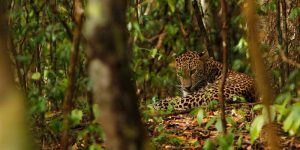
Q. How many leopards are in the Jhalana safari?
A. There are 40 plus leopards in Jhalana Leopard Safari.
Q. Are kids allowed in the Jhalana safari?
A. Yes, kids are allowed in Jhalana Safari, and there is no age restriction on that. Children aged 6 and above are considered adults and charged the same as adults.
Q. How many leopards are there in Jaipur?
A. There are 70 plus leopards in Jaipur in the multiple conservation reserve such as Jhalana, Amagarh, and Nahargarh.
Q.Jhalana Leopard safari contact number?
A.You can contact Jhalana Leopard Safari on +91 96642 05052

- Online Safari Booking
- How To Reach
- Terms & Conditions
- Best Time to Visit Jhalana
- JHALANA LEOPARD RESERVE
- Central road, near Hotel Hill View, Jaipur, Rajasthan | 302017
- +91 96642 05052
- contact@jhalanaleopardreserve.com

Start typing and press Enter to search
Safari animals: the story of leopards (and the best places to see them)
Dec 10, 2019 • 7 min read
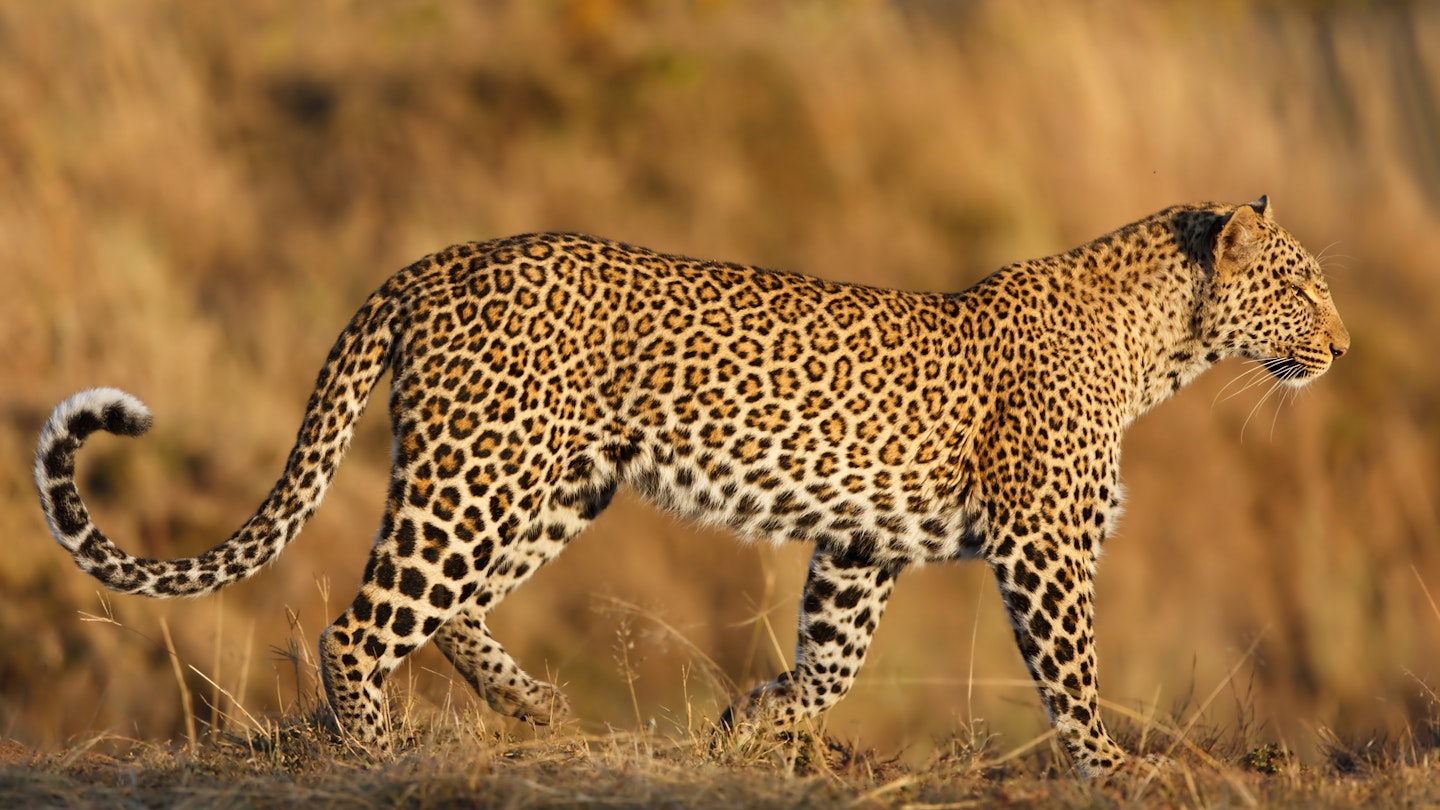
The rosettes on a leopard's coat mimic dappled shade on foliage and grasses © Maggy Meyer / Shutterstock
Leopards are among the most difficult of the big cats to see in the wilderness of Africa , which may be why they’re one of the great prizes of any safari. That, and the fact that this is one beautiful cat, the epitome of feline grace.
Leopards are masters of stealth and of camouflage, and many will watch you pass without you ever knowing that they’re there. And yet, these are the most adaptable and widespread of Africa’s cats. Read on for our snapshot of Africa’s most enigmatic big cat, and learn where best to see them.

Leopards: defined by their spots
Leopards are defined by their spots – if you see one up close, you’ll understand why their intensely beautiful coats have become a global fashion accessory, as beloved by African strongman leaders as by high-street fashionistas. The spots are actually rosettes, a circle of black spots surrounding an orange core. Leopards spend much of their time in trees or undergrowth, and these colours serve leopards well, allowing them to become one with the dappled foliage of leaves and grasses. In some forest regions, including the Aberdare Mountains in Kenya’s highlands, leopards can be almost entirely black, although sightings are extremely rare.
Read more: Where to go when: the best places to visit through 2020
Muscular and not much smaller than female lions, male leopards can reach just under three metres-long, including the tail, although around two metres is the norm. Leopards stand between 55cm- and 82cm-tall at the shoulder, and adult males can weigh as much as 90kg; females are smaller than the males – the largest female weighs in at just 42kg.

A solitary cat
There are few more solitary creatures in the animal kingdom than a male leopard. Except when mating, male leopards spend their lives alone, either roaming in search of a territory or holding fast to one that they will fight to protect. Females are similar – solitary by preference, territorial – except when they have cubs.
Read more: Where you should go on your first safari in Africa
After a three-month pregnancy, female leopards give birth to as few as one and as many as four cubs – between 50% and 90% of these cubs will die during their first year, falling prey to spotted hyenas, lions, baboons and wandering male leopards eager to mate with the mother. The cubs remain wholly dependent on their mothers for their first year of life. The mothers begin to wean the cubs after a couple of months, and by four months the cubs are only eating meat from animals killed by their mother. As the cubs grow, the mother will teach them the skills of hunting – for both mother and offspring, this is the most social time of a leopard’s life. When 18-months or two-years-old, a young leopard will either leave its mother or the mother will force it out to make its own way in the world and find its own territory.
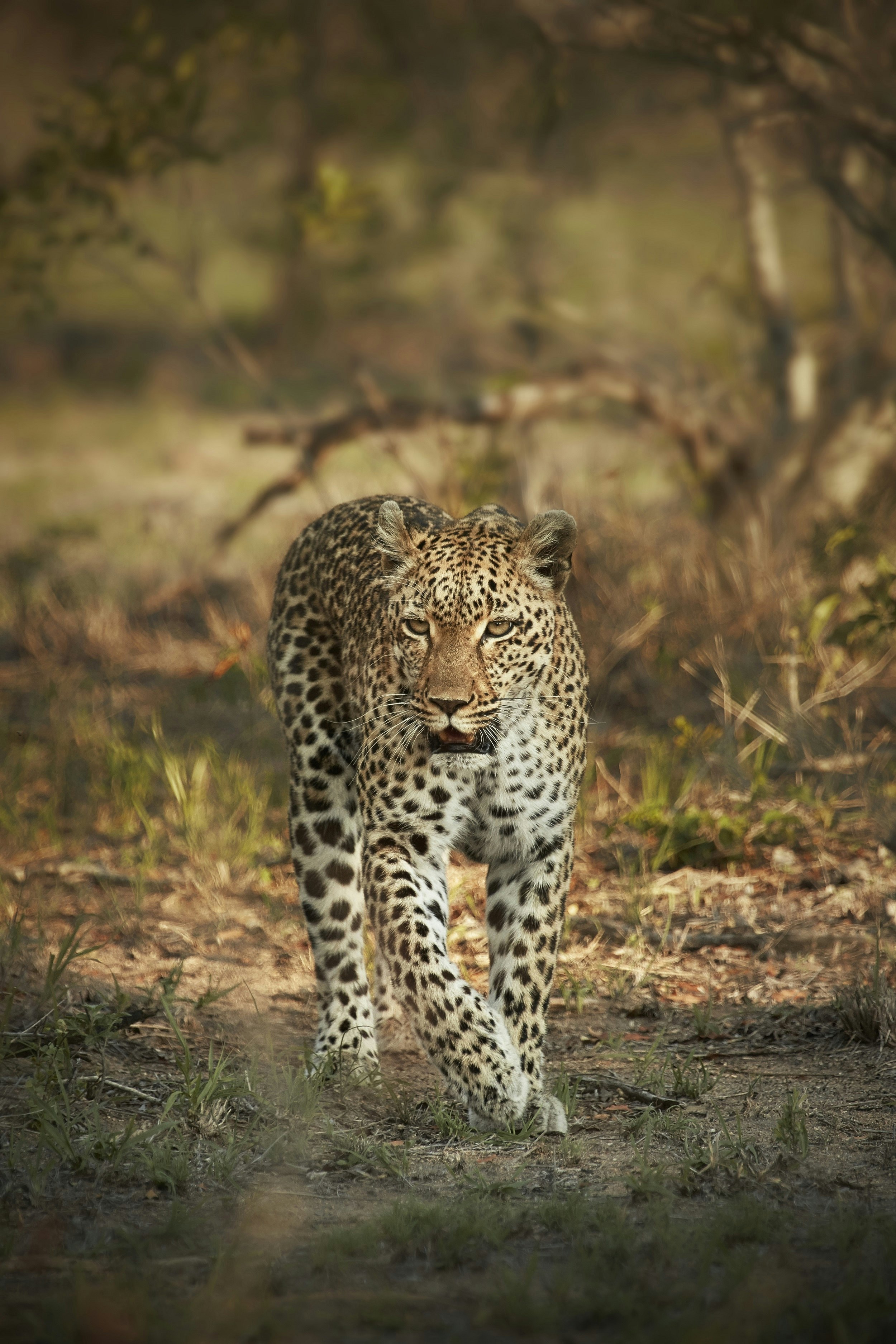
The skill of the ambush kill
One reason leopards have proved so adaptable is that they are willing to eat a wide range of prey – leopards have been recorded eating more than 200 different species. That said, a leopard has clear preferences: in Africa, impala, springbok and/or nyala routinely make up more than half of a leopard’s diet. They also commonly eat warthogs, zebras, wildebeest and steenboks. Anything larger than these species would ordinarily be too big for a lone leopard to kill and eat, although one exceptionally strong leopard was recorded bringing down a 900kg eland, the largest of all antelope species. Leopards will also kill cubs of rival predators, including lions, cheetahs and hyenas, while forest-dwelling leopards also eat primates.
Leopards frequently live in close proximity to human settlements, which means that leopards can come into conflict with people when the former kills domestic livestock and dogs. Attacks on people by leopards are rare.
Read more: A day on safari in Africa: what you can expect in camp and in the wild
Leopards are predominantly ambush hunters, usually after having stalked to within four to five metres of their prey. For all of their stealth and ability to approach prey without detection, leopards are successful only between 5% and 38.5% of the time when trying to make a kill. When they are successful, they kill prey by suffocation, clamping their jaws around the throat and/or muzzle of their kill. Because they are solitary, leopards have learned to defend their prey from more numerous lions and hyenas by carrying the carcass up into the branches of trees – leopards are the most skilled tree-climbers of all the big cats, even when hauling twice their own body weight with them – where few other species can follow.
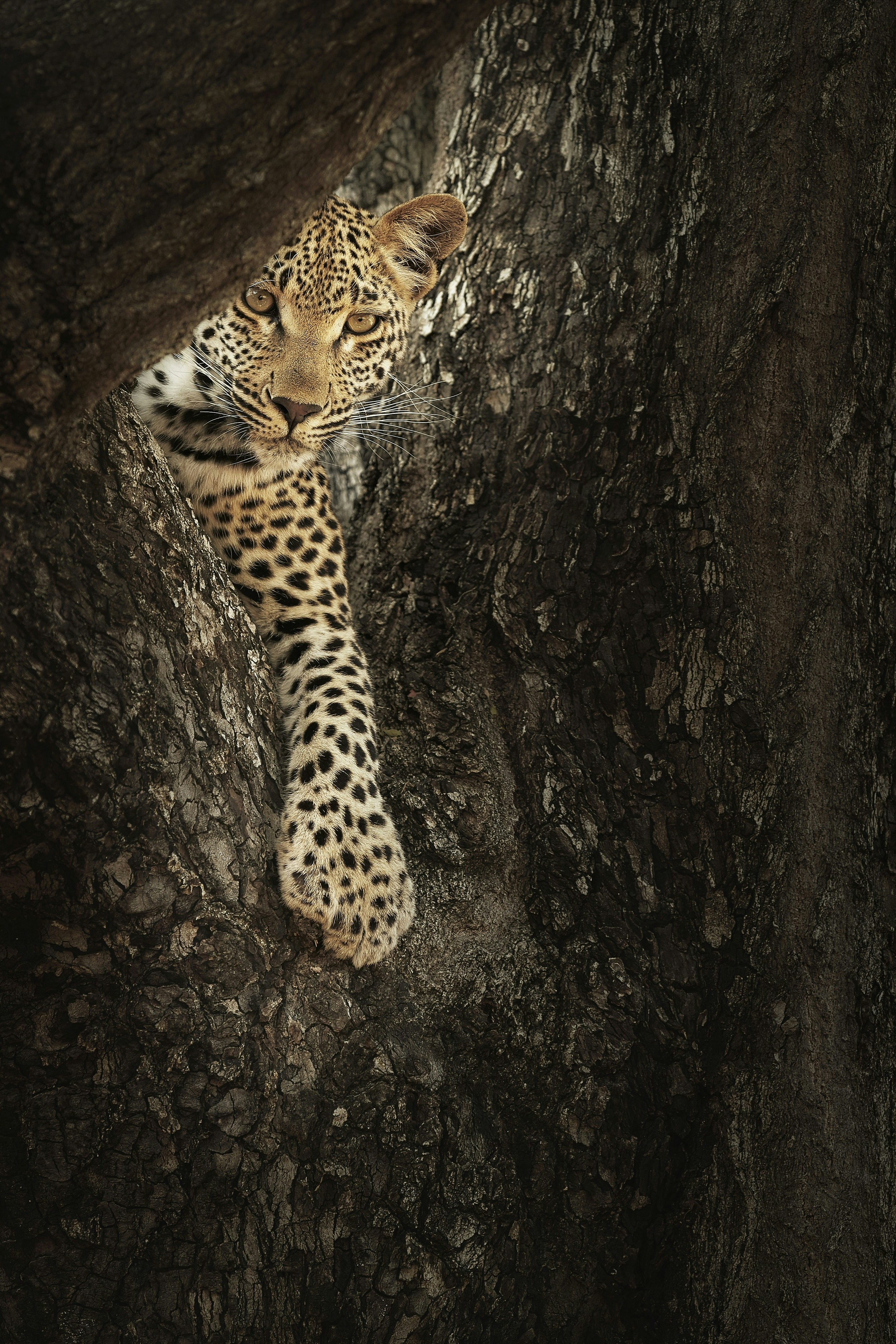
The leopard's preferred environment
In total, leopards are found in an estimated 62 countries. The stronghold of the African leopard is in East Africa and Southern Africa . The species has largely disappeared from North Africa and is rare in West Africa and Central Africa. Beyond Africa, there are important leopard populations in the Arabian Peninsula, Iran, India and Siberia; the Amur leopard is one of the most critically endangered sub-species of cats anywhere on earth.
Read more: Are you ready for a self-drive safari in Africa?
Leopards prefer woodlands – they need cover in order to stalk their prey – and are most often found in the trees and other foliage along riverbanks. In some places, like along the Seronera River in Tanzania’s Serengeti National Park where there are many leopards, a leopard’s territory will be quite small and extend along the river’s shoreline; the smallest recorded territory for a leopard is 5.6 sq km. In contrast, out in the arid Kalahari of Botswana and Namibia , where water and prey are scarce, a leopard’s home range can extend across 2750 sq km.
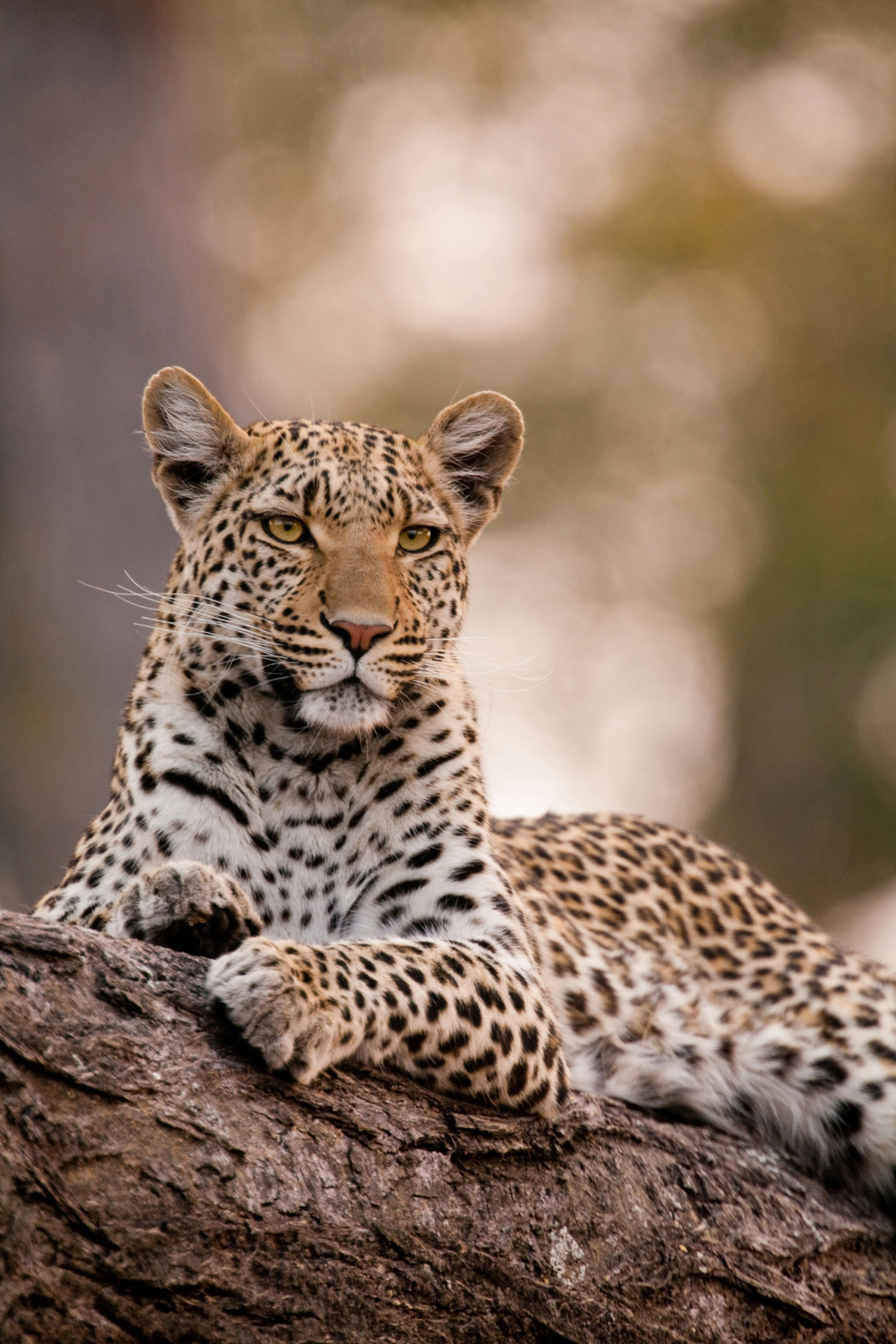
The best places to see leopards
Botswana: Botswana is excellent for spotting leopards, and a testament to the leopard’s adaptability – leopards are commonly seen in watery habitats like Chobe National Park and the Okavango Delta , but also in the desert-like Central Kalahari Game Reserve (CKGR). Kenya: Kenya ’s parks are prime leopard-watching areas. Leopards are present throughout the country, but sightings are most common in the Masai Mara National Reserve and the surrounding community-run conservancies , as well as Lake Nakuru and Tsavo West national parks. Malawi: An emerging safari destination, Malawi deserves special mention for Nyika National Park , home to more than 100 leopards and often spotted on night wildlife drives. Namibia: Plenty of leopards call Namibia home, but they’re generally more elusive than elsewhere. Try the private reserves such as Okonjima and Erindi. The floodlit waterholes in Etosha National Park are also decent shouts after dark. South Africa: Leopards are found across the country, but the northeast is best, especially in Kruger National Park and the surrounding reserves (such as Sabi Sand ). Elsewhere, try Mapungubwe National Park , Madikwe Game Reserve or Kgalagadi Transfrontier Park . Tanzania: Tanzania’s Serengeti is one of the best places on the planet for watching leopards. Sightings are also possible in Tarangire National Park , Selous Game Reserve , Katavi National Park and elsewhere. Zambia: The national parks of Kafue and South Luangwa Parks are known for their leopard sightings. Zimbabwe: The national parks of Mana Pools and Hwange have healthy leopard populations, though sightings are not as common as you might expect.
Leopards in peril?
The leopard’s strengths – the beauty of its coat, the adaptability that allows it to live across many different habitats and close to humans – also puts it in harm’s way. Leopards are much sought-after by trophy hunters. They are also often killed in retaliation for killing livestock. And they are also highly susceptible to the clearing of forests. The leopard is currently listed as Vulnerable by the International Union for the Conservation of Nature (IUCN).
Read more: Turning myth into reality: the white lions of Timbavati
Cat conservation NGO Panthera has implemented one particularly inventive measure that has been a critical conservation success story in South Africa and Zambia. In the former, a leopard-skin shawl or cape has long been the traditional attire for male members of the five-million-strong Zulu Shembe Church. But with leopards increasingly under threat, Panthera created, and then introduced, an imitation faux-leopard-skin alternative that has been embraced by the church’s leadership and most members. A similar approach in Barotseland, close to Liuwa Plain National Park in southwestern Zambia, has seen the Barotse Royal Establishment agree to replace real pelts with faux fur in their elaborate annual procession between their wet and dry season headquarters.
Related articles: Safari animals: the story of lions (and the best places to see them) Safari animals: the story of rhinos (and the best places to see them) Safari animals: the story of elephants (and the best places to see them) Safari animals: the story of cheetahs (and the best places to see them)
Explore related stories
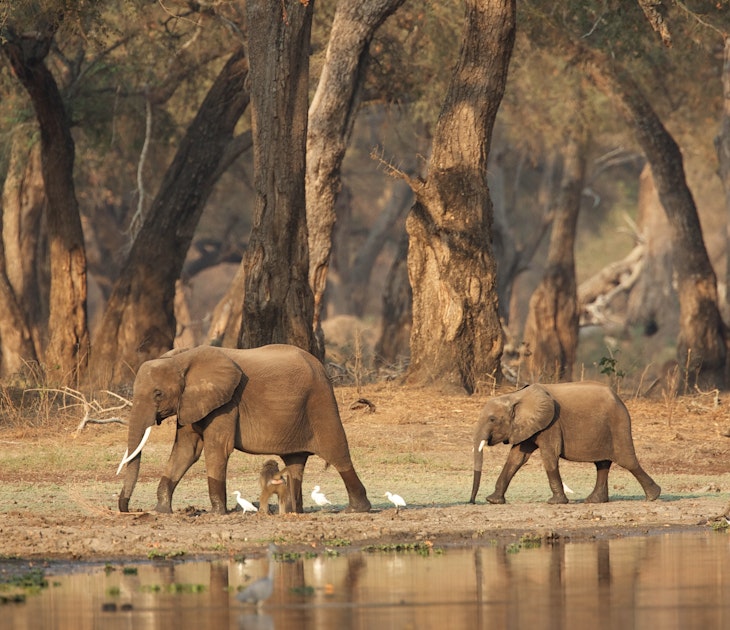
National Parks
Apr 25, 2024 • 7 min read
The African elephant is perhaps the most enduring symbol of nature’s grace and fragility. Here’s where to spot one (or many) in the wild.

Mar 20, 2024 • 8 min read

Mar 4, 2024 • 8 min read

Feb 20, 2024 • 17 min read
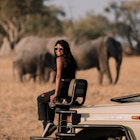
Jan 31, 2024 • 6 min read
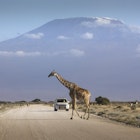
Dec 13, 2023 • 9 min read
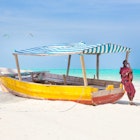
Nov 22, 2023 • 9 min read

Oct 29, 2023 • 12 min read
Oct 16, 2023 • 9 min read
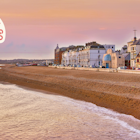
Aug 16, 2023 • 6 min read

JHALANA LEOPARD RESERVE

Jhalana Leopard Reserve, also known as the Jhalana Safari Park, is India’s first leopard reserve, located in Jaipur, Rajasthan. It is flanked by the Aravali hills, India’s oldest mountain range. In 2017, Jhalana was designated as a leopard reserve. The reserve covers an area of 20 square kilometres and is home to a diverse range of vegetation and fauna. The Jhalana Leopard Reserve now has almost 40 leopards and 5 cubs! Striped hyenas, Indian civets, desert cats, jungle cats, desert foxes, jackals, porcupines, jungle rats, monitor lizards, and mongooses, Sambar deer, spotted deer (chital), Blue Bull (Nilgai), and a variety of snakes can also be seen. You can also pay a visit to Shikaar Audi, the three-story hunting lodge of Jaipur’s royal family. It’s directly in the heart of the leopard reserve! It has an animal-spotting platform from which to watch the sunrise and sunset.
Safari in Jhalana first opened its doors to visitors in 2016. Jhalana Leopard Reserve is the finest site to see a leopard because it has a strong leopard population. Sometimes it happens within the first five minutes of entering the park. Leopards can be spotted during the day because they are not afraid of the presence of jeeps and humans in their natural environment. Jhalana Leopard Reserve quickly obtains popularity among wildlife aficionados and maintains a major position in global wildlife tourism. Nestled in the foothills of the gorgeous Aravali mountainous landscape, the park is a fantastic gateway to an adventure-filled holiday amidst raw nature, complete with unforgettable sightings of unique wild creatures.
FLORA & FAUNA IN JHALANA Leopard reserve:
The terrain of Jhalana Leopard Reserve is dominated by small Aravallis valleys and sheer cliffs of hills. The stunning natural surroundings and tranquillity of Jhalana’s woodland are wonderfully calming and a delight for the mind. The presence of such diverse wildlife in the metropolitan area distinguishes this property as a distinct and one-of-a-kind destination for nature aficionados.
Jhalana is classified as a dry deciduous forest. The forest is dry for most of the year because trees drop their leaves in the dry season and turn lush emeralds during the monsoons. Plants such as juliflora (Prosopis juliflora) and khejri dominate the Jhalana forest (Prosopis cineraria). The juliflora was originally planted to provide firewood for local villagers.Trees, on the other hand, do not foster the establishment of other grasslands and trees. The slanting valleys contain a greater diversity of local flora, including dhak (Butea monosperma), salar (Boswellia serrata), dhonk (Anogeissus pendula), and kumta (Acacia senegal).
Fauna In Jhalana Leopard Reserve
The gorgeous Leopard is obviously the main and most covered mammal of this Jhalana Leopard Reserve, which is also the top predator of the region and who comes first in the Jhalana forest reserve’s food chain. Although the leopard is believed to be a nocturnal, solitary, reclusive, and rare-sighted predator with masterful stealth hunting skills, leopards in Jhalana National Park are diurnal in nature, similar to tigers in Ranthambore and Sariska, making it one of the most frequented reserve forests by Leopard lovers.
Other big cats in the Jhalana Leopard Park include the Leopard, Indian civets, desert cats, and jungle cats. Other species that live in this forest include the Striped Hyena, desert foxes, jackals, porcupines, jungle rats, monitor lizards, mongooses, Sambar deer, spotted deer (chital), Blue Bull (Nilgai), and a variety of snakes.
Jhalana Leopard Reserve is home to several uncommon bird species, making it a birdwatcher’s dream. Jhalana National Park is home to a variety of birds, including the Indian Pitta, Dusky Eagle, Owl, Spotted Owlet, and others.
BEST TIME TO VISIT JHALANA SAFARI:
The Jhalana Leopard Reserve (India’s first leopard reserve) is open for safari trips for guests all year, even during the monsoon season, which runs from 1st January to 31st December each year, depending on admission dates. During the monsoon season, most of the country’s protected areas are closed, but here’s something to make up for it.
Though one may enjoy the Jhalana Leopard Safari and admire the beautiful Leopard at any time, November to April is considered the greatest time to visit Jhalana reserve because the weather is pleasant and nature is in full bloom around this time, emphasising the splendour of the reserve.
GETTING TO THE JHALANA LEOPARD RESERVE:
By Air: The Jaipur International Airport is about 6 kilometres from Jhalana Leopard Reserve, which is around a 15-minute drive from the airport. There are numerous domestic and international flights linking the pink city of Jaipur to places around India and overseas. To get to Jhalana Safari Park, take a taxi, cab, or bus from the Jaipur airport.
By Rail: The nearest rail station to the Jhalana Leopard Reserve is Jaipur Junction. This is around 11.7 kilometres away from the forest. The station is a popular tourist destination with direct trains from major Indian cities such as Udaipur, Delhi, and Mumbai. You can either hire a taxi or use the local bus to get from the station to Jhalana.
By Road: A direct road passes close to the Jhalana forest reserve, connecting it to cities such as Mumbai, Ahmedabad, Udaipur, Kota, and others, which are further connected to India’s major cities. So, if you choose a direct road trip from Delhi, Mumbai, or Udaipur, you will have no trouble reaching Jhalana. To get to Jhalana, you can either drive yourself or take the state bus.

- Ready-made safaris
- Experiences
- Special offers
- Accommodation
- Start planning
- Booking terms
- When to go on safari - month by month
- East or Southern Africa safari?
- Solo travellers
- Women on safari
- Accommodation types & luxury levels
- General tips & advice
- All stories
- Afrika Odyssey Expedition
- Photographer of the Year
- Read on our app
- 2024 entries
- 2024 details
- 2024 prizes
- 2024 entry form
- 2023 winners
- Collar a lion
- Save a pangolin
- Rules of engagement
- Job vacancies
- Ukuri - safari camps
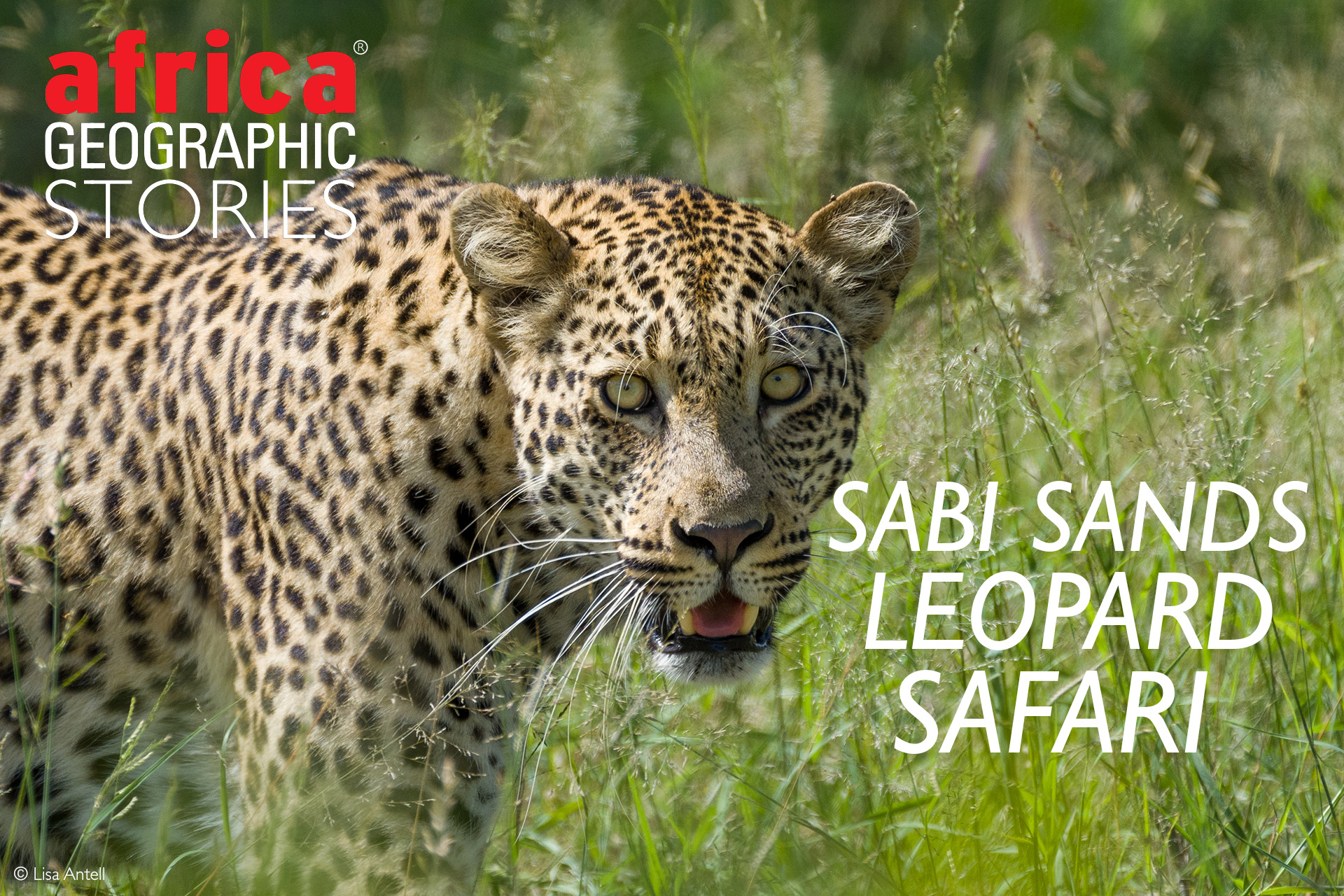
One-on-one with iconic big cats

Jamie Paterson
Tuesday, 7 March 2023
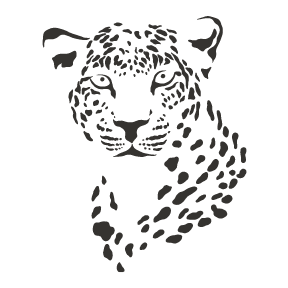
As I passed beneath the arches of Gowrie Gate into the Sabi Sands Game Reserve, I was hit by an unexpected wave of overwhelming nostalgia. The reserve had been my home on and off for nearly five years, and every second tree and termite mound brought back another precious memory. But nostalgia rapidly turned to excitement when I remembered my purpose for this visit – six days of glorious exploration lay ahead, a chance to share my love for the reserve and its inhabitants with my special group of guests partaking in this Africa Geographic leopard safari .
Summer loving
January can be a tricky month for Lowveld safaris. The vegetation is lush and dense, water is plentiful, and tracking is almost impossible in places. It is often hot and humid, prey species disperse, and predators either cover huge distances at night or are comatose in the shade during the day. Of course, there are rich compensations for these minor challenges: the glorious contrasts of green and gold, baby animals finding their feet around every corner and the cheerful call of the woodland kingfishers providing the crack of dawn trill. It is a magnificent time to visit the bushveld for genuine nature lovers. Fortunately, ours was a group of well-seasoned safari-goers with enough experience and insight to appreciate the majesty of the unfolding summer.
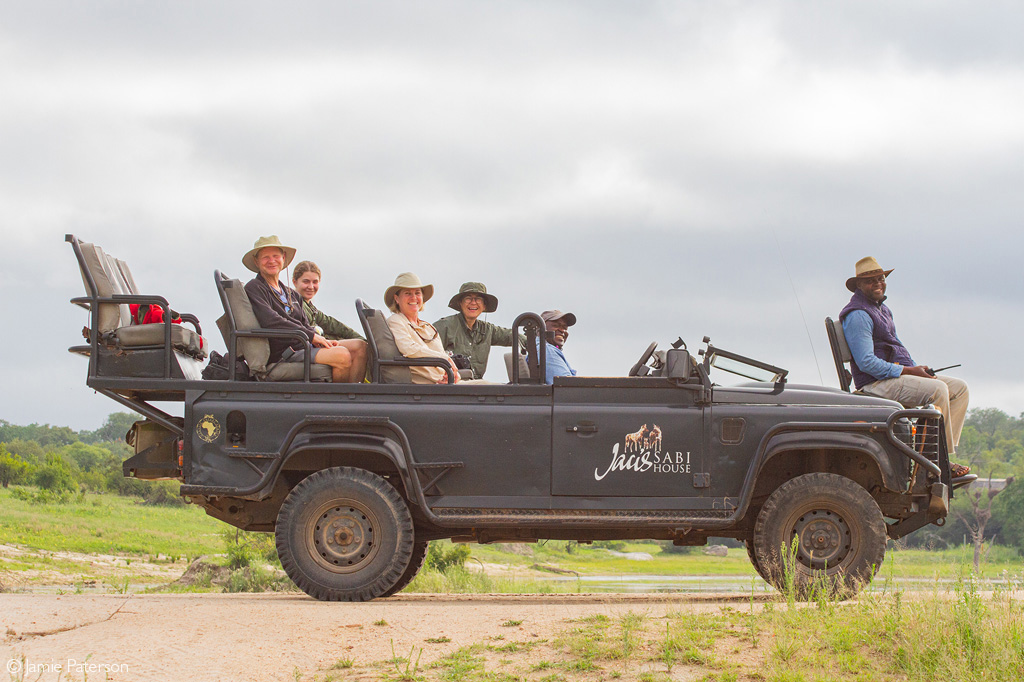
Our bushveld retreat
One of the highlights of this exclusive safari was having our lodge – Jaci’s Sabi House – all to ourselves. This meant we had complete control of the schedule. Want to enjoy the cool mornings? No problem, we just shifted our start time even earlier, departing at 5.00 am and returning only when the heat and hungry bellies finally chased us back to the refuge of the lodge. Similarly, afternoon drives started as early as the temperatures allowed. It was a pleasure to find myself in the company of like-minded individuals, and all thoughts of sundowners were abandoned in favour of letting the Sabi Sands work its magic. ( To start planning your African safari to Sabi Sands, click here ).
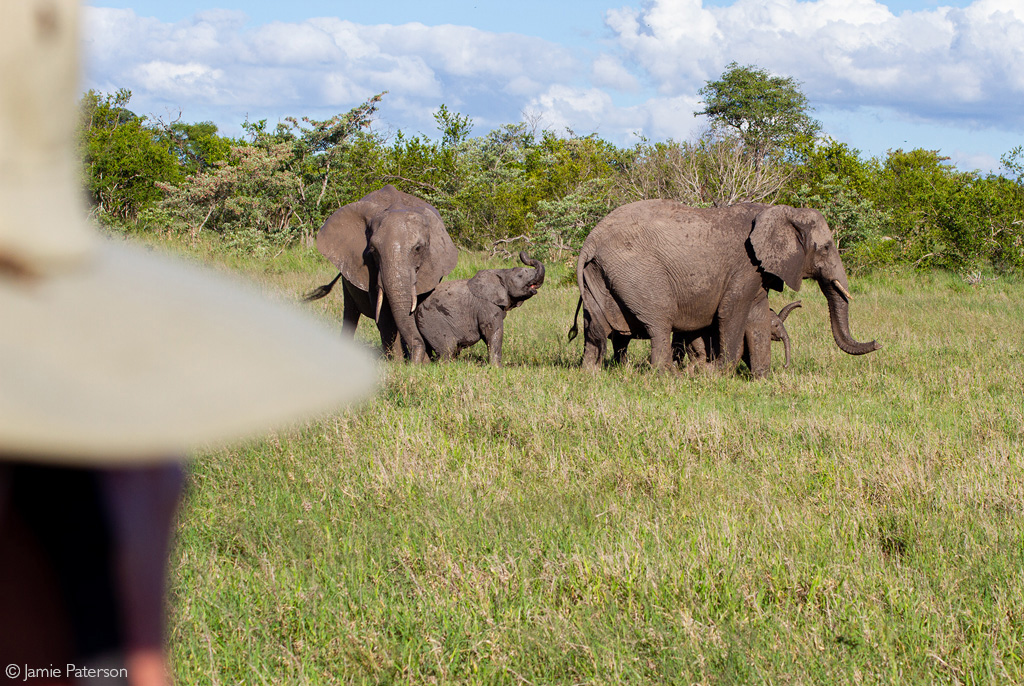
Why waste a moment of that potential? By the time we arrived at the lodge each night, the day’s excitement had made the already delicious three-course meals taste like heaven on earth. We ate beneath the star-spangled sky, serenaded by roaring lions and the iconic whoops of spotted hyenas.
We enjoyed our scrumptious brunches on the lodge deck overlooking the dam, and on one occasion, we were interrupted by the appearance of elephants at the water’s edge. In ones and twos, they emerged from the treeline, doing the excited elephant “water walk” and swinging their trunks in anticipation. Soon, the waterhole was surrounded, and elephants everywhere were drinking, playing or greeting each other with low rumbles. The last of the bacon was abandoned as we watched, mesmerised, before they melted back into the vegetation, leaving the very affronted family of Egyptian geese in peace.
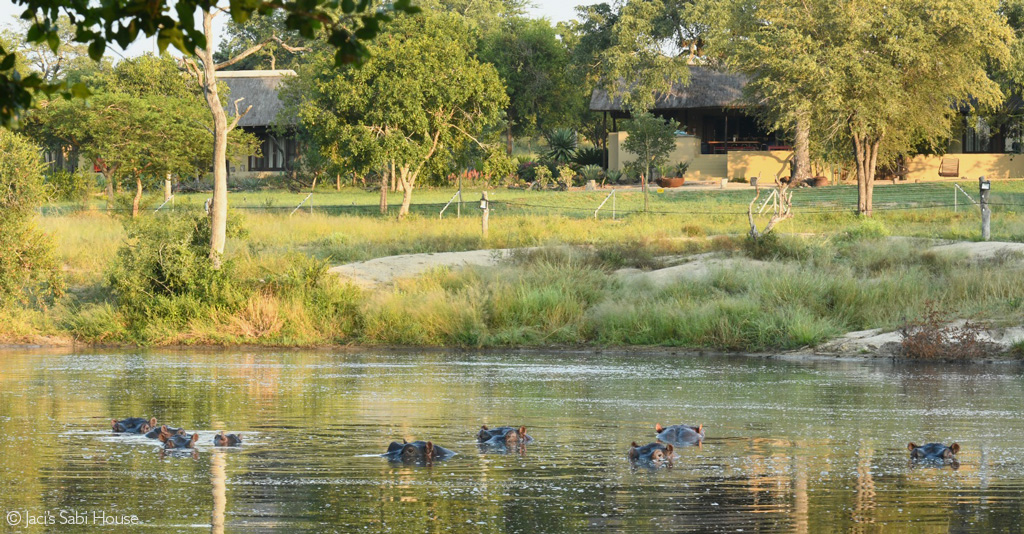
Leopard, leopard everywhere
Not for nothing is the Sabi Sands considered one of the leopard capitals of Africa, and it certainly lived up to its reputation for our leopard safari. We saw four different leopards over the six-day sojourn, and nearly every drive delivered a rosetted pelage for our indulgence. Yet the quality of these sightings, not the quantity, made the experience truly special. (It is worth mentioning this was due in part to the patience of our wonderful guests, who were happy to wait for the sleepy cats to move rather than barrel around from sighting to sighting.)
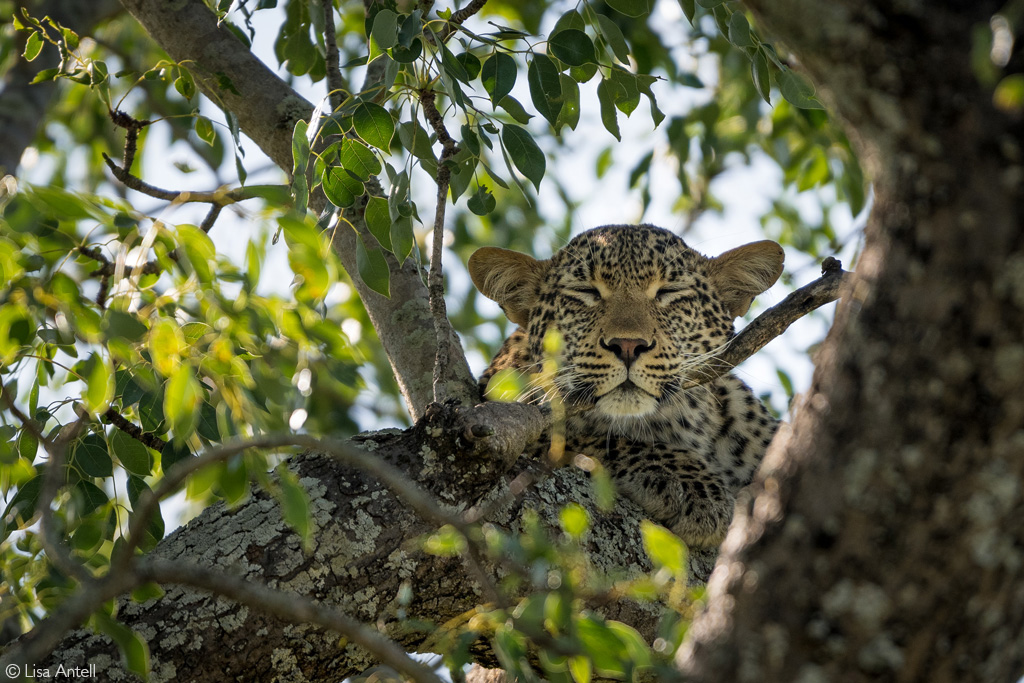
The stars of our trip were two young leopards – a female called Langa (“sun”) and a male known as Maribye (“rocks”). Both are on the cusp of maturity, with Langa set to carve out her territory and Maribye soon to begin the dangerous business of dispersal in search of a space of his own. From a viewing perspective, this is a wonderful age because young leopards are still full of energy and personality, capable predators but still learning the vital rules of survival.
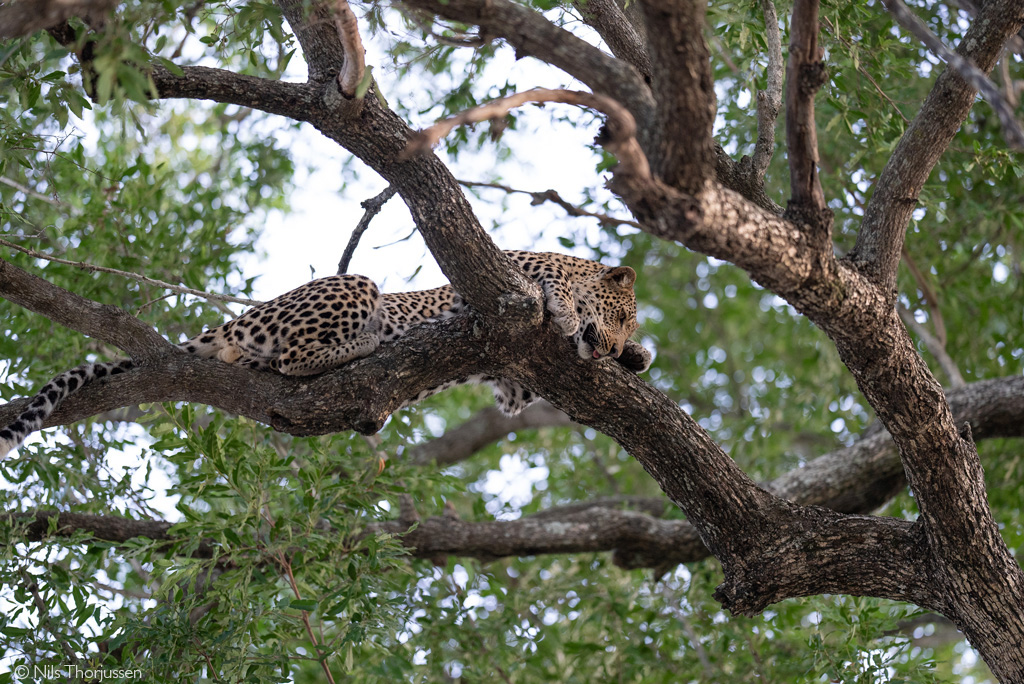
Langa impressed us with her poise, focus and uncanny ability to strike the perfect pose for our eager photographers. However, her dignity was decidedly ruffled when she was chased up a skinny apple-leaf tree by two very determined hyenas. We could hardly believe it when the situation repeated itself two days later, though she sought refuge in a rather uncomfortable-looking russet bushwillow this time around.

By contrast, Maribye was insouciant, bordering on comical. His belly was perpetually full (probably due to the seasonal influx of impala lambs), but he still entertained us by pouncing on emerging termite alates one evening. On another hot afternoon, we found him lying on the damp mud on the side of the road, presumably trying to cool off somewhat. He then led us into a nearby drainage line where he had stashed his latest meal. Following this, he treated everyone to a display of the renowned leopard agility by leaping from bough to bough of a jackalberry tree towering over our vehicle.
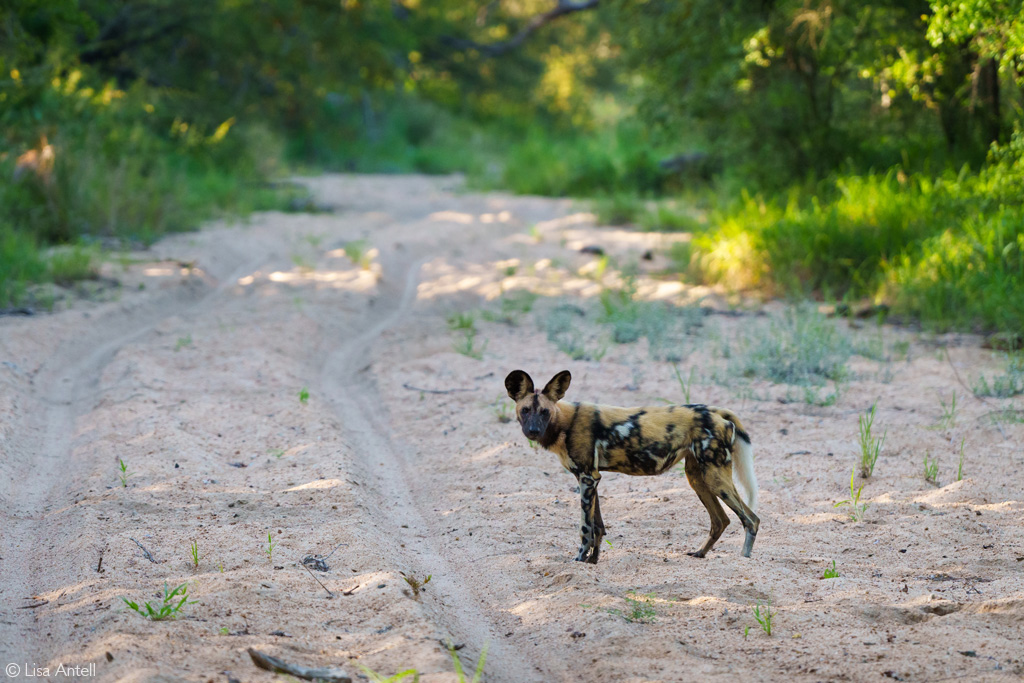
In between our leopard sightings, we were diverted by several performances from the supporting cast of Sabi Sand mammals, birds, insects and reptiles. These included a zebra stallion chasing a pack of wild dogs (known affectionately as the “6-pack”) and several brand-new elephant calves, still pink about the ears. Other highlights were a herd of mud-splattered buffalo, one determined fork-tailed drongo intent on scalping a distinctly miffed brown snake eagle, and two directionally confused teenage elephants.
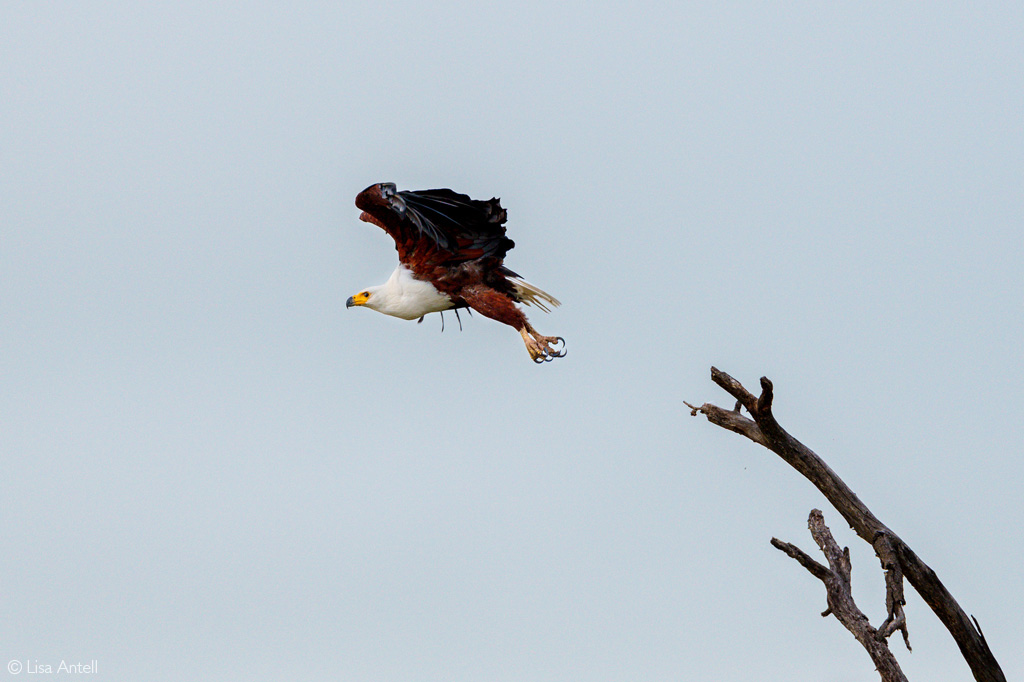
Walking on sunshine
And just like that, the six days of our leopard safari that had stretched ahead of me when I arrived were over and done, and it was time to bid my guests farewell. This I did with no small degree of regret – time spent in the bushveld is always a great bonding experience, and the long hours driving through the reserve had provided countless opportunities for fascinating conversation. In the heart of Sabi Sands, we spoke about everything from conservation and politics to the state of the world and our hopes for the future. But for the most part, we were light-hearted and cheerful, entertained by our in-jokes and sheltered by the bubble of the wilderness around us, the perfect soul-refresher ahead of a new year.
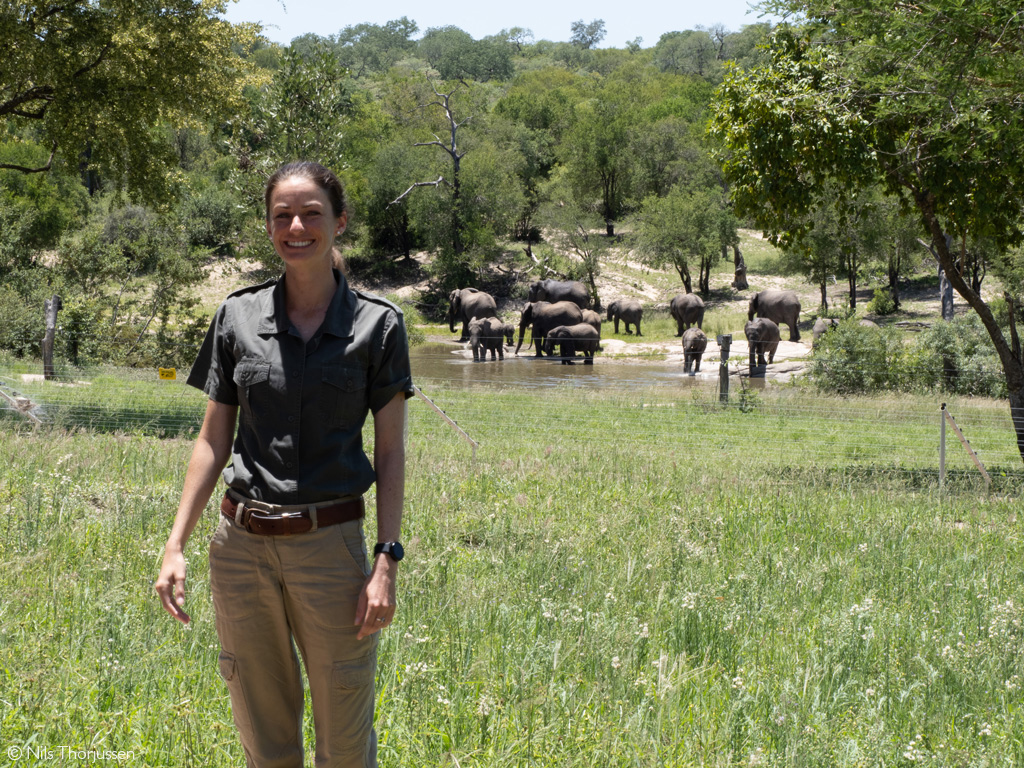
HOW TO GET THE MOST OUT OF AFRICA GEOGRAPHIC:
- Travel with us . Travel in Africa is about knowing when and where to go, and with whom. A few weeks too early / late and a few kilometres off course and you could miss the greatest show on Earth. And wouldn’t that be a pity? Browse our ready-made packages or answer a few questions to start planning your dream safari .
- Subscribe to our FREE newsletter / download our FREE app to enjoy the following benefits.
- Plan your safaris in remote parks protected by African Parks via our sister company https://ukuri.travel/ - safari camps for responsible travellers

Friend's Email Address
Your Email Address

SAFARI AVAILABLE

Leopard is king here
Jhalana leopard safari.
Jhalana Leopard Reserve is India’s first Leopard Reserve located in Jaipur with area of more than 20 square km. It is also called land of leopard due to residence of more than 30 leopards in small forest area. In 2018 it was developed as Leopard Safari Jaipur and operation of Leopard Safari Jhalana started for tourist. Jhalana Leopard Safari has witnessed millions of memories with various leopards including Pooja, Aarti, Sultan, Rana and others as well .
ECOTOURISM SPOT
Great diversity at jhalana leopard reserve.
Since 2018, Leopards and other wild animals have shown their presence in the Jhalana Leopard Safari Jaipur and gave adventurous and happy memories in past years. Every visit of yours will be full of enjoyment with sighting of Leopard kind.
Leopards at Jhalana Wildlife safari never disappointed in any safari visit. Most of the time you get encountered with presence of Leopards here.
You might be witnessed to the needy hunting by leopards where they get their kill in front of tourists also. Sometimes it just happens within the 5 minutes of entering the Jhalana Leopard Reserve. The friendly nature and well developed ecosystem have created chaos in the wildlifers and tourist. If you like to be surrounded by trees and wildlife attraction, Leopard Safari Jhalana has become a hotspot in wildlife safari segment.

Flora and Fauna of L eopard Safari Jaipur
Most amazing wildlife safari spot in jaipur with great attaction of leopards..
It is located in the Jhalana forest block which is a dry deciduous forest. Most of the vegetation lost their leaves once in a year and get green in the rainy season. You get the amazing scenes of wildlife safari on adventurous tracks between mountains and plateaus in Leopard Safari Jaipur .
Jhalana Safari Park lies in foothill foothills of aravallis in Jaipur. Jhalana safari can be visited by jeep safari at nominal entry fee. So you must plan your visit to Jhalana safari park at nominal safari price. Sometimes people call it National Park but as of now Jhalana Safari is a leopard reserve only protected by State Government.
Leopard Safari Jhalana: At A Glance
Avifauna at leopard safari jhalana.
132 species recordred including Indian Pitta, Asian Paradise Fly catchers, Eurasian and Indian rollar Birds, Serpent Eagle, Sparrow hawk, honey buzzards
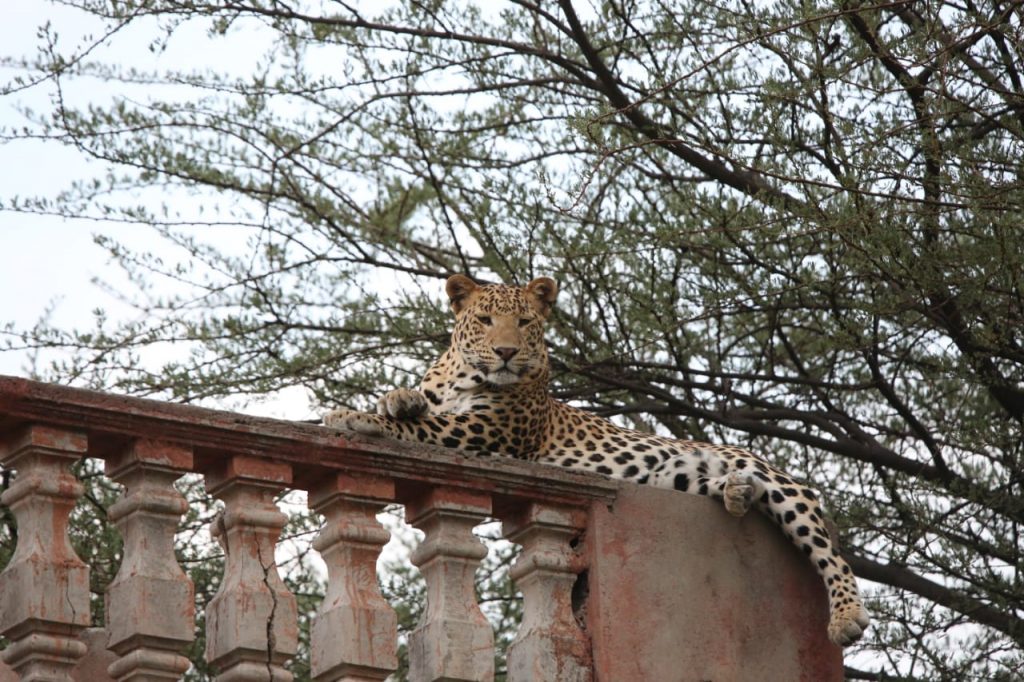
Reptiles at Jhalana Leopard Reserve
20 Species of reptiles have been observed in Jhalana Leopard Reserve so for. Various reserch activities are going on to find the reptiles diversity in Jhalana forest area.
Flora at Jhalana Leopard Safari Jaipur
220 species have been recorded including Dhonk. Salar, Kumta, Tortlis, Khejri, Goya Kher Juliflora in Jhalana Leopard Reserve. Jhalana Leopard Safari is perfect destination to see the flora diversity. You can visit Jhalana Leopard Reserve for research and ecotourism purpose.
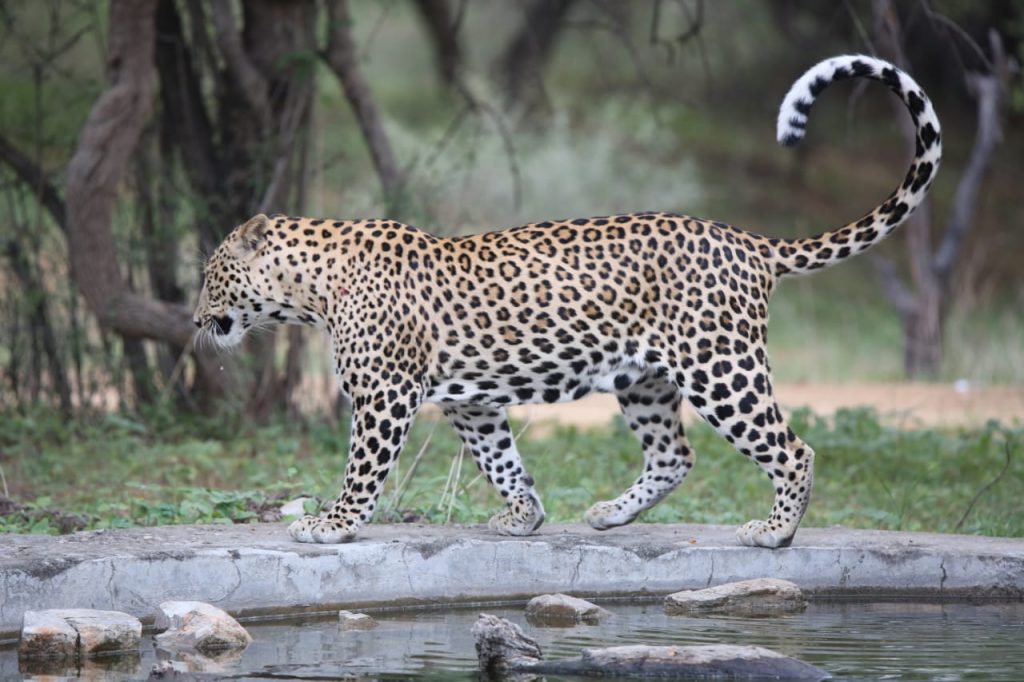
Fauna at Jhalana Leopard Safari Park
32 Species including Leopard, Striped hyenas, desert fox, rusty cat, blue bulls, jungle cats, jackals, spotted deers are found in Leopard Safari Jhalana. Rare Rusty-spotted Cat Prionailurus rubiginosus was spotted in Leopard Safari Jhalana.
FREQUENTLY ASKED QUESTION
Where is Jhalana Leopard Safari ?
It is located in Jaipur (India) and has been developed as centre of ecotourism in past four years with the great efforts of forest department and wildlifers.
Is it a Leopard Reserve?
Jhalana Leopard Safari is an activity of Wildlife tourism in Jhalana Leopard Reserve. It is a first Leopard Project of India which was started in 2018 as Wildlide Safari point.
Physiographically where is Jhalana Safari Park located ?
Physio-graphically Jhalana Leopard Reserve is located in the Aravalis. With Forest administrative perspective it is covered in Jhalana Amagarh Forest block in Kho hills.
How can I do Jhalana Leopard Safari Booking ?
Jhalana Leopard Safari Booking is an easy process where you do not need to arrange things rigorously. Just plan your visit and we can assist you in Leopard Safari Jaipur visit.
What is timing of Leopard Safari Jaipur?
The Jhalana Leopard Safari timing varies according to season and periodically reviewed by Forest Department. But it is always in evening and morning shifts.
How to reach Jhalana Leopard Safari Jaipur ?
Jhalana Leopard Safari is along the Jaipur city and it is just 7 km away from Jaipur International Airport and 13km far from Jaipur Railway Station. Contact us for more info.
Is Jhalana Safari Park differs from Jhalana Leopard Safari ?
No. Jhalana Safari Park and Jhalana Leopard Safari both are same. Sometimes people use Jhalana Safari Park but the destination same.
Jhalana Leopard Safari Park
Contact form.
This website uses cookies to ensure you get the best experience on our website. Learn more
- Australian Dollars
- British Pounds
- Canadian Dollars
- New Zealand Dollars
- South African Rands
- Swiss Francs
- U.S. Dollars
Talk to an expert +44 203 405 6666 Lines now closed
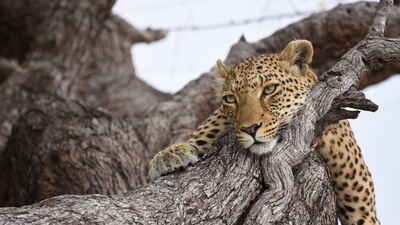
Where to see Leopard in South Africa
The leopard is not uncommon. The most numerous of Africa’s big cats, it occurs in all major conservation areas and across most habitats. Nonetheless, its grace and elusiveness make it a unique safari drawcard.
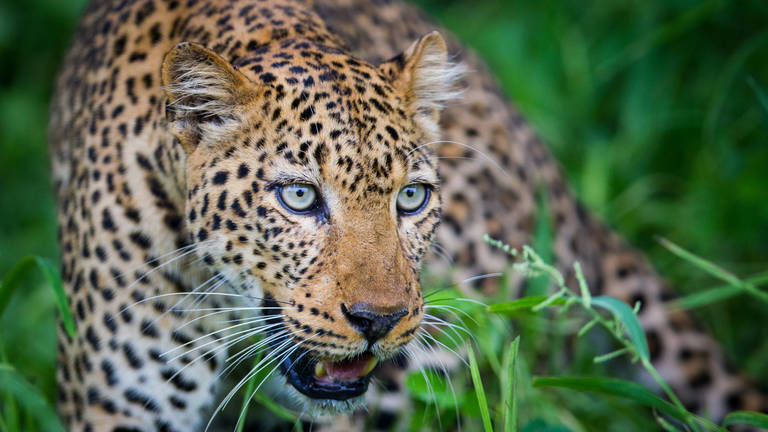
Quick facts about Leopard
The leopard is a powerful and versatile predator that varies greatly in size and habitat. It uses stealth and camouflage to ambush prey at close quarters, typically taking small to medium-sized antelopes, though everything from birds to young giraffes may make the menu. Most active at night, leopards are agile climbers and unique among big cats in using trees as ‘larders’ for prey. Key identification features include a long tail, usually curled at the white tip, and beautiful rosette patterning (unlike a cheetah’s solid spots). Males are around one-third larger than females, with a larger head and more jowly throat. Adults are largely solitary, though cubs may remain with their mothers for 18 months.
Range countries worldwide
Highest recorded altitude
Max. tail length
12–17 years
Average lifespan
The top camps for seeing leopard in South Africa
Based on 12 reports by our travellers since Jun 2018, visitors at these camps in South Africa have the best chances of sighting leopard.
Best chances to see
Good chances to see
Some sightings
No sightings yet
Top 10 camps for leopard
% of travellers who saw leopard
Where to see leopards in Africa
Leopards are widespread but good at hiding. By day, you may spy one in a tree. At dawn and dusk, they become more active on the ground. Night drives can be productive.
Top tips for viewing leopards
Leopards occur everywhere from mountains to rainforests but are best seen in savannah and woodland habitats. Highly territorial, they often show up repeatedly in the same area. Classic leopard country includes river loops with large trees and rocky kopjes surrounded by open bush. Even if invisible, a leopard’s presence is often betrayed by the alarm calls of prey, such as baboons, impala or even guinea-fowl. Be patient and you might get lucky. Certain locations, such as Zambia’s Luangwa Valley, are famed for leopard sightings. But all major conservation areas, from the Kalahari to the Maasai Mara , offer a chance, especially where guides know the habitats and whereabouts of individual cats. Night drives increase the chances further. Listen out after dark for the distinctive deep territorial call, which resembles the rasp of a saw.
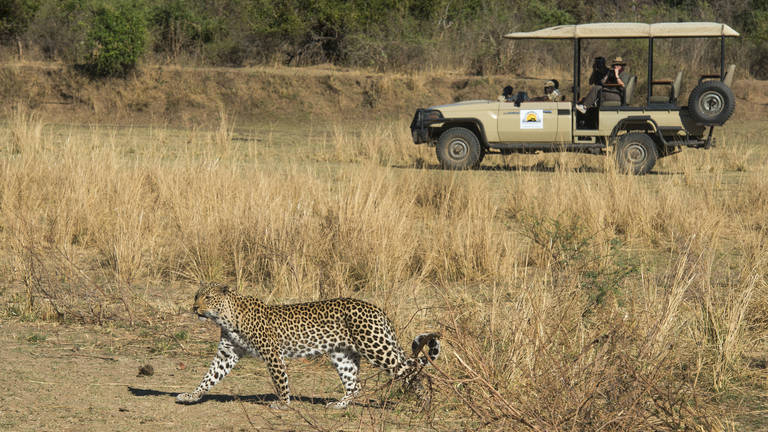
Our best South Africa holidays for leopard sightings
Based on our travellers' reports, these ideas for South Africa safaris are likely to give the best leopard sightings
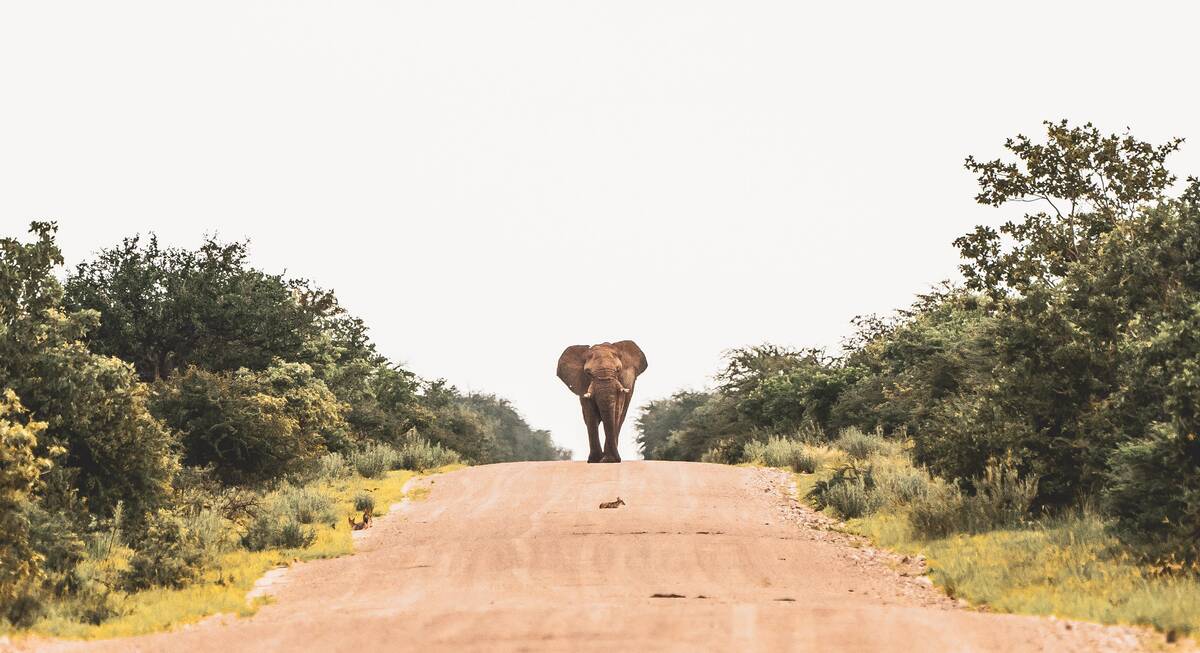
Black Wildebeest Self-drive Safari
19 days • 10 locations CAPE TOWN AIRPORT TO WINDHOEK AIRPORT
Journey from South Africa’s cosmopolitan Cape Town to central Namibia’s Okonjima Nature Reserve during this self-driven safari. The route passes through a stunning variety of landscapes, offering access to this beautiful continent’s rich diversity.
US$3,220 - US$3,700 per person
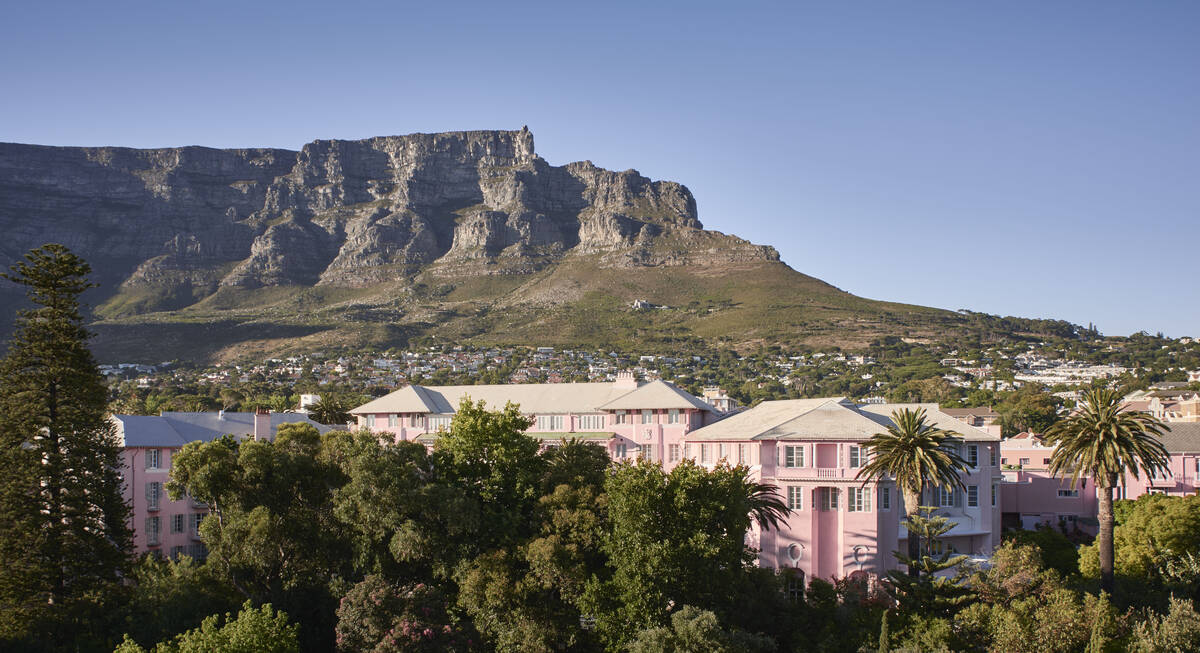
The Highlights of Africa
17 days • 7 locations CAPE TOWN AIRPORT TO KIGALI AIRPORT
An epic adventure taking in some of Africa’s most incredible sights and wildlife experiences, from Cape Town to the Okavango Delta, Victoria Falls, the Maasai Mara and an encounter with mountain gorillas.
US$14,340 - US$18,200 per person
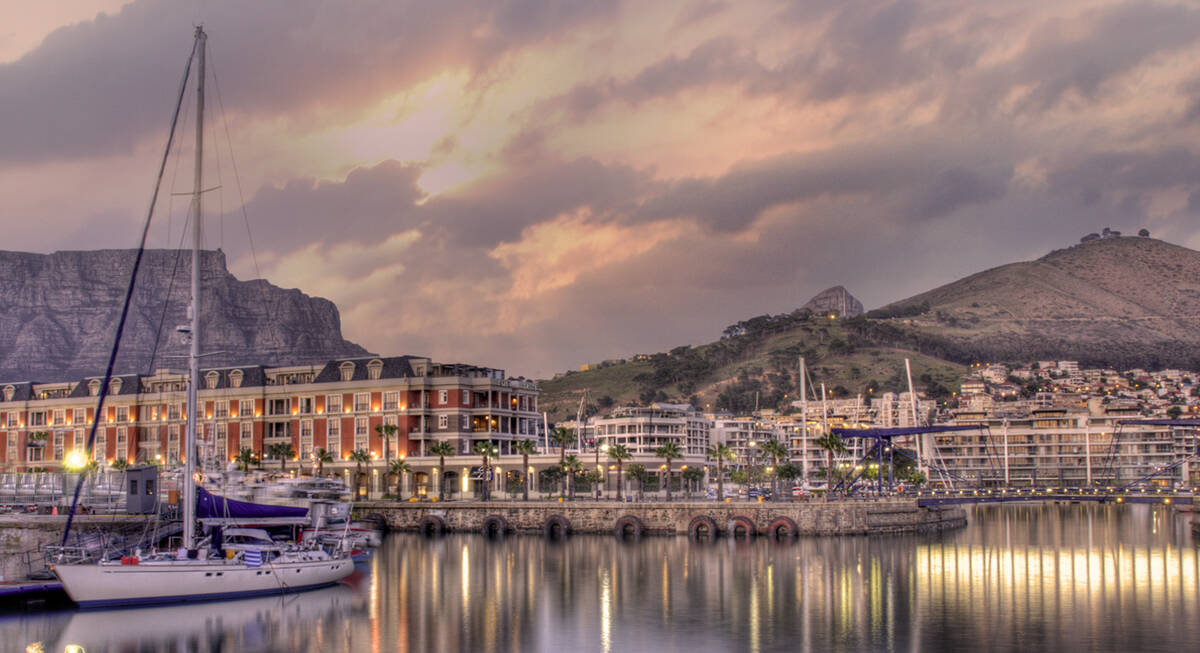
Leopard Safari
13 days • 4 locations VICTORIA FALLS AIRPORT TO CAPE TOWN AIRPORT
Victoria Falls, Botswana and Cape Town – a classic southern African itinerary combining luxury, wilderness, safari and culture. We can't think of a better way to spend two weeks.
US$12,130 - US$17,900 per person
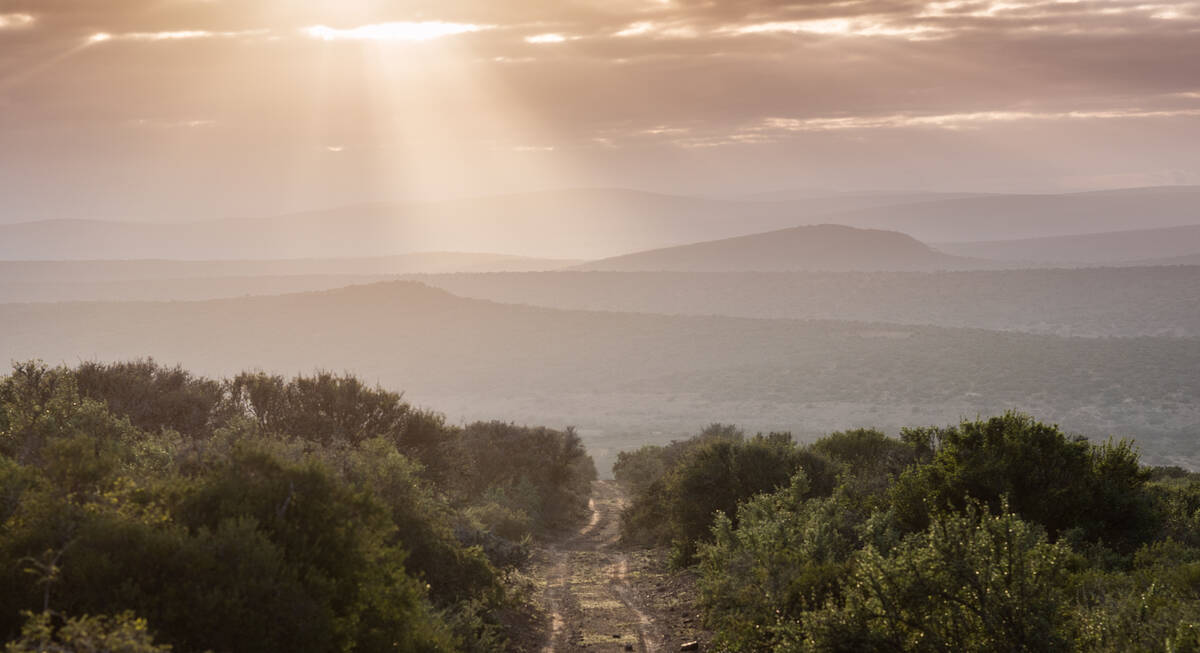
Kwandwe Self-drive Safari
3 days • 1 locations PORT ELIZABETH AIRPORT TO PORT ELIZABETH AIRPORT
An elegantly stylish lodge that is well suited to families, Kwandwe offers a range of safari activities and the chance to sight all of the "Big 5" during exploration of the Eastern Cape.
US$2,770 - US$4,310 per person
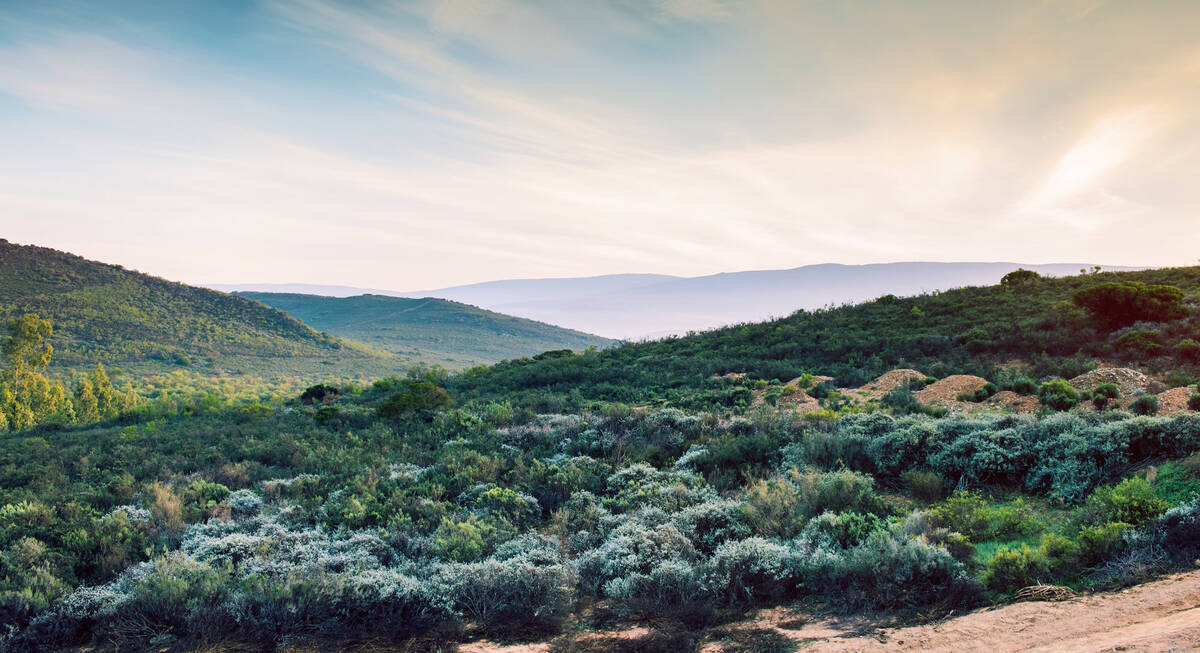
Cape Genet Self-drive Safari
20 days • 8 locations CAPE TOWN AIRPORT TO CAPE TOWN AIRPORT
Enjoy fine-dining in Cape Town, whale-watching in Hermanus, and a range of walking and water-based activities throughout De Hoop’s Nature Reserve, the Klein Karoo and Plettenberg. This relaxed self-driven safari concludes with stays in The Winelands and Namaqualand.
US$2,890 - US$3,810 per person
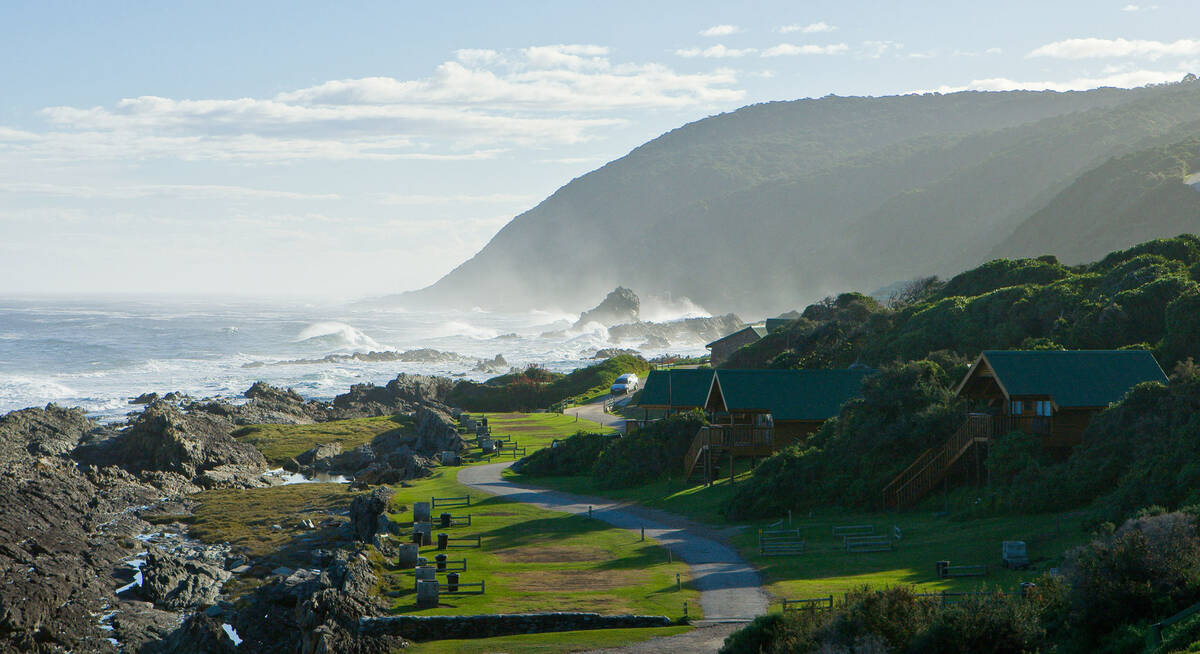
Bontebok Self-drive Safari
12 days • 5 locations CAPE TOWN AIRPORT TO PORT ELIZABETH AIRPORT
This varied and great-value self-drive trip visits Cape Town, the Winelands and diverse sections of the Garden Route, staying at great places with real local character. It’s ideal for active couples and families who want to explore the Cape’s stunning locations.
US$1,380 - US$1,690 per person
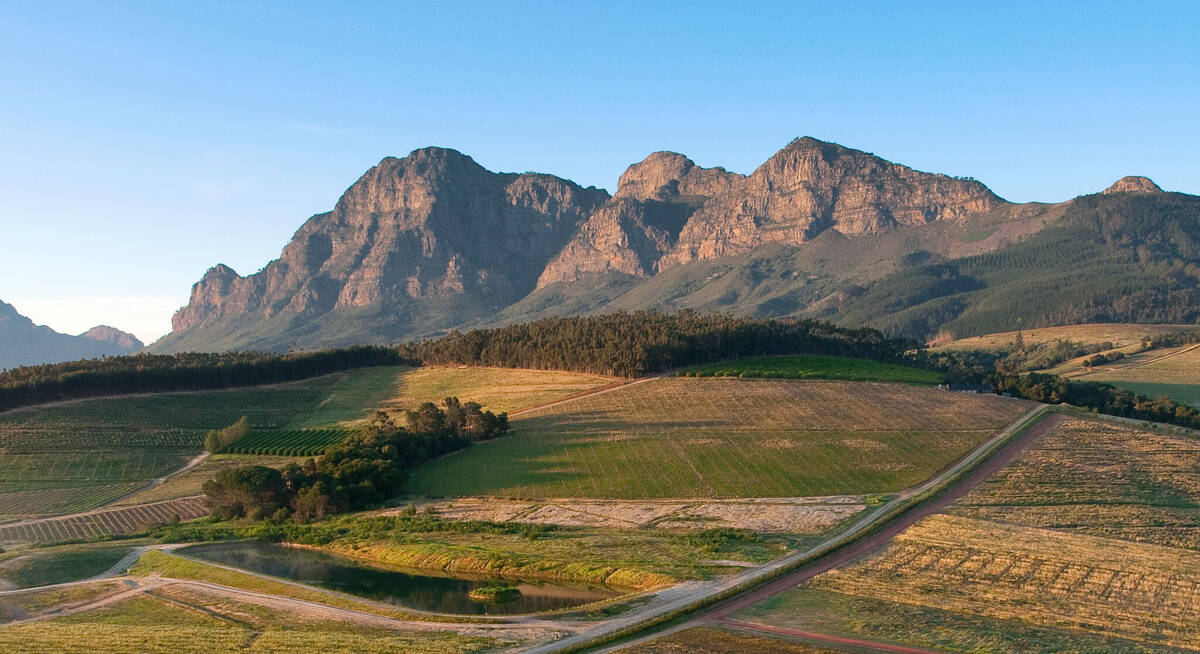
Cape Mountain Zebra Self-drive Safari
12 days • 4 locations CAPE TOWN AIRPORT TO CAPE TOWN AIRPORT
Fine dining, luxurious accommodation and a wide of range of leisurely activities make this a superbly comfortable self-driven safari. Visit the cosmopolitan Cape Town, tranquil coastal retreats, stylish wine farms and spectacularly peaceful nature reserves.
US$3,580 - US$6,640 per person
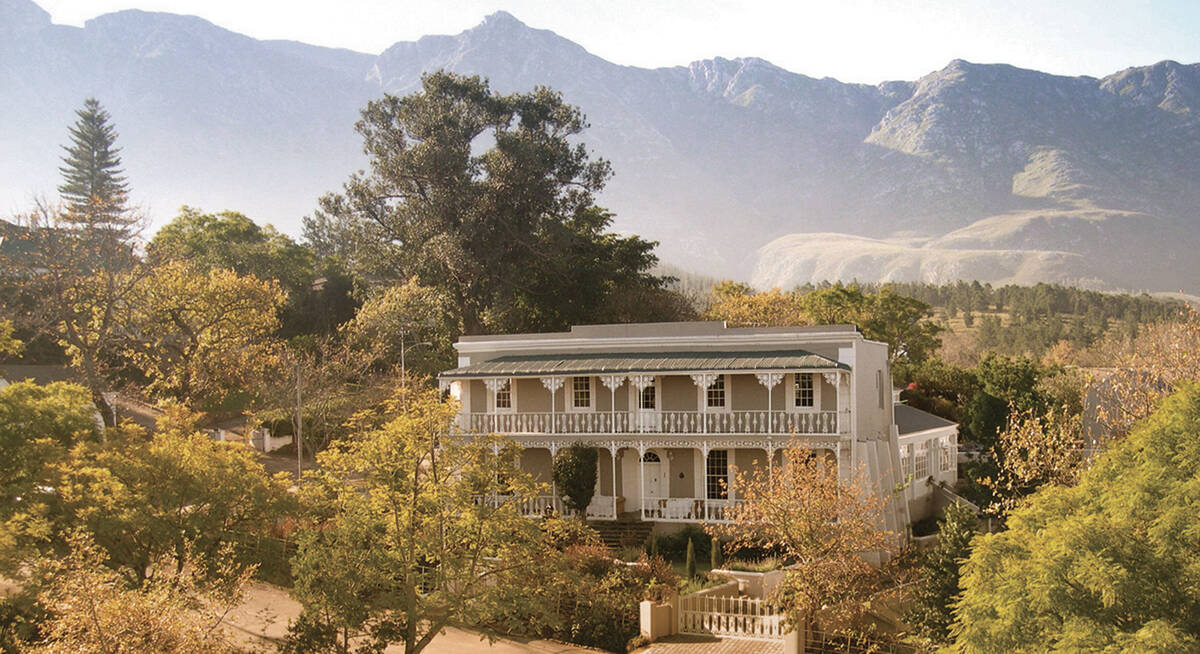
Waterbuck self-drive
12 days • 6 locations CAPE TOWN AIRPORT TO PORT ELIZABETH AIRPORT
A classic Cape and Garden Route self-drive taken at a leisurely pace and staying in charming boutique hotels. Great food and wine paired with spectacular scenery and an exciting array of activities.
US$2,360 - US$2,940 per person
View all holidays to South Africa
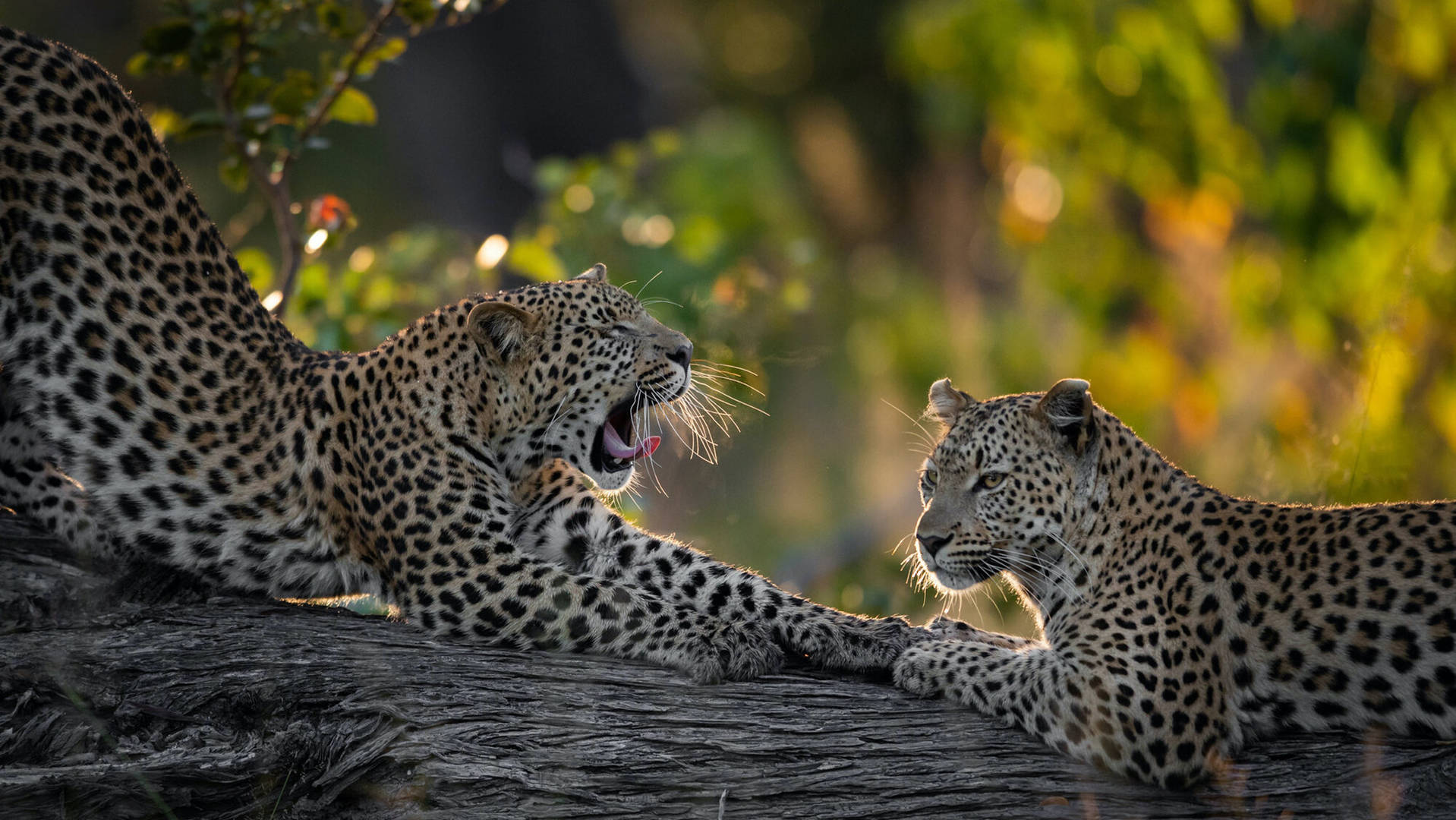
More information about leopard in our other destinations
Click here for detailed information about leopard in other countries, including the places for sighting leopard.
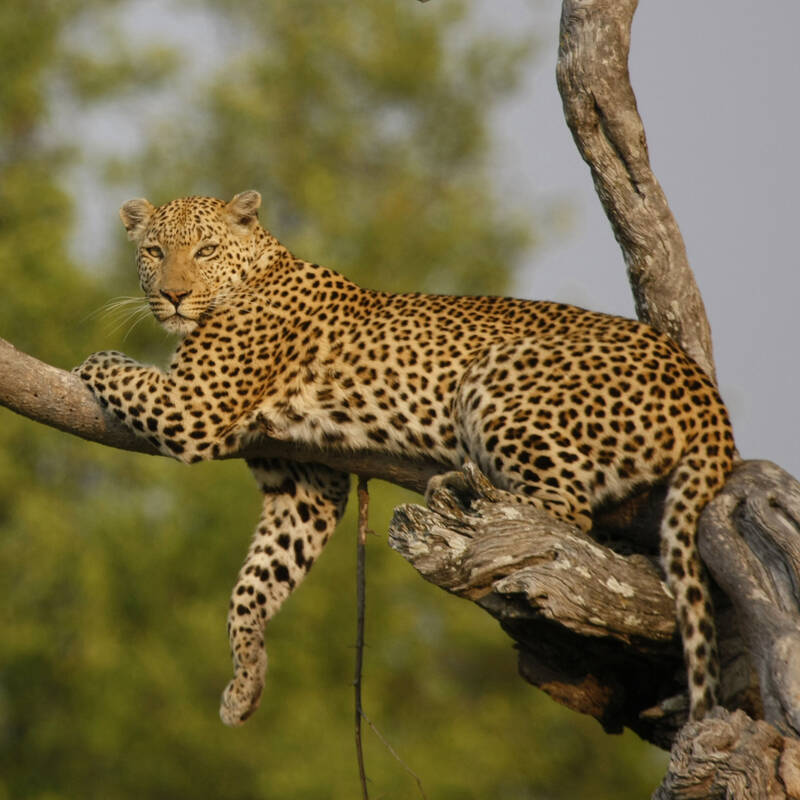
Login to Expert Africa
Sign in with password
Sign in with email link
New to Expert Africa? Create an account
Forgotten your details?
It's free & quick to set up
- Save your wish-list
- Send us an enquiry
- Pay online for your trip
- Subscribe to our newsletter
- Give us feedback on your trip
- Full site benefits of the site
Need some help? Talk to our team
Leopards of Jaipur - Jhalana & Amagarh

Image by Geoff Brooks, Unsplash
On May 22, 2022, on World Biodiversity Day, the Amagarh Leopard Reserve opened in the Pink City of India - Jaipur, Rajasthan. With this establishment, Jaipur becomes home to two Leopard Safari. The combination of this newly announced Amagarh Leopard Reserve and the Jhalana Leopard Reserve has made Jaipur the very first city in World to have two leopard reserves.
Amagarh Leopard Reserve
Jhalana Leopard Reserve

Image by Mirza Yawar Baig, Unsplash
Jhalana Leopard Safari of Jaipur
In 2017, Jhalana became the first place in India where visitors can enjoy a jungle safari to see a leopard in its natural habitat. Spread over
nearly 25 square km, the Jahalana Safari Park lies in the heart of the Aravalli Hills. This park is situated in the Malviya Industrial Area in the city of Jaipur.
The Jhalana Safari Park is home to a wide variety of animals and plants, including the elusive leopard. There are approximately 30 to 35 leopards and five cubs in this reserve. Sighting hunts are common in this safari park. In the heart of the reserve, there is a royal hunting lodge, the three-story Shikaar Audhi. It's also a great spot to watch the sunrise and sunset. Many from nearby cities come to visit for a one-day trip.
Jhalana Leopard Reserve's Flora and Fauna
Due to its deciduous nature, Jhalana's forest remains largely arid for the majority of the year. During the dry season, most of the leaves turn brown and fall off the trees. The park is dominated by juliflora and khejri. Flowers like Dhak, Dhonk, Kumta, and Salar are also common in this region.
Leopards aren't the only animals in this park. Desert foxes, jackals, Blue Bull (Nilgai), Hyena, monitor lizards, mongooses, spotted deer, and jungle cats are also available in this park. Leopards can even be seen during the daytime as they have become habituated to the presence of jeeps and humans.
As a birdwatcher's paradise, Jhalana National Park is a must-visit place for photographers and bird enthusiasts. The park is home to a variety of bird species, including the Dusky Eagle, Spotted Owlet, Indian Pitta, and Owl.
Best Time to visit The Jhalana Leopard Reserve of Jaipur
Because of its exotic beauty and commitment to conservation tourists visit this place all year round. The Jhalana Leopard Reserve is open throughout the year. From November through April, the weather is pleasant, and the months of March through May are ideal for viewing the Jhalana Leopard in its natural habitat.
Jhalana Safari of Jaipur
In the morning and the evening, safaris are available. You can hire a six-passenger jeep. For Photographers, a half-day safari can also be arranged. One needs to pay permit charges, the entrance fee, guide fee vehicle fee and additional fees for the professional guide and drive facility. An online booking facility is available, these bookings are non-transferable and the booking cannot be cancelled. Id proof submitted at the time of booking is the same passenger is asked for proof at the park.
Reaching Jhalana, Jaipur Leopard Reserve
Jhalana Leopard Reserve can be accessed by rail, road, or air.
Jhalana Leopard Reserve is around 6 km from Jaipur International Airport.
The Jhalana Leopard Reserve is a distance of 12 km from the Jaipur Junction Railway. The Jhalana Leopard Reserve contains highways that connect to important towns like Ahmedabad, Mumbai, Kota, Udaipur etc.

Image by Yash Parashar, Unsplash
Amagarh Leopard Reserve of Jaipur
The Amagarh Leopard Reserve covers an area of 16 square kilometres in east Jaipur and is located in the Aravalli mountain range. The reserve is currently home to around 15 to 20 leopards, along with many other wild animals, birds and plant species. Besides all these attractions, tourists can also enjoy the sight of Amagarh fort, Amabamata temple, Galta temple, and Raghunath fort, which are also part of the park.
Amagarh Leopard Reserve's Flora and Fauna
The Amagarh forest region is classified as a tropical mixed or monsoon forest type. The common plants which grow in the park include Dhonk, Goya Khair, Kumtha, Salar, Totalis, etc. They are mainly spotted on the steep slopes of the Khejri hill in the plain, sandy areas of the park. Although the Amagarh Reserve is mainly popular for its leopards, there are also a lot of other carnivorous as well as herbivorous animals dwelling in the shelters of the reserve. The list includes Asian deer, hyenas, jackals, wild cats, foxes, civet cats, monkeys, rabbits, sambhar, nilgai, etc. The Amagarh Leopard Reserve Park has around 250 different bird species. Tourists will be able to spot bulbuls, babblers, doves, mynas, peacocks, parakeets, partridges, robins, shikra, woodpeckers, and other birds. Besides these, migratory birds such as the Eurasian cuckoos, golden orioles, northern goshawks, Orient scops owls, Pallid scops owls, pittas, pied cuckoos, and paradise flycatchers can be seen occasionally in this forest reserve.
Best Time to visit The Amagarh Leopard Reserve of Jaipur
Leopard sightings are common throughout the year in both Jaipur's reserve parks, Jhalana and Amagarh. However, the months of November to April are considered to be the best for visiting these leopard reserve parks. The winter months, from November to February, are ideal for birdwatchers and photographers due to the pleasantly cool weather.

Amagarh Safari of Jaipur
Safari drives are available in two main shifts: the morning shift and the evening shift. The morning shift is from 5.30 a.m. to 8 a.m. and the evening shift is from 4.45 p.m. to 7.15 p.m. Two major and one minor safari track have been created within the forest area to provide the best leopard safari experience in Amagarh Park. Around ten safari jeeps with a capacity of 120 passengers will be available daily. Tourists will enter and exit the park through a gate near Galata's Vipassana core zone.
Reaching Amagarh, Jaipur Leopard Reserve
The Amagarh Leopard Reserve can be reached by car, taxi, or bus from Jaipur (25 to 30 min from city). You can also take a train to Amagarh station. You can also use airports Jaipur airport (18 Km), which have direct flights to all major Indian cities.
- Wild Adventure
Related Posts
Jawai, the Leopard Hills of India
Responsible Wildlife Tourist - The Duties
Ranthambore National Park Travel Guide
How to Become Wildlife Photographer

How to Select Best Zone for Tiger Safari

6 Simple Ways To Make Your Resort Sustainable

Bhubaneswar Through the Eyes of a Local

Top Tourist Attractions of Andaman & Nicobar Islands

Advertisement Section
Personalised Sustainable Organic Cotton Clothes

You May Also Like

Birds of Jaldapara National Park

Learn about Indian Rock Python

Top Bird Sanctuaries in India

Tadoba Tiger Reserve National Park Travel Guide

Top 10 Romantic Honeymoon Destinations in India

Learn about Gharial

Jhalana Leopard Safari Jaipur – India’s 1st Leopard Reserve (Best Time to Visit, Tickets, Timings)
Overview: Jhalana Leopard Reserve is a great offbeat tourist place in Jaipur for adventure lovers. Jhalana Reserve Forest has approximately 40 leopards. Seeing these big cats hunting and playing is a thrilling experience.
Jhalana Leopard Safari covers an area of approximately 22 square km. It was opened to the public in 2017.
If you are in Pink City then you must visit Jhalana Safari Park – The first leopard reserve of India. Jhalana Leopard Safari is a paradise for nature enthusiasts and those seeking a thrilling adventure within the city limits of Jaipur.
There are many tour & travel operators besides the official one through which you can book your leopard safari tour in Jaipur. However I would suggest you to book Jhalana safari tickets via the official website to save money. (You can find the official website link below in the article.)
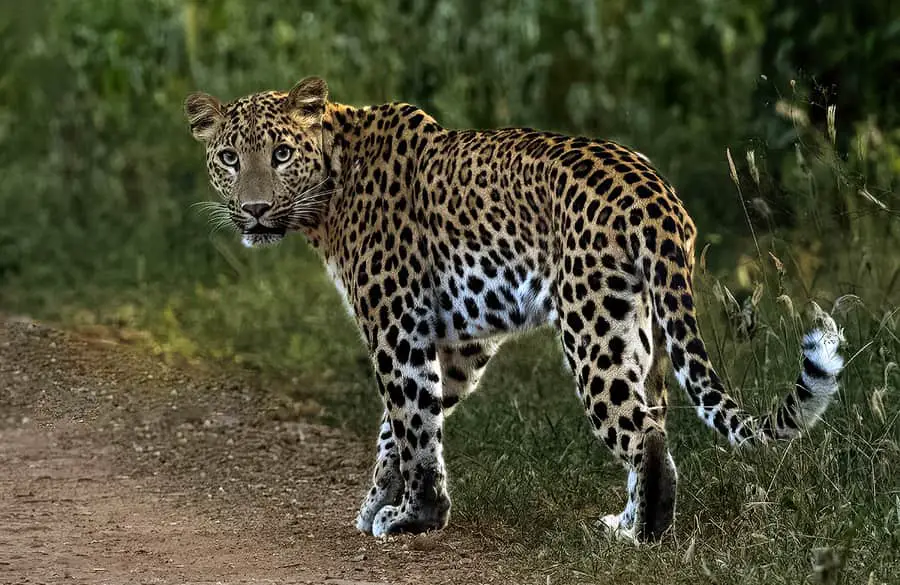
Jhalana Leopard Safari – Best Time to Visit
Jhalana Leopard Reserve is open throughout the year. Yes, you heard it right. Other leopard safari parks such as Jawai Leopard Reserve , and Kumbhalgarh Reserve are closed during monsoon. But Jhalana Leopard Reserve welcomes visitors year-round (Jan-Dec), with adjusted timings for each season.
The November-April window offers pleasant weather and vibrant landscapes, making it the best time to visit Jhalana Leopard Reserve.
Upto 60% OFF on Hotels ➛ Check Deal
Jhalana Leopard Safari Timings
Jhalana leopard timings are different in summer and winter season. See the below table to find the detailed safari timings. You can book your leopard safari slot according to this schedule.
Jhalana Leopard Safari Tour Timing – Summer Season
Jhalana Leopard Safari Tour Timing – Winter Season
🙏 Sorry to disturb you in the middle.
95% of our website visitors read our article, get the benefit and leave, without saying thanks. I am sure you are not one them. Show your love. Share the article with your friends!
Jhalana Leopard Safari Half Day Tour Timing
Jhalana Forest – Animals & Birds
In Jhalana Safari Park you can see many wild animals like jackals, jungle rats, monitor lizards, Sambar deer, spotted deer, Nilgai, and mongooses. You can also spot many beautiful birds like peacocks, sparrows, owls, woodpeckers in Jhalana forest.
Read: Tourism Fairs in Rajasthan
Jhalana Leopard Safari – Ticket Price
Leopard Safaris are offered by jeeps only. You can either book the whole gypsy or share it with other visitors.
There are 10 jeeps available in advance quota for each shift. You can book the gypsy maximum 90 days in advance. Children below 6 years can visit Jhalana free of cost.
Avoid last minute hassle: It is recommended to reach 30 minutes before at the Jhalana Leopard Reserve gate to collect the boarding pass.
Ticket price for Jhalana safari is shown in the table below.
Note: Maximum 5 persons (excluding the driver) are allowed in one gypsy.
Check: Jaipur Travel
Shikaar Audi – The Royal Hunting Lodge
There is a three-story hunting lodge called “Shikaar Audi” in Jhalana Leopard Reserve. It belongs to Jaipur’s royal family. In this building you can witness a picturesque sunrise and sunset at the animal spotting platform. There are better chances for leopard spotting from this lodge.
You can also visit this lodge but you need to buy the ticket separately.
Read: Shocking Facts About Bhangarh Fort
Jhalana Leopard Safari Ticket Booking – Official Website
To book the Jhalana safari for leopard sighting you can visit the official booking website of the forest department of Rajasthan .
The website will show you a list of wildlife reserves and national parks. Choose Jhalana Leopard reserve and book your slot by filling in the necessary details. You need an SSO ID to log in and book the leopard safari slot. If you don’t have one, you can create it easily.
Upto 70% Discount on OYO Hotel ➛ Search
Jhalana Leopard Safari Distance – How to Reach
Jhalana leopard safari is located in the heart of Jaipur. It is well connected to the airport, railway station and bus station. You can easily reach here by any transport of your choice.
Below are the distances of Jhalana from Jaipur’s major passenger transport hubs.
✈️ 25% OFF on Flights ➛ Search
Read: Best Tourist Places in Udaipur
Jhalana Leopard Safari Distance From Major Cities
Jhalana Leopard Safari Park is easily reachable via road transport from major cities in Rajasthan and surrounding states. Below is the list of some cities and their distance from Jhalana reserve.
Read: Hidden Gem Bundi
Jhalana Leopard Safari – Accommodations
Jhalana safari park is located in a well connected area of Jaipur. There are many 3-star to 5-star hotels available near Jhalana forest. You can book your accommodation according to the amenities offered and budget that fits your pocket.
For budget travelers and students there are many dorm rooms and hostels also available in Jaipur.
Flat 25% OFF on Hotels – Deal
Celebrities Love – The Jhalana Jungle
Many celebrities have visited this beautiful leopard safari in the past. Actor Randeep Hooda, Ritesh Deshmukh, Genelia D’souza, and Ex-cricketer Sachin Tendulkar recently visited the Jhalana leopard reserve & experienced the rich wildlife of Jaipur.
Show Your Love by Sharing:
- X (Twitter)

Related Posts
Discover the beautiful tourist destinations within 150 km of jaipur, jawahar circle park jaipur – free entry, things to do, hopup jaipur – india’s best family fun park (timing, price, photos).

- Safari Booking
- Activity Booking
- +91 9610 460 985
- +91 9351 359 115
- [email protected]
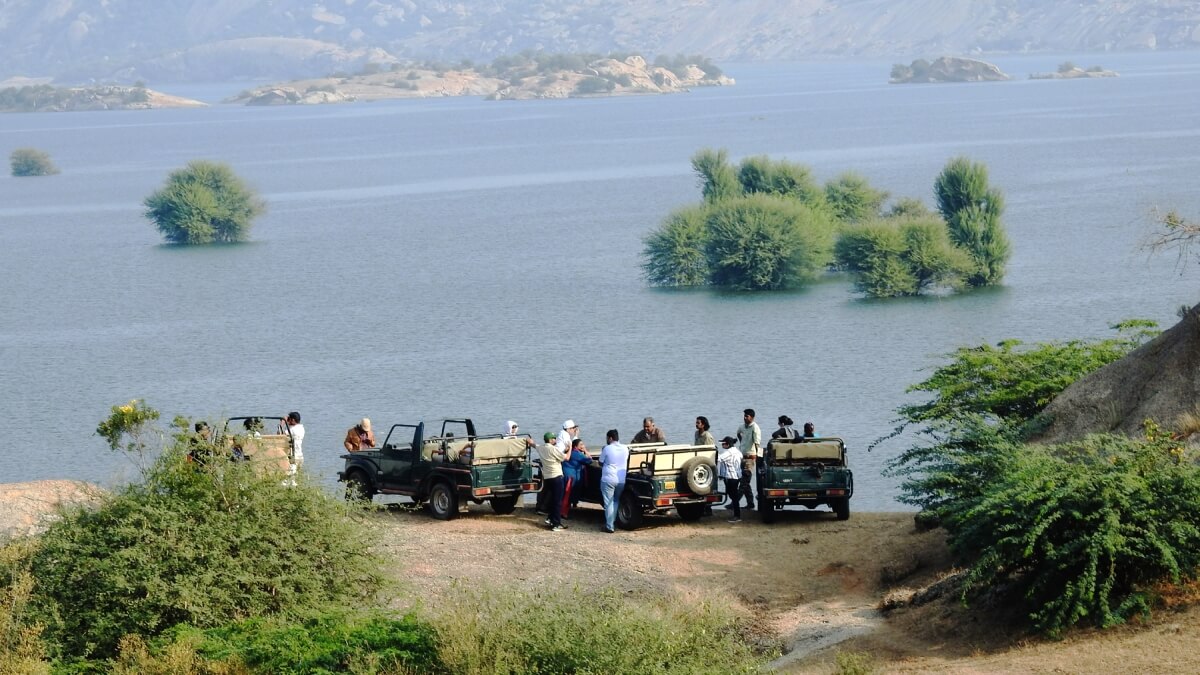

LEOPARD TOURS WELCOMES YOU TO TANZANIA
The founding of Leopard Tours in 1985 was an inspiration from the sheer wealth of natural attractions that make Tanzania one of the most enchanting safari destinations in Africa. It is a destination of natural wonders and understated beauty. With more than 25% of its area of 945,087 square kilometres set aside for game parks and reserves, Tanzania is considered the ultimate destination for nature observation and recreation.
In a ceremony held in Arusha, Tanzania, on 11 th February 2013, to honour the winners of the Seven Natural Wonders of Africa, Tanzania was recognized as the leading nature destination in Africa. Out of the Seven Natural Wonders of Africa, three of the World Heritage Sites of Tanzania were among the winners in the celebrated list, namely: Kilimanjaro National Park (Mount Kilimanjaro) , the Ngorongoro Conservation Area (Ngorongoro Crater) and Serengeti National Park. The winners were announced by the President and Founder of Seven Natural Wonders, Dr Phillip Imler, with Serengeti National Park emerging as the best of them all.
Leopard Tours is constantly investing in product development, focused on using the preferred assortment of safari vehicles and operations team needed to provide the best conditions for visitors to share with us the natural wonders of Tanzania.

Leopard Tours is proudly organizing visits to these wonderful places, including the idyllic islands of Zanzibar and Mafia , keeping in mind the arrangements and guest experiences are as rewarding as possible in recognition of the special value that visitors attach to these tours. Part of the tour fees that our guests pay go directly to the conservation and management of these nature reserves and cultural heritage sites.
The Tanzania Ministry of Natural Resources and Tourism vision statement is “Sustainable conservation of natural and cultural resources and development of responsible tourism”.
Tanzania is committed to low impact, sustainable tourism. Before starting their safari tour and holiday in Tanzania, visitors traveling with Leopard Tours are briefed about the fragility of the ecosystems and the need to tread lightly. Among other pre-safari notes, the guest’s welcome information kit includes National Park regulations, as we believe the protection of our natural world and cultural heritage is the responsibility of every one of us.

WILDLIFE SAFARIS

SIGNATURE SAFARIS

GROUP AND INCENTIVE TRAVEL

CAMPING SAFARIS

FLYING SAFARIS

MOUNTAIN CLIMBING

CULTURAL & HISTORICAL TOURS

ZANZIBAR & BEACH HOLIDAYS
REGULAR DEPARTURE SEAT – IN – A – CAR (Every Wednesday)
(2 nights Ngorongoro, 2 nights Serengeti & 1 night Lake Manyara)
(Minimum 2 pax per departure)

SUGGESTED ITINERARY (4 Nights/ 5 Days)
(1 night Manyara, 1 night Serengeti, 1 night Ngorongoro & 1 night Tarangire)

KILIMANJARO CLIMBING ITINERARY (5 Nights/ 6 Days)
(Marangu Route)
News & Updates
leopardtours
Leading Tour Operator in Tanzania. Experts in Wildlife Safaris since 1985. Great People for Memorable Safaris

I went on a budget and a luxury safari in Africa. Here's how they compare — and the one thing you really need to look for when booking.
Posted: March 14, 2024 | Last updated: March 14, 2024
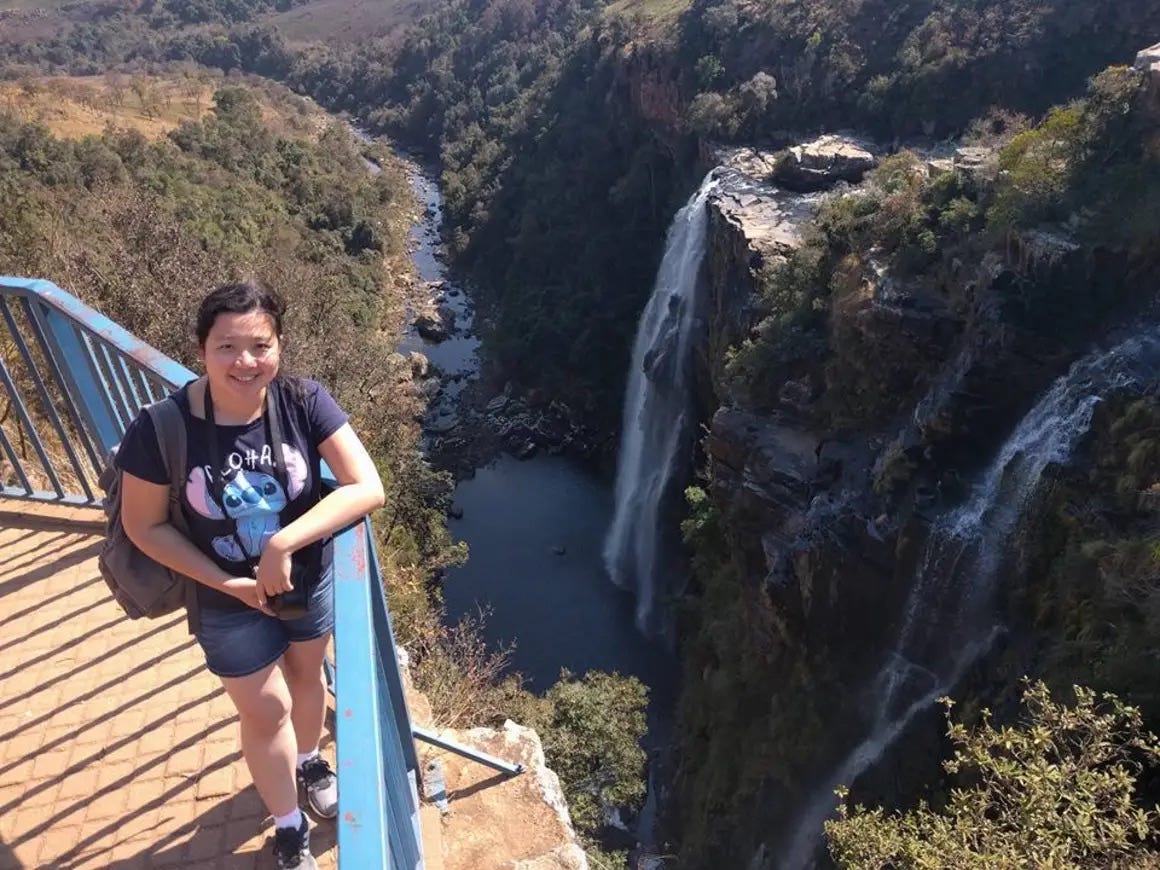
- I have been on two glamping safari trips in Africa on two very different budgets.
- My all-inclusive stay was great but my cheaper glamping experience was fine, too.
- Private game reserves are actually the most important thing to splurge on, not accommodations.
I've been on two African safari trips . Both involved glamping but on completely different budgets.
My first more affordable trip, a lodge in South Africa with separate safari excursions, cost me about $1,100. My second, an all-inclusive lodge in Tanzania, cost me about $4,000 after a 50% off deal.
Here's how the two compare and what I think you should look for before you plan an African safari .
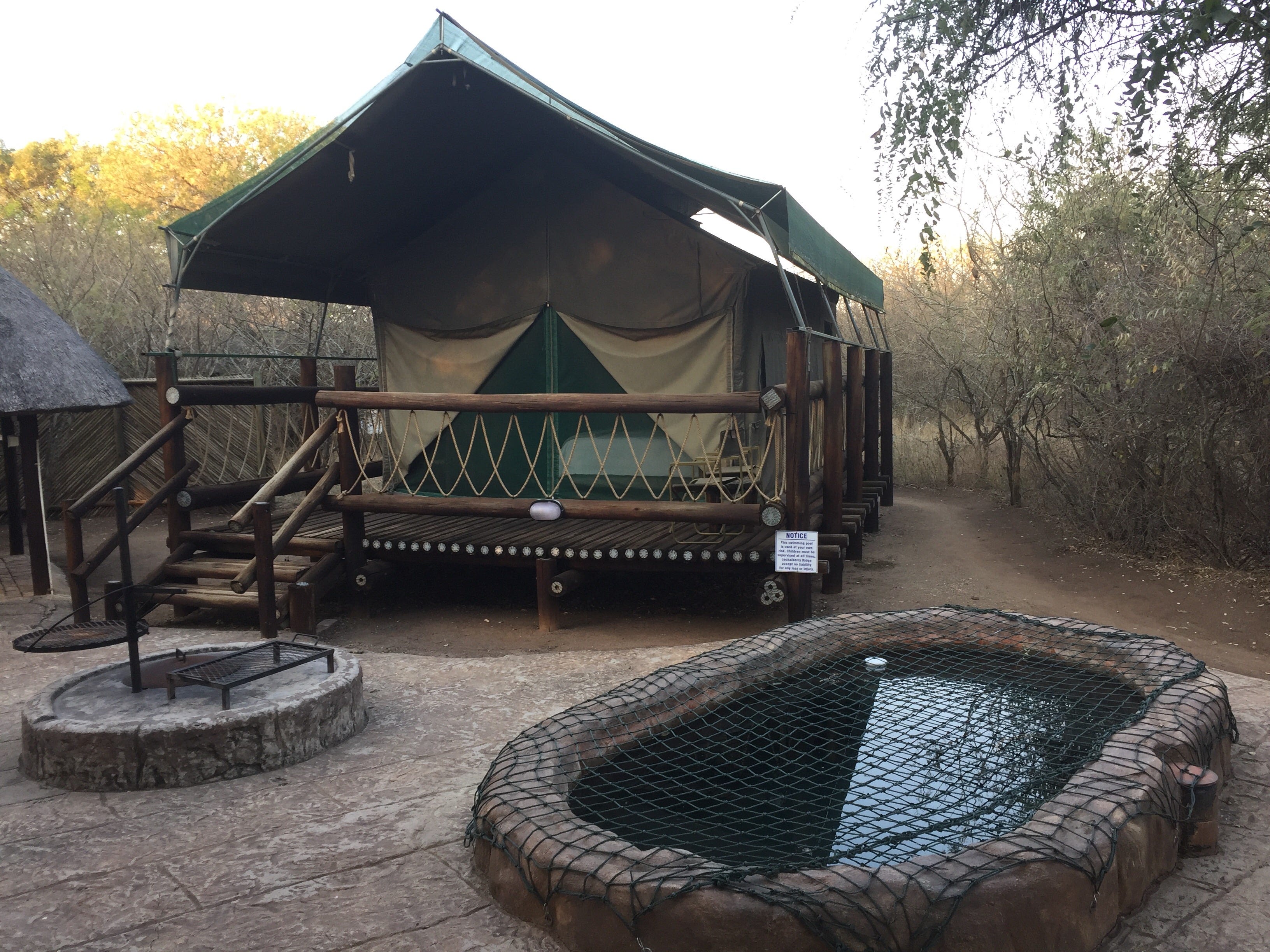
My affordable safari experience was at Jackalberry Ridge, where some tents cost $80 a night.
The first time I went on a safari, I went to Kruger National Park in South Africa. I didn't book a tour package, instead opting to stay at affordable lodging and book safari day trips to the park.
I stayed five nights near Kruger and one night in Johannesburg before my flight home. I spent around $1,100 for lodging, safari tours, a rental car, and food (not including flights).
After landing in Johannesburg, I rented a car ($130 for five days) to drive to my lodging in Marloth Park, a town bordering the edge of Kruger National Park.
I was staying at Jackalberry Ridge , a self-catering accommodation with no on-site restaurant, no room service, and limited housekeeping.
The one-bedroom tents at Jackalberry Ridge go for as low as $80 a night, and two-bedroom tents go for $135.
When I checked in late, there was no one at the reception desk — just an envelope with my name on it containing my keys and a map.
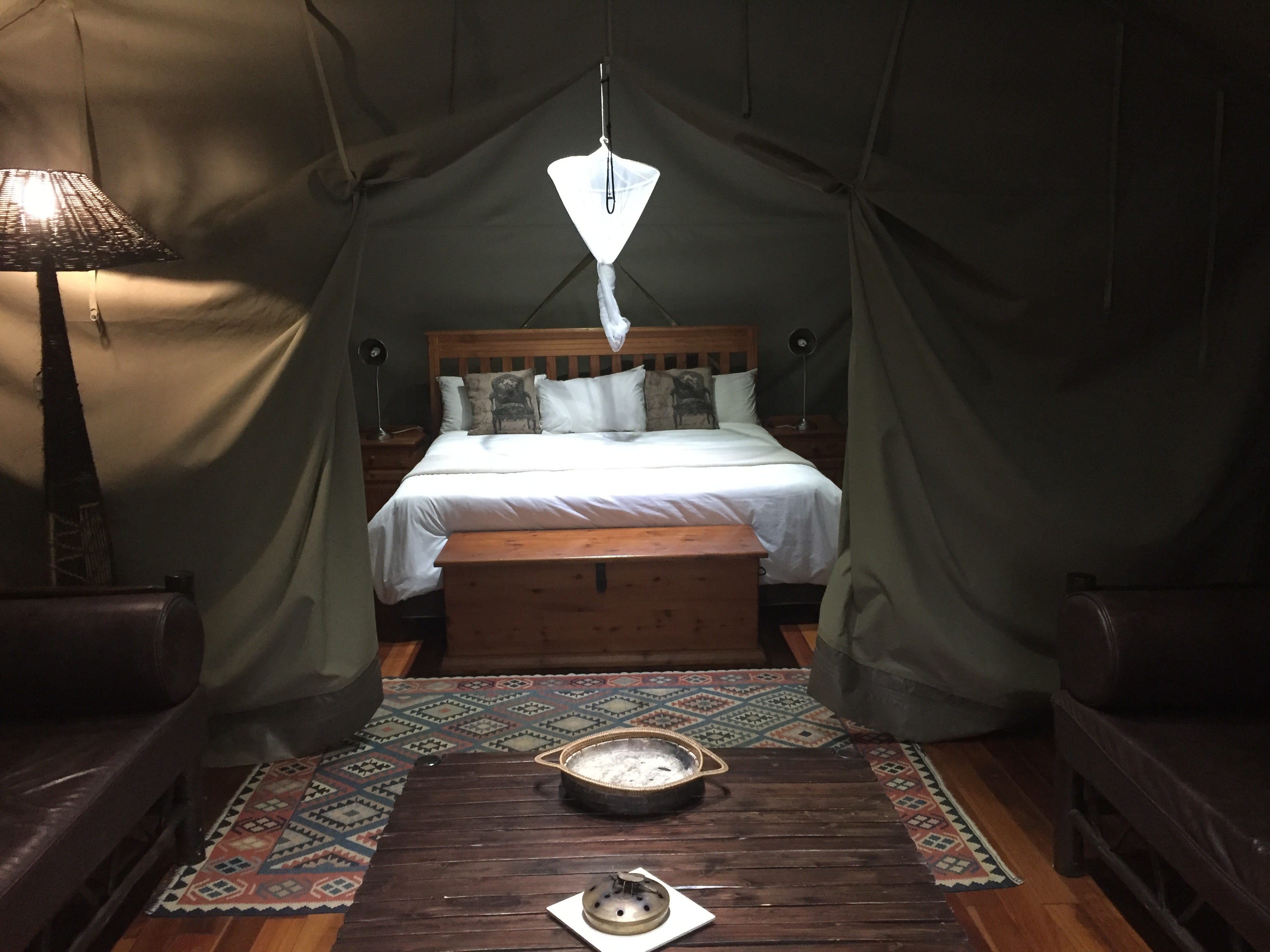
My main tent felt pretty spacious, with a king bed and a living-room area.
I had booked a two-bedroom unit (two tents), but my friend couldn't come at the last minute. Since I couldn't change the reservation, I still stayed in the two-bedroom unit and my friend paid her share.
The campsite came with a small pool to dip in, but it was covered as the weather was pretty cold.
Each unit had a private bathroom and kitchen in a building separate from the tents, so I needed to leave my tent to use the bathroom at night.
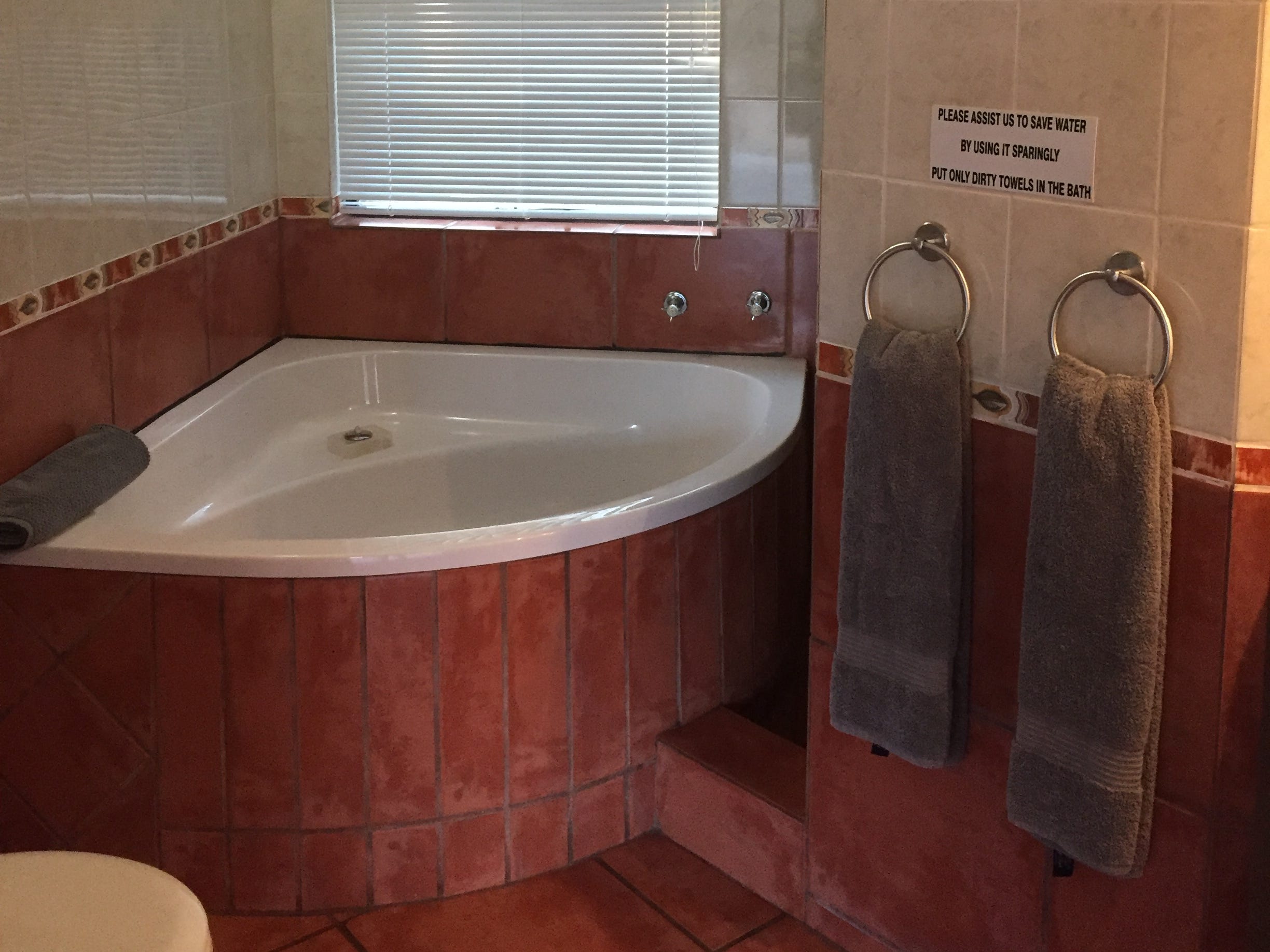
The bathroom was standard, with a tub, shower, and toilet.
This is glamping, so I had access to running water and a flushing toilet. I had hot water, but I found it went from scalding hot to cold in a few seconds.
I ended up taking quick showers and just washing my hair with cold water, which wasn't ideal since it was a little chilly in the morning.
It's also worth noting that Jackalberry Ridge was renovated recently, so the issue I had with hot water may have been fixed now.
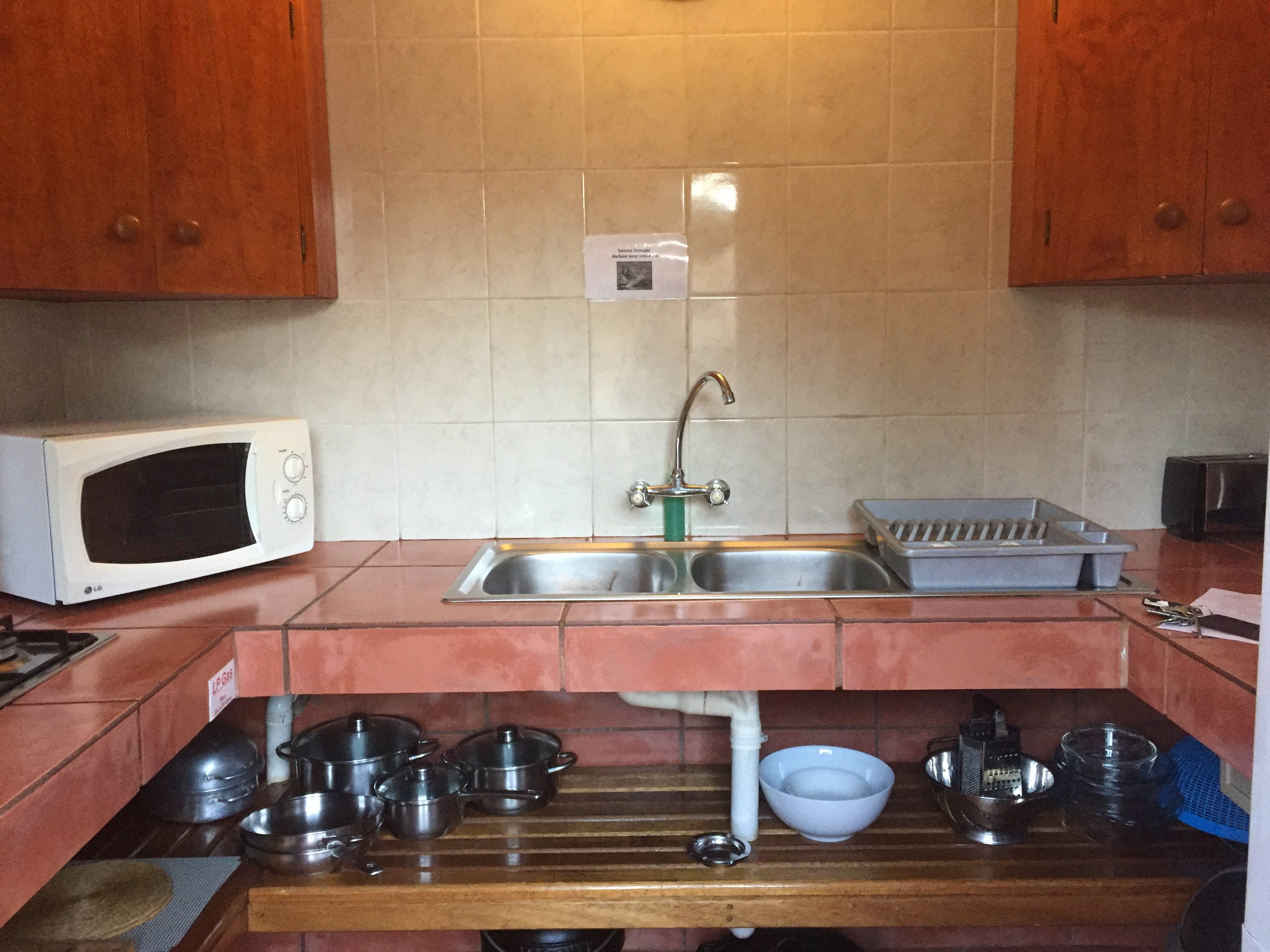
I also had access to a kitchen in the same building as the bathroom.
The kitchen was well-equipped with things like pots, a microwave, and a sink, so I could cook meals or heat up leftovers.

I signed up for a couple of day safaris and did one at night.
Although I had a rental car and could've done a self-drive safari around Kruger, I didn't trust myself to spot animals while focusing on the roads.
Instead, I signed up for a couple of day safaris and one night safari. The safari tour prices often don't include the park entrance fee (about $25 per person per day), which I paid when I got to the entrance.
My three safari trips and park fees came to around $280.
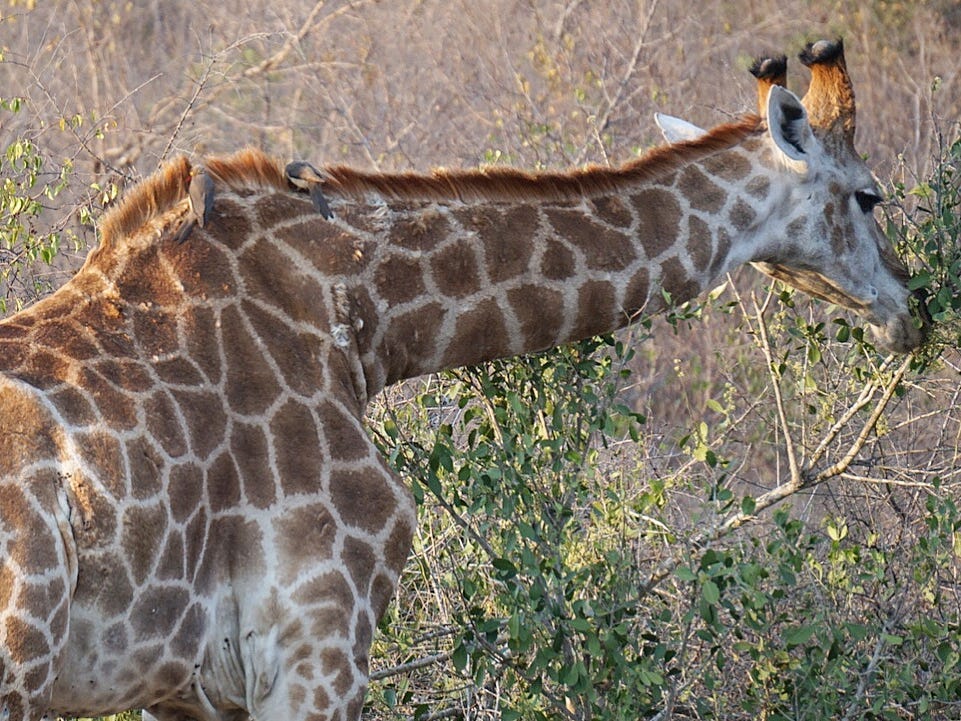
I got to see zebras, giraffes, and more.
I saw a lot on the safari, including zebras, impalas, kudus, and giraffes. I saw lions and a leopard, although only from afar with binoculars. I even got a glimpse of the elusive rhinoceros.
I also spent one day taking another popular day trip in the area, the Panorama Route. This scenic road goes past Lisbon Falls and the beautiful Blyde River Canyon. The guided tour was $110.
As far as my very first safari trip goes, it was great. I got to see the Big Five , even though some of them were pretty far away.
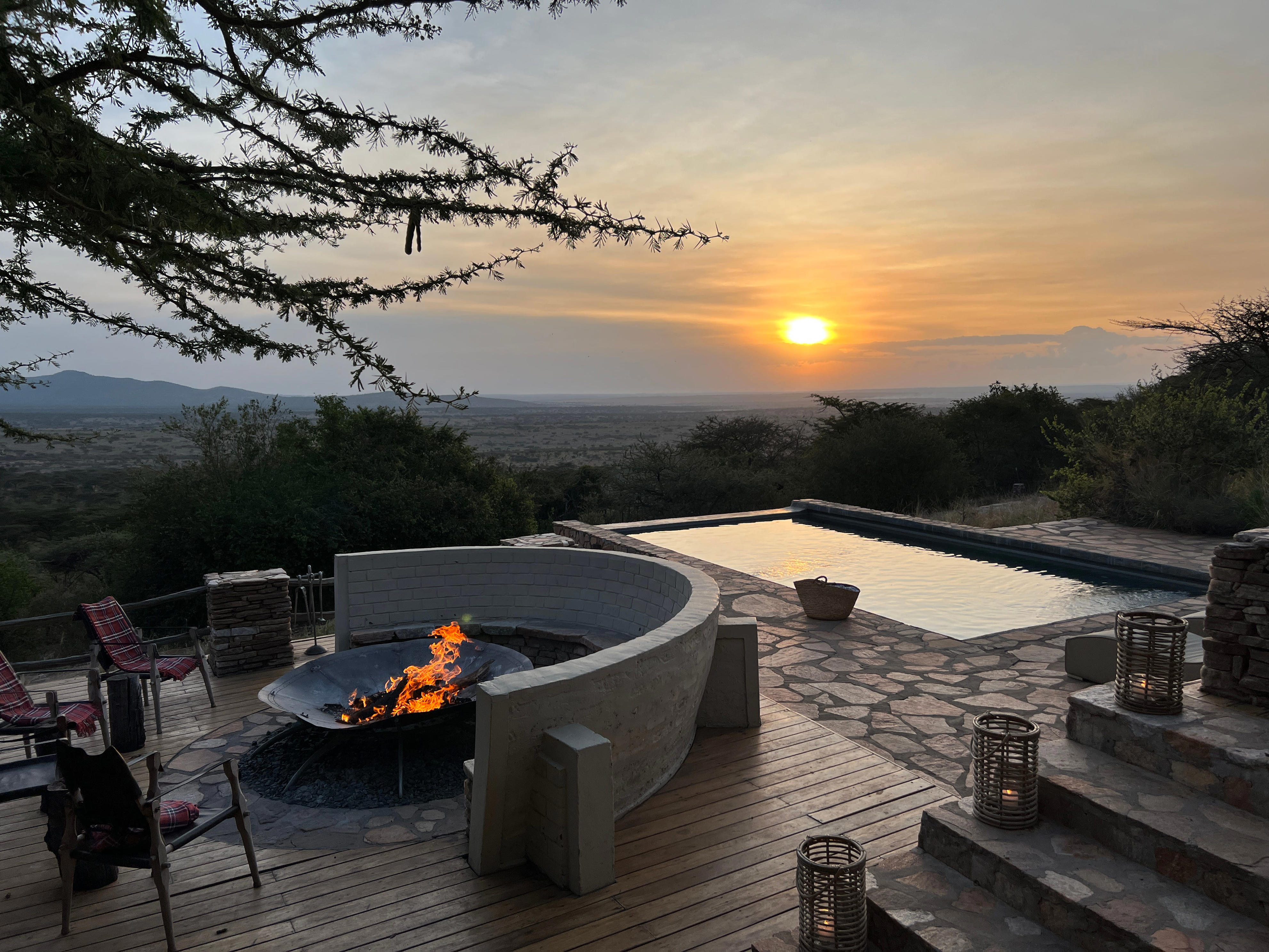
For my next safari trip, I leveled up.
I saw a Travelzoo deal for an all-inclusive safari at Taasa Lodge , a five-star luxury safari in Tanzania.
The deal was $6,000 for two people for a whole week — the lodge is usually $12,950 for two for seven nights. It was still a splurge, but I'd be saving more than 50% on a bucket-list experience.
The package came with seven nights of lodging, two safari activities a day, three daily meals, and drinks.
Still, we spent more than the original advertised price. There are obligatory "daily government park fees" and "daily concession fees" that added about $893 per person to our bill.
We also had to take a regional flight to get to Taasa, which was more expensive than my rental car in South Africa.
To redeem the Travelzoo deal, we had to complete our booking through a specific travel agency.
We ended up opting for an all-inclusive add-on package which includes the $893 fees above, domestic airfares from Arusha to Taasa (which would already cost around $600), and our agency arranging our Tanzanian tourist visa and airport transfers. The add-on also included extra activities at the resort (more on that later).
Overall, we paid $1,715 per person on top of the $3,000 each for the lodge stay.
I hadn't anticipated paying so many extras, but it was nice to have someone take care of the logistics of getting to the resort.
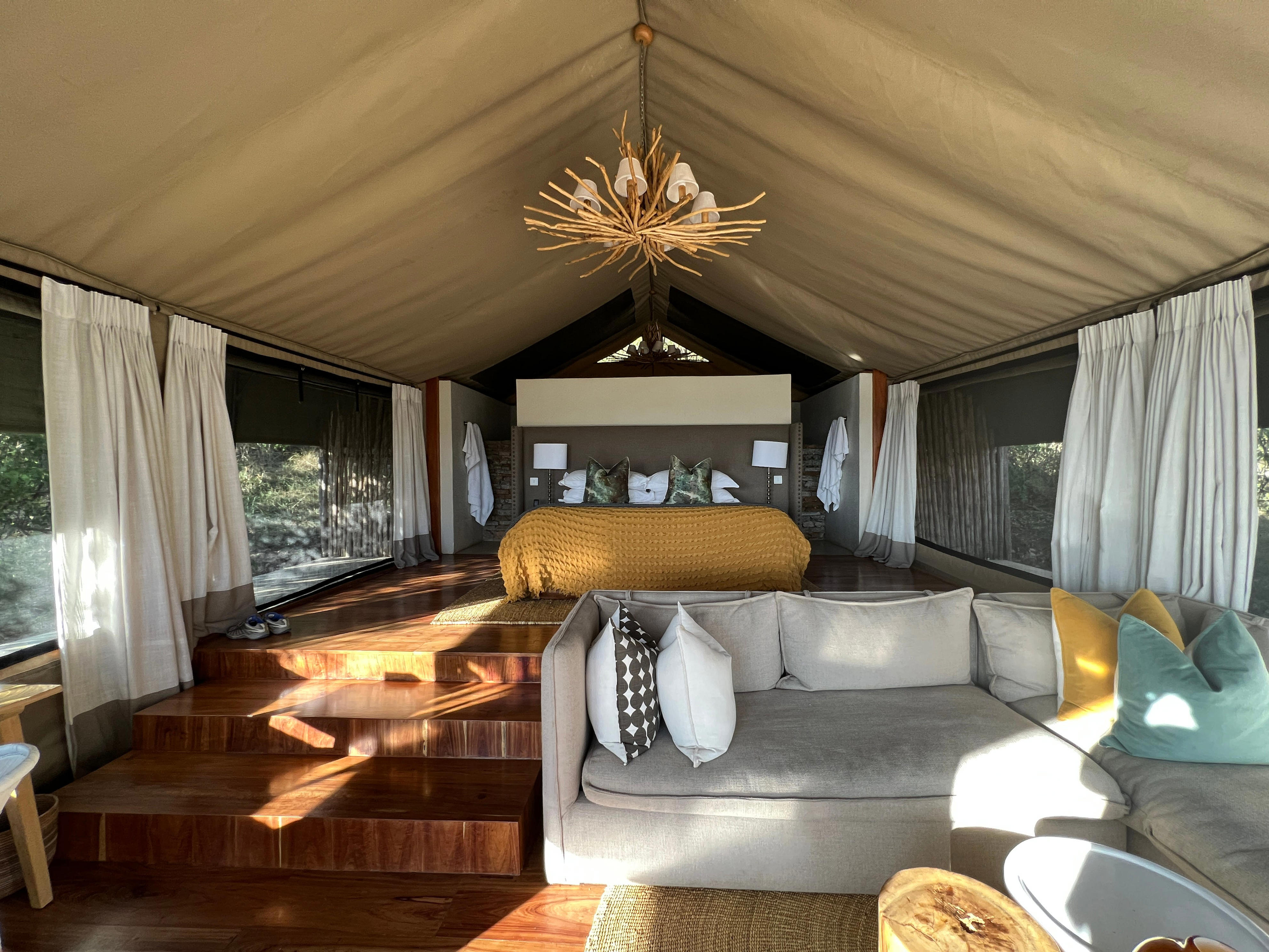
My tent was luxurious and equipped with a comfortable king bed and a large living room.
When I arrived at the lodge, the staff greeted me with a glass of juice and a wet towel to refresh myself.
My tent was quite spacious. I especially liked that it had a desk and plenty of outlets I could use to charge my electronics. Our bathroom was behind our bed, and I was glad it was inside the tent this time.
We also got a butler who kept track of our schedules and made sure we had what we needed.
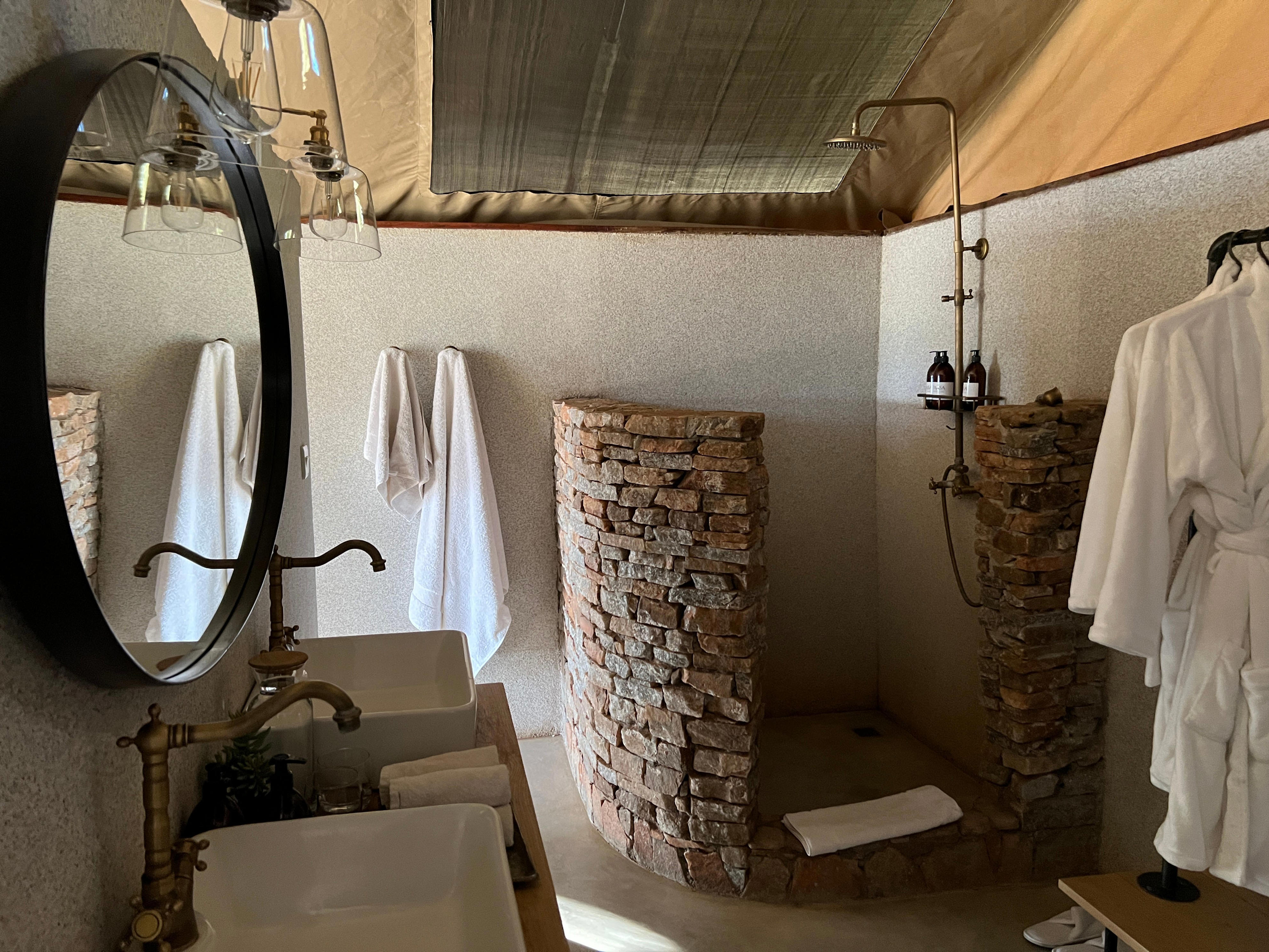
The bathroom felt spacious, with two sinks and a shower.
The shower's hot water was great and we had double sinks we could get ready at.
Another perk of the lodge is that we could have staff do our laundry every day, which meant we could pack less clothing.
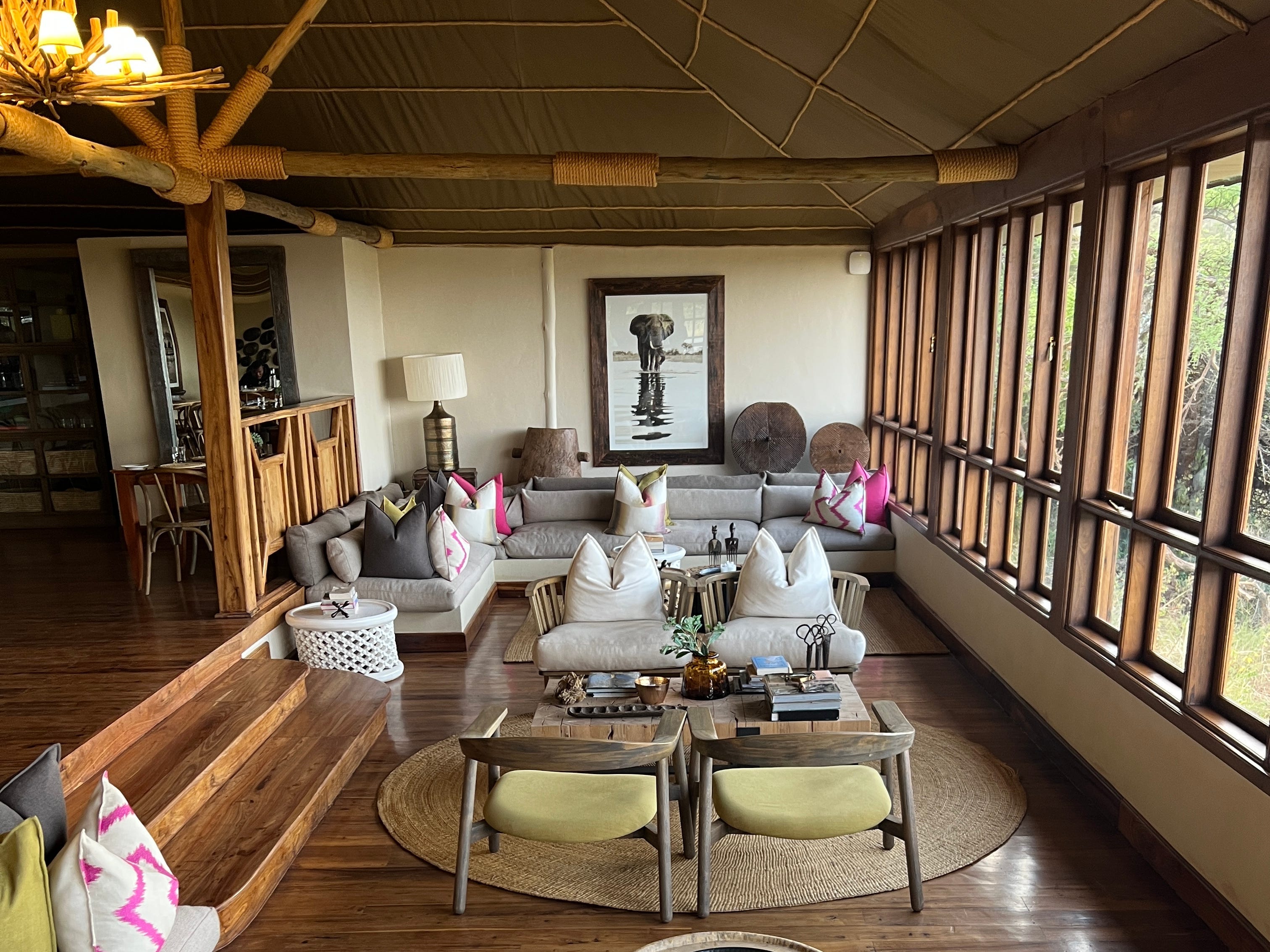
There's a main lodge with a communal living room, dining area, and bar.
We got breakfast at the buffet in the main lodge unless we were going on a morning safari.
Most people ate dinner in the dining room, but we could've requested to have food brought to our tent.
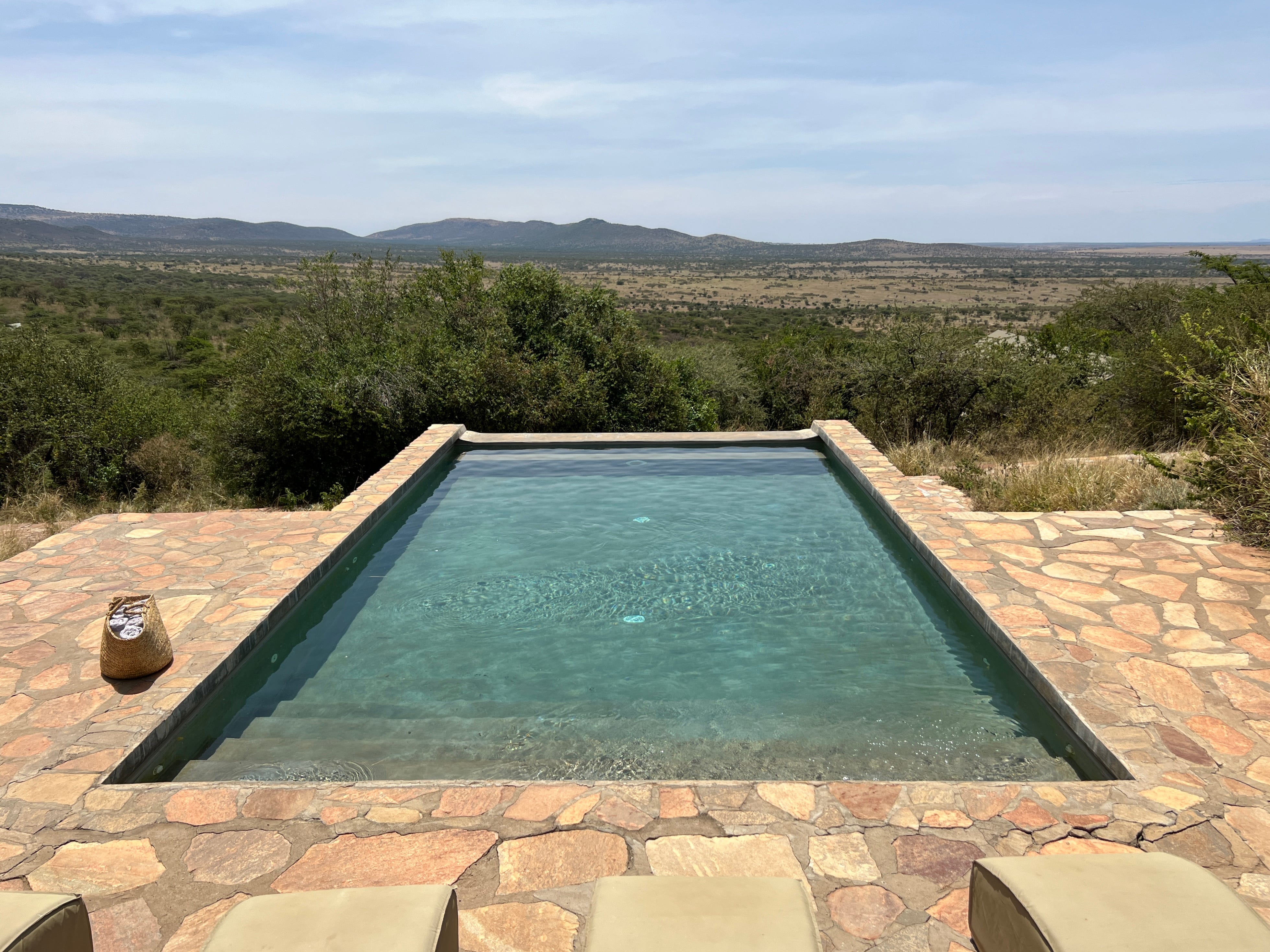
We also passed a small pool next to the main lodge.
The pool was on the small side, but certainly had great views.
I didn't end up using it as my afternoons were filled with safari, and the mornings and evenings were chilly.
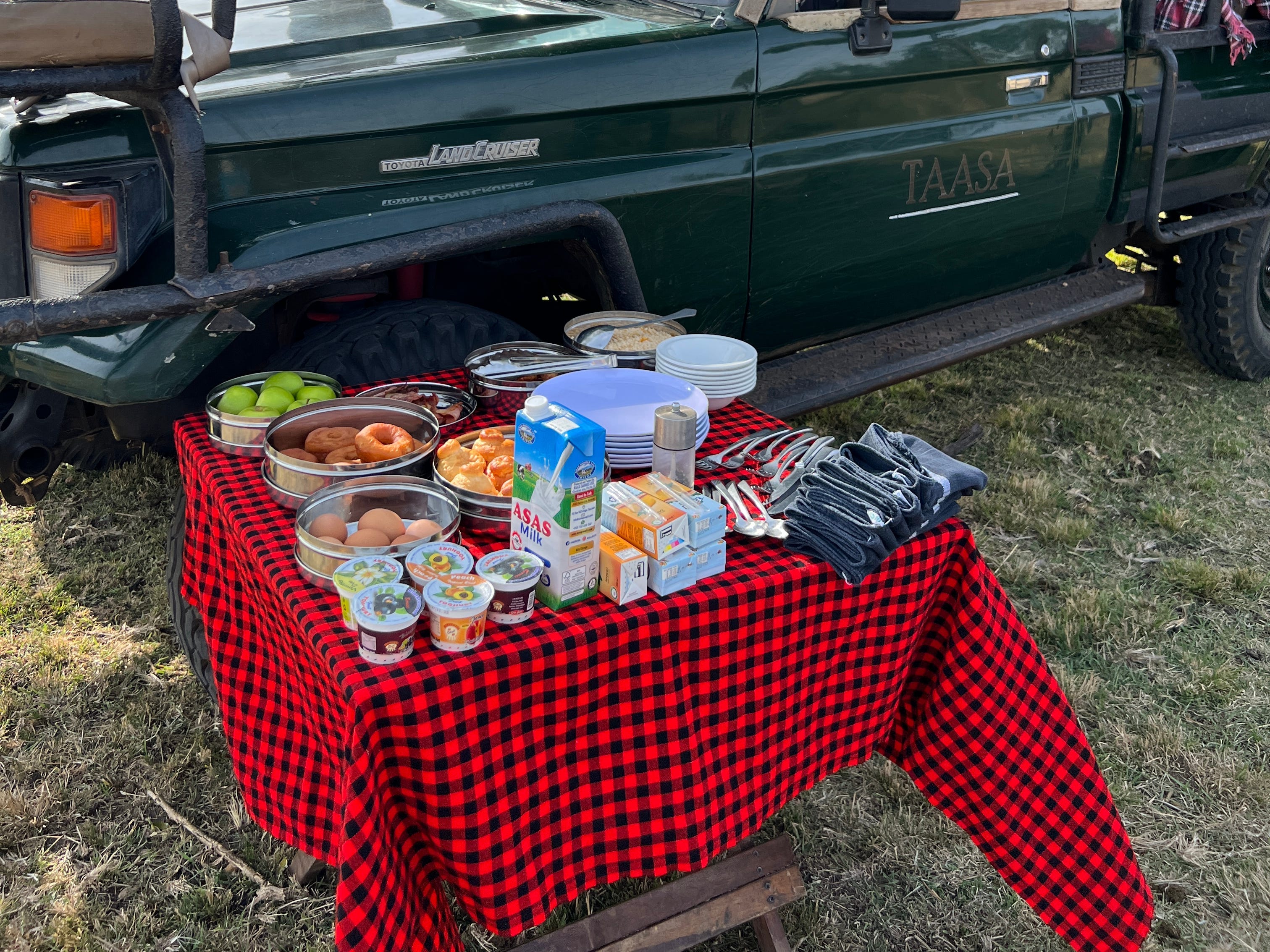
On the mornings with an early safari, we had a simple breakfast next to our Land Cruiser.
Safari breakfasts consisted of hard-boiled eggs, yogurt, doughnuts, bacon and sausage, fruits, and orange juice. Staff also made French-press coffee, which we could spike with cream liqueur.
Our Land Cruiser had a cooler of beers and sodas in the back, too.
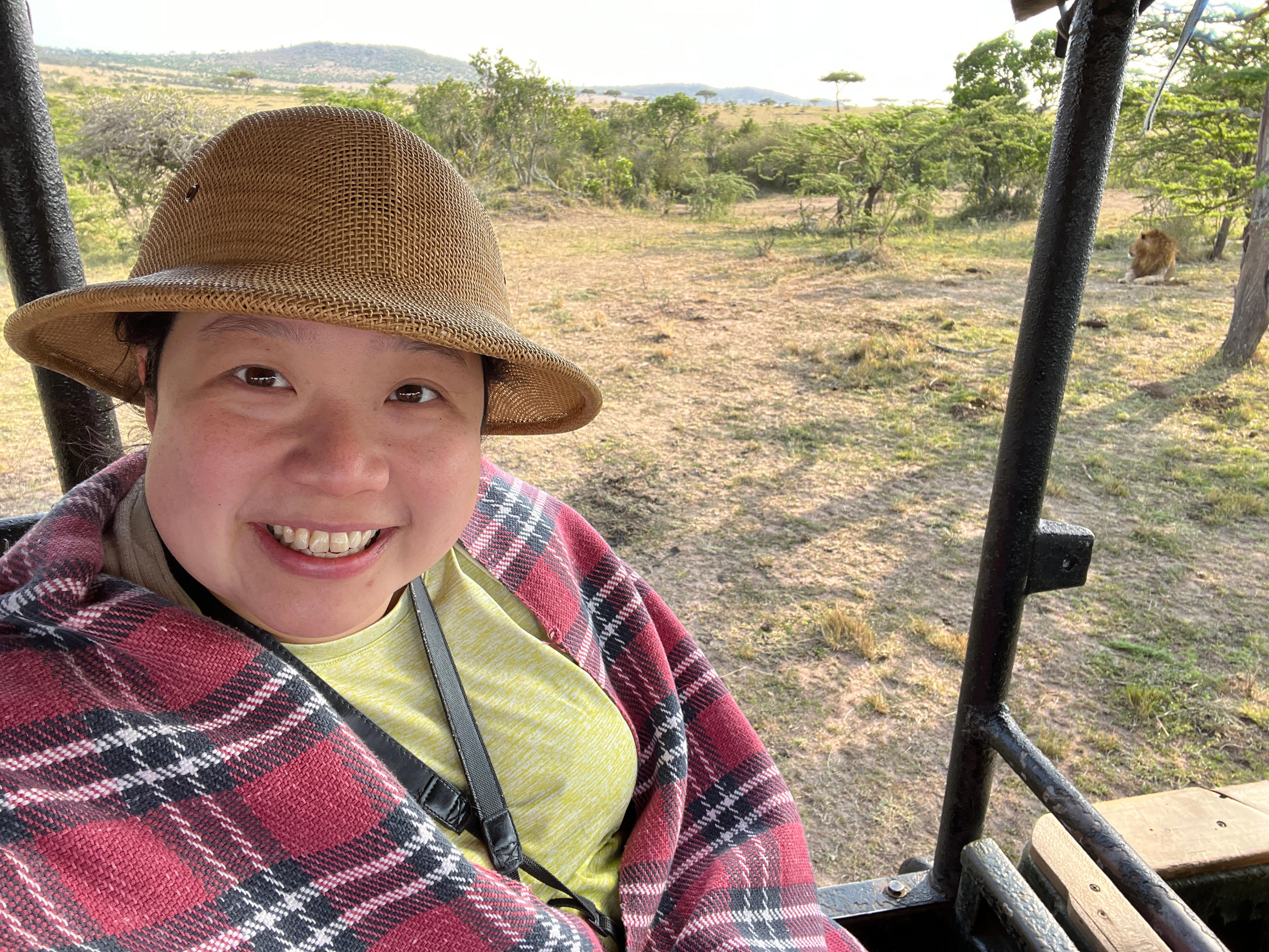
At the private game reserve, we got pretty close to wildlife.
Taasa is located inside a private game reserve, which means staff can pretty much drive anywhere within it. This was a huge leg up from my day trips in Kruger National Park on my last safari.
Inside national parks like Kruger or Serengeti, you're only allowed to drive on designated roads for safety reasons (both for the tourists and the animals).
But in a private reserve, guides can drive offroad. Plus, the guides communicate with each other when they find something special.

We saw a bunch of animals in the private reserve and Serengeti.
We also left the reserve to spend a couple of days going into Serengeti National Park, as there were things you could only find there instead of within the private reserve.
For example, I'd planned my trip to take place during the Great Migration, and I wanted to see wildebeests crossing the Mara River.
We also went to Serengeti to find rhinoceros and hippopotamus.
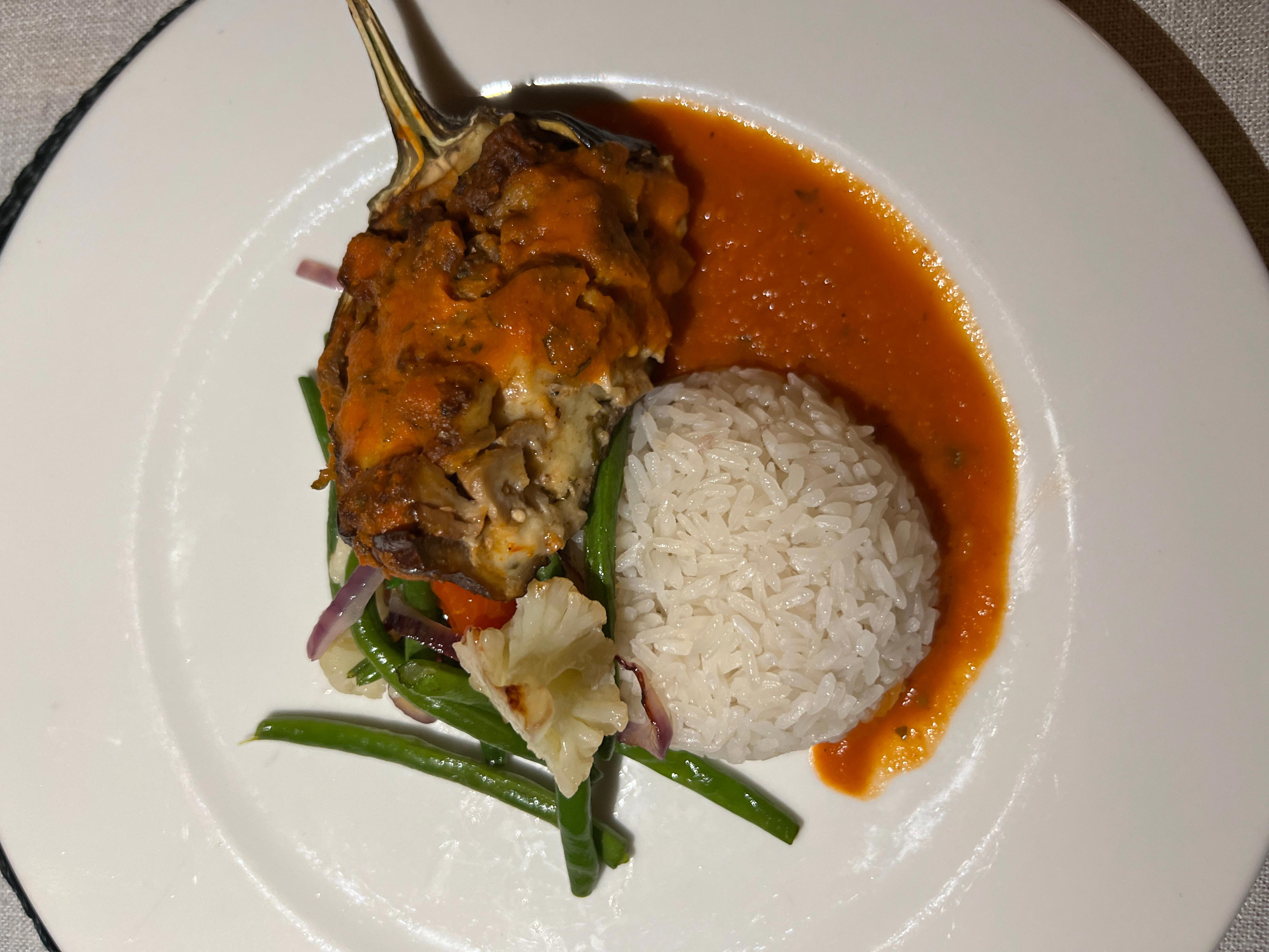
Every dinner at the resort consisted of three courses: soup, an entrée, and a dessert.
The main course was usually some type of Western food, and there was always a vegetarian option.
It would've been nice to be offered more typical Tanzanian dishes, though. For me, part of the fun of traveling is learning about different countries' cuisines.
I also had access to an open bar in the main lodge. Staff could make simple cocktails, and there was lots of beer and wine. The drinks were all included with the price of the stay (except for fancy Champagnes and select wines).
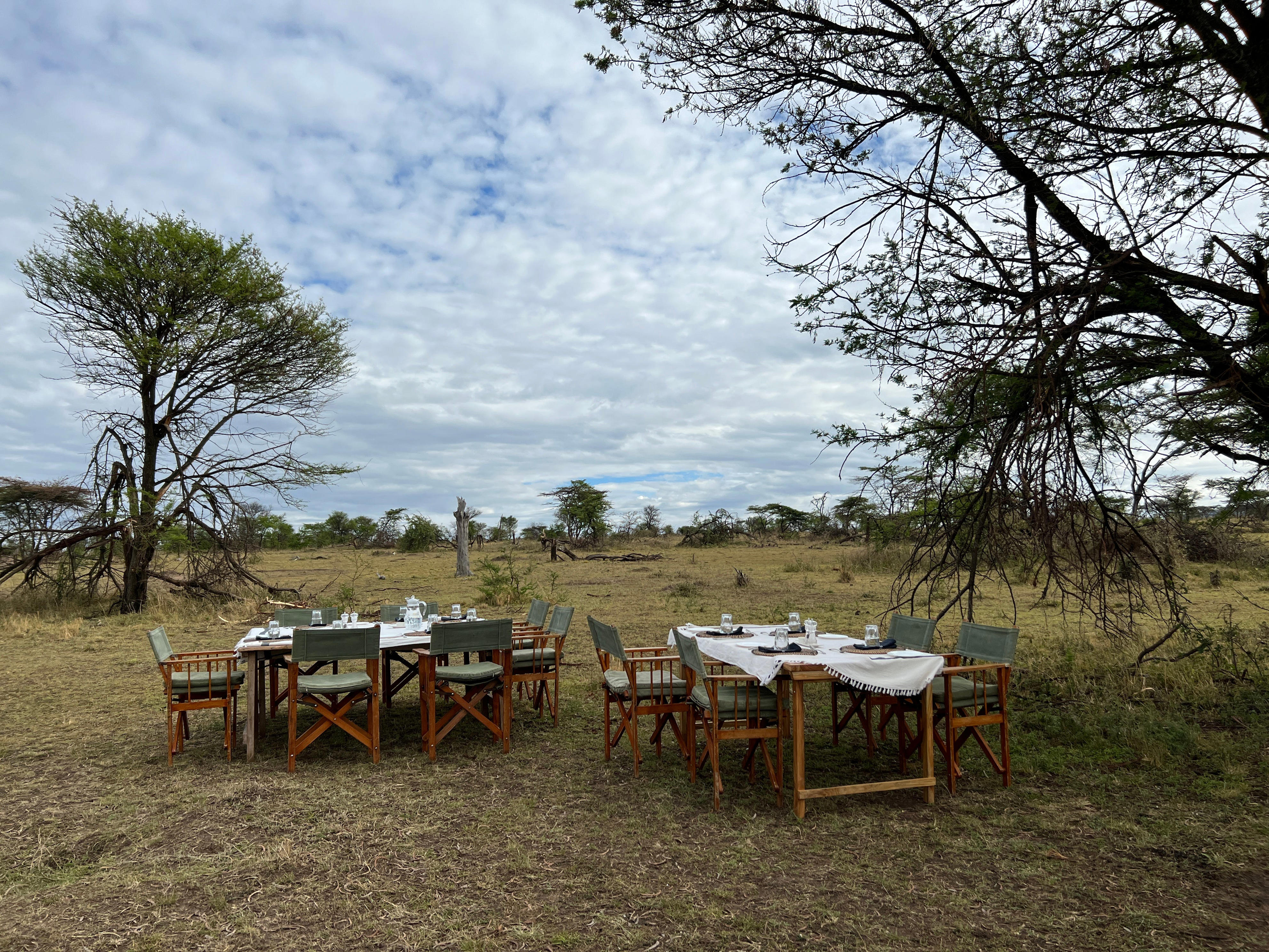
One morning, we had a special breakfast on the plains.
On one day of the trip, we had a special bush breakfast. It was one of the extra activities we got with that special add-on package.
Instead of our usual safari breakfast, we had freshly prepared omelets in the wild.
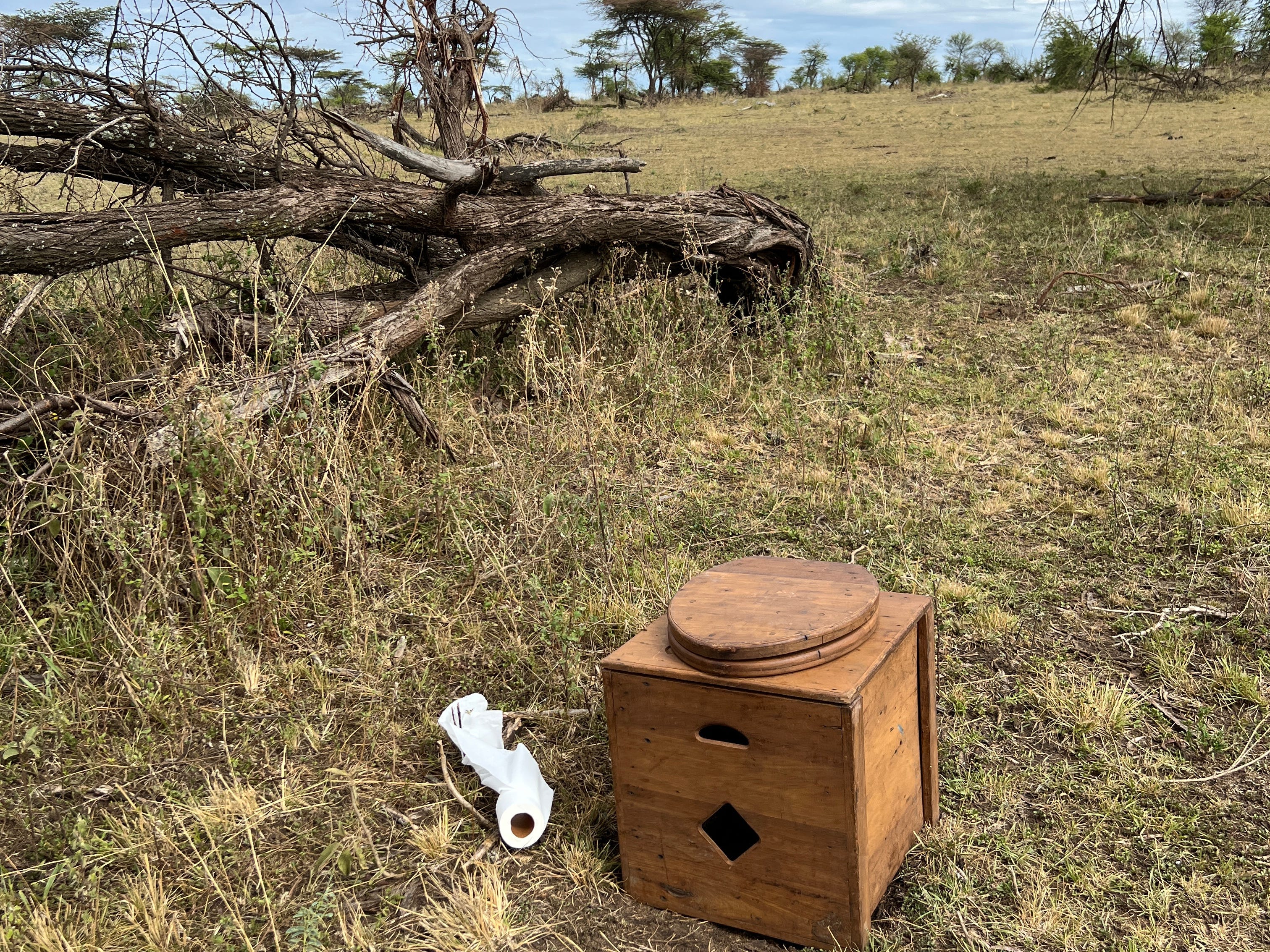
We also got another special treat in the bush that morning — a toilet!
When you're offroading looking for wild animals, you can end up pretty far from a proper toilet.
On most safari days, the car stops (when guides think it's safe), and people go behind the car to do their business.
This was the only time we had this portable toilet while out on a safari. On my budget safari day trips at Kruger, we'd have to wait until we reached a rest-stop facility.
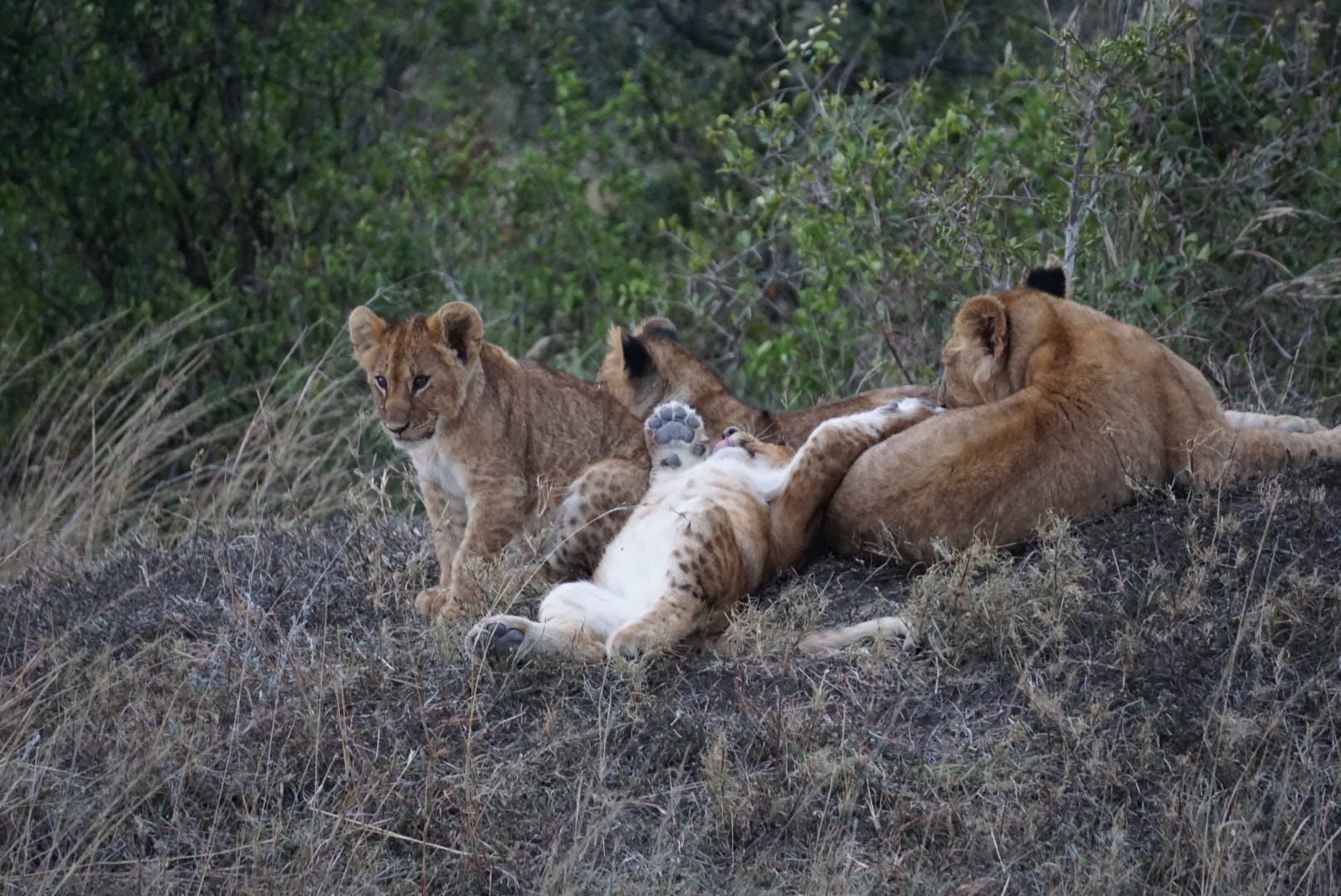
Again, we spent a lot of time watching lions.
After breakfast, we were back in safari mode.
We found a family of lions, and as we were in the private reserve, we were able to stay and watch the cubs play for quite a while.
At Kruger, when lions are spotted, traffic starts backing up on the road as all the safari cruisers stop to look, so you can't stay too long.
Here, we knew no one else would be coming.
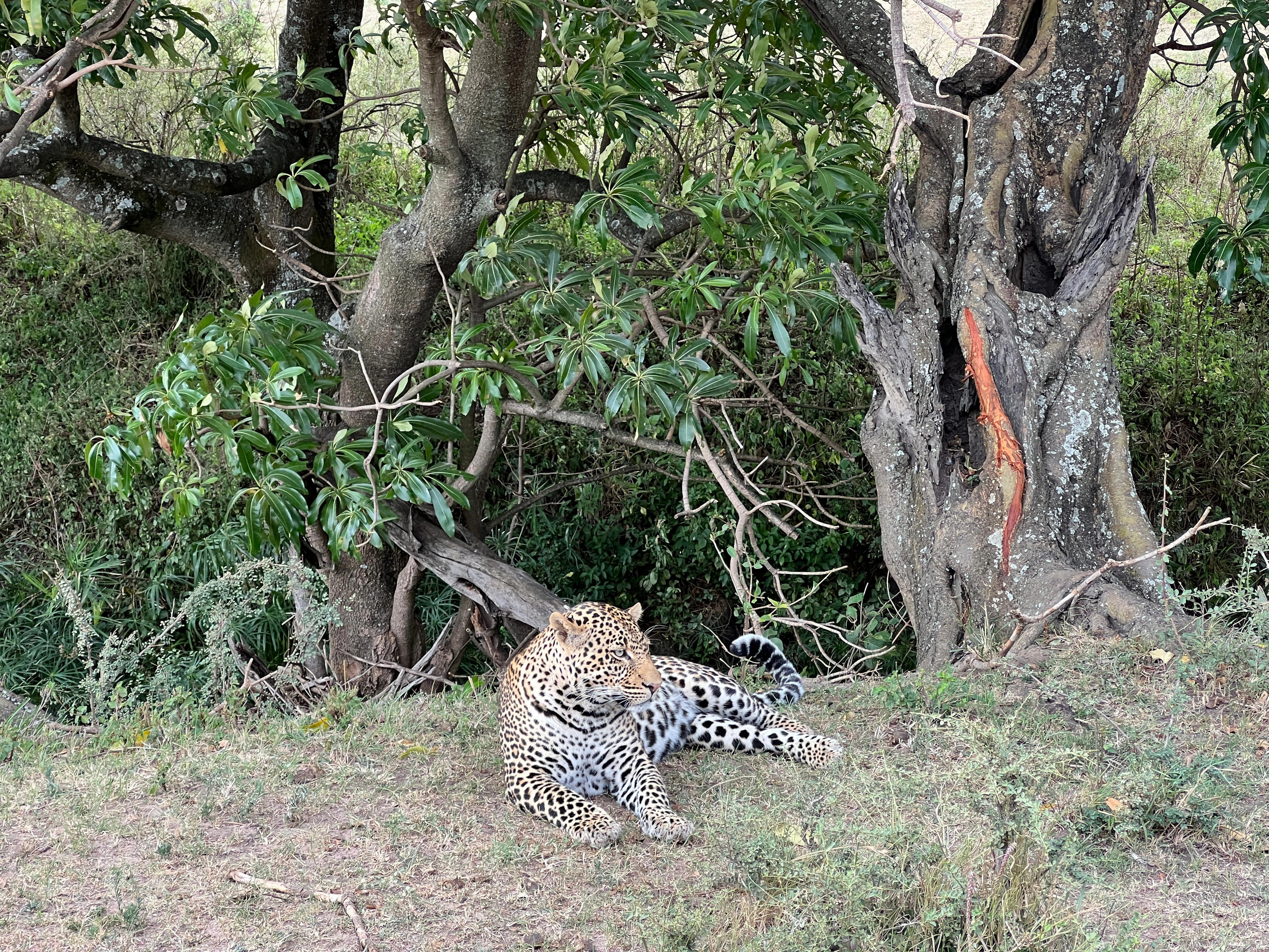
On a different morning, our guide got a tip that another car had found a leopard sleeping.
The communication between guides in the private reserve paid off when one spotted a sleeping leopard.
When our group arrived, the leopard was napping on the tree next to his catch. Eventually, it came down, and we got a better look.
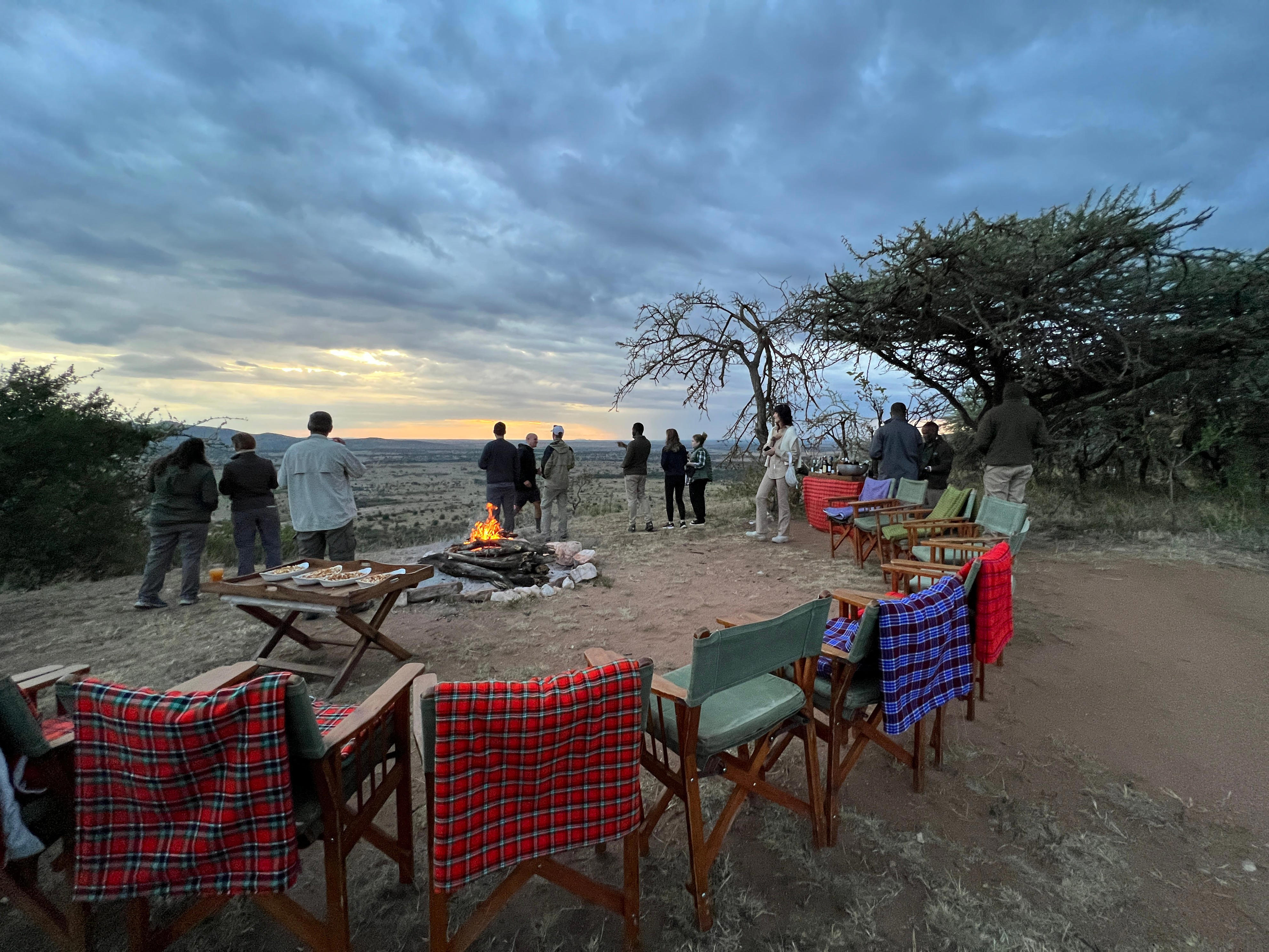
Our trip ended with a great happy hour and outdoor dinner.
Other activities that were part of our add-on package included a visit to a Maasai village in Kenya and a special happy hour and barbecue dinner.
And, for our journey home, the travel agency took care of everything, including transfers, until we boarded our international flight.
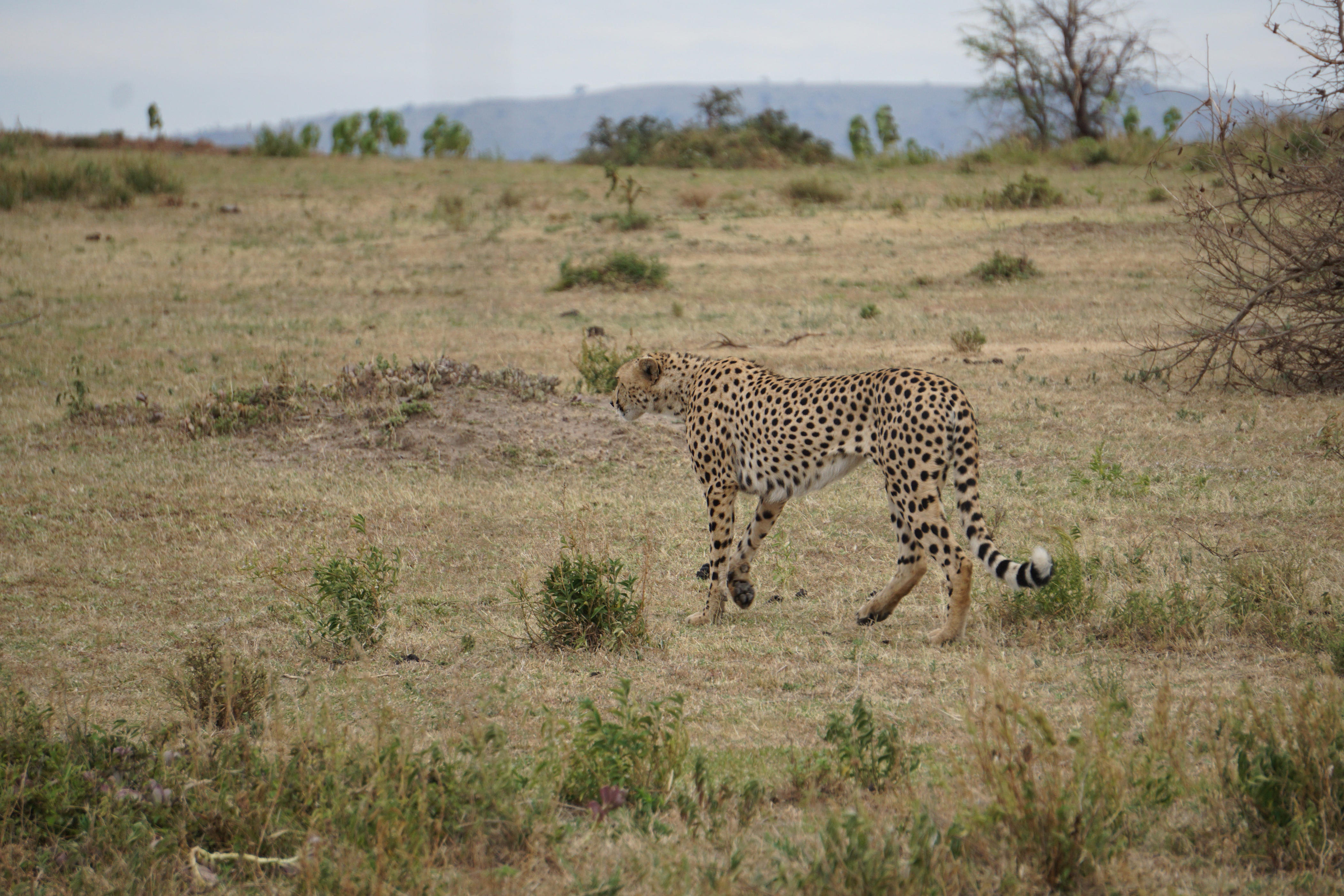
My big takeaway is that it's really worth paying to be inside a private reserve.
In my opinion, the difference between these two safari trips that's the most worth paying for is being in a private reserve.
After all, the main reason I fly to Africa is for the safari, not the glamping.
I much preferred my lodging at Taasa, mostly because of the bathroom. But if I hadn't had the 50% off deal, I'm not sure the full price would've been worth it.
Still, it was a wonderful experience, and if I had more money, I may feel differently. Even so, the budget glamping was pretty comfortable and just fine for a week.
But again, as far as the safari experience goes, the private reserve is hard to beat. Being able to go offroading and get closer to the animals is quite the experience.
And if luxurious lodges are out of the question, private reserves can also be visited more affordably. Some lodges inside private reserves, like Shindzela or Rhino River Lodge, can cost around $250 per person per night.
More for You
19 Things People Treat As Safe That Actually Are Pretty Dangerous
NATO Aircraft Activated After Waves of Russian Strikes
Here's No. 1 thing mentally strong couples 'never' do, says relationship therapist of 20 years
I'm abrosexual - it took me 30 years to realise
7 Ways People Destroy the Value of Their Homes, According to a Real Estate Agent
One of these pictures of me is real and the other is AI – but which is which?
19 Things That Will Happen When You Stop Drinking Alcohol
Do I have to pay off my spouse's debts when they die? Here's what you're responsible for and what you aren't after a loved one's death
Harvard psychologist shares 5 toxic things 'highly narcissistic' people always do in relationships
29 common human foods you may not realize are poisonous to your dog
Martin Lewis issues warning to people choosing air fryer over oven
A woman said her tattoos got her rejected for a job, but experts say personality is far more important
Unsellable Houses' Lyndsay Lamb Says Buyers Are Moving Away From This Color Trend
Scientists claim people with this blood type more likely to have early stroke
Liz Cheney's Message to Supreme Court After Donald Trump Hearing
The #1 restaurant chain in America, according to diners—and see the rest of the top 50
Average US annual salary by age revealed – see how you compare
Barack Obama shares his No. 1 piece of advice for his own daughters: Don't let your hunger for success ruin your happiness
People Who Don’t Show Empathy Usually Have These 18 Traits
Scientists have discovered the maximum age a human can live to
[email protected] | +230 452 3731

Black Leopard of Laikipia, Kenya
The first ORYX Black Leopard Safari was a resounding success, surpassing all hopes and expectations. On our first day, after a short flight from Nairobi, we landed in the beautiful Loisaba Conservancy, where a scenic drive to the lodge awaited us. Along the way, we were delighted to catch a glimpse of the highly endangered Grevy’s Zebra roaming amidst the parched landscape .
Upon arrival at Laikipia Wilderness Camp , we were greeted with a warm welcome by the staff. The lodge, perched atop a rocky outcropping, offers a breathtaking vantage point into the heart of the black leopard’s territory.
Our first game drive was filled with excitement and anticipation as we set out in search of the elusive black leopard. We were hopeful, as she had been spotted in the area the night before, and in recent months, has started being seen during daylight hours. We spent the entire afternoon exploring her territory, scanning the dry landscape for any sign of her distinctive black body, which stood out clearly from far distances.
As darkness descended, we received the call we had been waiting for. Our tracker had spotted her across the river! The whole vehicle tensed with excitement as we rushed to the riverbank, cameras at the ready. The moment was electric as we spotted a dark shadow moving among the rocks in the dry riverbed. The whole car quietly cheered in excitement for this monumental moment. A lifetime dream was achieved.

Black Leopard Photo Safari with Wildlife Photographer, Penny Robartes

South Africa – MalaMala & Tengile Photo Tour with Daniel Bailey

Ethiopia – Vanishing Tribes of the Omo Valley with Mike Dexter
Post a comment cancel reply.
Save my name, email, and website in this browser for the next time I comment.
Please enter an answer in digits: 19 − 5 =
You don't have permission to register

- Name * Title Mr. Mrs. Ms. Dr. Prof. First Name Last Name
- Sign up for the Recommended Tour Mailer (required)
- Name This field is for validation purposes and should be left unchanged.

- Our Safaris
- Media and Press
Ethical and Eco-Friendly Safaris
Our trained naturalists will take you on an unforgettable experience at Yala National Park, Sri Lanka’s premier game reserve. We have been operating our professional safari tours since 2006, with utmost respect for the flora and fauna inhabiting the National Park. We believe in minimal animal disturbance on our wild Safari Tours.
Our excursions are in the cooler hours of the morning and the late afternoon when the chances of spotting wildlife are at their best. Our guides know the park inside out and will take you to the best spots for spotting elephants, leopards, crocodiles and and all other species living in Yala National Park.
Our Customized Safari Jeeps
Safaris is only available with our all-inclusive packages (in-house guests).
Promising an incomparable experience in the wild, you’ll safari daily aboard our Toyota Land Cruisers, customized for your comfort. These four-wheel drive jeeps are geared for all terrains, and have been designed to maximize wildlife viewing in absolute comfort. Partly because your driver is well trained, and will make sure you feel comfortable and safe.
The jeeps are also incredibly practical. Each is equipped with a cool box of refreshments and nibbles, along with binoculars and wildlife field guides. We also have photographic equipment including battery charging facilities, camera support points, bean bags and arm clamps.

What Can I See?
Widely acknowledged as the Leopard capital of the world, Sri Lanka is the place for seeking out this rare creature, as well as an exciting range of other wildlife. In Sri Lanka leopards are the apex predators, with no real competition for food. This means they are generally not shy and you can even find leopards walking along the road during daytime, or simply escaping from the heat by sleeping relaxed on a shady tree.
Hover over the different photos to explore more
Yala National Park
Yala National Park is located in the Southeast of Sri Lanka and borders the Indian Ocean to the East. With its 979 square kilometers (97,881 hectares or 379 square miles), it is Sri Lanka’s second largest National Park. Due to its size and location on the island Yala offers a wide variety of habitats such as dry zones, rivers, lagoons, forest, rocky outcrops, and shore line and therefore boasts a high diversity of mammals, reptiles, amphibians and plant species.
Yala is divided into 5 blocks, each block has a different name and can be visited with individual permits. Generally when talking about ‘Yala National Park’ people are referring to Block I (Ruhuna National Park) which is where most safaris happen, and is famous for having one of the highest densities of leopards in the world. Block I has 2 entrances – the main entrance (Palatupana) near Tissamaharama and the quieter back entrance (Katagamuwa) near Kataragama.
We are conveniently located only 3km from the Katagamuwa entrance, this quieter back entrance to Block I, ensuring less disturbance and more visibility of the vast range of flora and fauna. Alternatively, we can use the main Galge entrance (to Block III, IV, V) only 20 minutes away.

The Weather
Sri Lanka’s diverse seasons are equally alluring and ensure that a stay with Leopard Safaris is rewarding at any time of the year.
Sri Lanka is tempered by two monsoons (north-east and south-west), which affect the island at opposing times of the year. During the monsoon season the parks are beautifully lush – the trees are in full blossom, mornings are cool and dewy, and birds migrating here from overseas contribute to the parks’ rich birdlife. This is also a wonderful time of the year to see Sri Lanka’s elephants.
Conversely, in the dry season, when many waterholes dry up and the browning bush dies back, the chances of viewing big game are highest. In between seasons, you can enjoy the best of both worlds so no two visits to our safari camps in Sri Lanka are ever the same!
Your Next Adventure Is Calling.

Quick Links
- Yala Safari
- The Campsite
- Eco Mission
- Privacy Policy
- Cookie Policy
- Refund Policy
©2024 Leopard Safari All Rights Reserved.
Design, Development and Maintenance by Tribe
THE 5 BEST Moscow Safaris
Safaris in moscow.
- Adrenaline & Extreme Tours
- Gear Rentals
- Nature & Wildlife Tours
- 5.0 of 5 bubbles
- District Central (TsAO)
- 3rd Transport Ring (TTK)
- District North-Eastern (SVAO)
- District Eastern (VAO)
- District South-Western (YuZAO)
- Lomonosovskiy
- Ostankinskiy
- Meshchanskiy
- Krasnoselskiy
- Maryina Roshcha (Jewish Quarter)
- Good for Couples
- Good for Kids
- Good for Big Groups
- Adventurous
- Budget-friendly
- Good for a Rainy Day
- Hidden Gems
- Honeymoon spot
- Good for Adrenaline Seekers
- Things to do ranked using Tripadvisor data including reviews, ratings, photos, and popularity.

1. Rybokhotsoyuz

2. Easy Russia Tour Guide
3. UTS GROUP

4. 365AltaiMongolia

5. #1 Russia -Tanzania | Zanzibar, Serengeti Safari & Kilimanjaro Agency | BURIGI CHATO SAFARIS CO LTD

6. Aviashop.Ru

7. Transsib Moscow

8. BASK TOUR
- Easy Russia Tour Guide
- #1 Russia -Tanzania | Zanzibar, Serengeti Safari & Kilimanjaro Agency | BURIGI CHATO SAFARIS CO LTD
- 365AltaiMongolia
- India Today
- Business Today
- Reader’s Digest
- Harper's Bazaar
- Brides Today
- Cosmopolitan
- Aaj Tak Campus
- India Today Hindi
Ex-Zimbabwe cricketer Guy Whittall survives leopard attack, years after crocodile scare
51-year-old former zimbabwe all-rounder guy whittall underwent emergency operation after he was mauled by a leopard while hunting earlier in the week. the incident comes 11 years after he spotted a 8-foot-long crocodile under his bed..
Listen to Story

- 51-year-old Guy Whitall needed emergency medical attention after he was mauled by a leopard
- Guy Whitall was attacked by a wounded leopard during a hunting expedition
- Guy had found an 8-foot-long crocodile under his bed in 2013
Former Zimbabwe cricketer Guy Whittall underwent emergency surgery after being attacked by a wounded leopard while on a hunting session earlier in the week. The incident occurred in Humani, Zimbabwe's Southeast Lowveld and while Whittall was on his family game reserve, a place where he had previously encountered wild animals.
The attack happened early in the week and resulted in serious injuries for Guy Whittall, who was promptly airlifted to Harare for emergency medical treatment. His wife, Hannah Stooks-Whittall, took to Facebook to share the harrowing news with friends, family, and fans. In her post, she detailed the severity of the situation, revealing that Whittall had lost a significant amount of blood and required urgent care.
Hannah's message on social media was both a notification and a heartfelt expression of gratitude towards the medical staff at Hippo Clinic, who stabilised her husband before he could be transferred to Milton Park Hospital for further treatment. She described the overwhelming support they received: "Guy and I are overwhelmed by the hundreds of messages of well-wishers after Guy's run-in with a wounded leopard earlier today," she wrote. "We are very fortunate that he was stabilized at Hippo Clinic by wonderful staff."

The current Safari Technology Preview release is compatible with machines running macOS Ventura and macOS Sonoma , the latest version of macOS that Apple released in September 2023.
The Safari Technology Preview update is available through the Software Update mechanism in System Preferences or System Settings to anyone who has downloaded the browser . Full release notes for the update are available on the Safari Technology Preview website .
Apple's aim with Safari Technology Preview is to gather feedback from developers and users on its browser development process. Safari Technology Preview can run side-by-side with the existing Safari browser and while designed for developers, it does not require a developer account to download.
Get weekly top MacRumors stories in your inbox.
Top Rated Comments
I'm always curious about these Safari Tech Preview posts. Are they just a quick way to add another headline? I suspect so, as I don't see many people trusting these builds as their daily driver. I've tried that in the past, but it never stuck.
Popular Stories

iOS 18 Rumored to Add These 10 New Features to Your iPhone
Apple Releases Open Source AI Models That Run On-Device

Apple Announces 'Let Loose' Event on May 7 Amid Rumors of New iPads

Best Buy Introduces Record Low Prices on Apple's M3 MacBook Pro for Members

Apple ID Accounts Logging Out Users and Requiring Password Reset

Apple's Regular Mac Base RAM Boosts Ended When Tim Cook Took Over
Next article.

Our comprehensive guide highlighting every major new addition in iOS 17, plus how-tos that walk you through using the new features.

App Store changes for the EU, new emoji, Podcasts transcripts, and more.

Get the most out your iPhone 15 with our complete guide to all the new features.
A deep dive into new features in macOS Sonoma, big and small.

Revamped models with OLED displays, M3 chip, and redesigned Magic Keyboard accessory.

Updated 10.9-inch model and new 12.9-inch model, M2 chip expected.

Apple's annual Worldwide Developers Conference will kick off with a keynote on June 10.

Expected to see new AI-focused features and more. Preview coming at WWDC in June with public release in September.
Other Stories

1 day ago by Tim Hardwick

2 days ago by Joe Rossignol

2 days ago by MacRumors Staff

3 days ago by Joe Rossignol

4 days ago by Tim Hardwick
'He is the cat with nine lives': Former Zimbabwe cricketer Guy Whittall mauled by leopard

A hunting expedition almost turned fatal for ex-Zimbabwe cricketer , Guy Whittall, when he was mauled by a leopard, in another unusual twist of fate for the former all-rounder.
Whittall, who played 46 Tests and 147 ODIs for Zimbabwe between 1993 and 2003, found himself in a spot of bother while running his safari business in his native Zimbabwe.
He was tracking a leopard that had previously been wounded by a client when he was attacked.
READ MORE: What coach asked devastated AFL star after costly miss
READ MORE: Why 'angry' Richmond star apologised to teammates
READ MORE: Pies, Bombers call for rule change after Anzac draw
His wife, Hannah Stooks-Whittall, confirmed the incident in a Facebook post, along with images of her husband being treated in the bush for cuts to his arms and legs, as well as a five-inch gash to his head.

She also shared a picture of Whittall giving a thumbs up while lying in a hospital bed.
Whittall's wife said the former cricketer lost a lot of blood in the attack but it would have been worse if not for his dog Chikara, who helped Whittall wrestle off the leopard.
"Chikara [is] coming up tomorrow to the vet after being mauled by the leopard and getting the cat off Guy!" she wrote. "Very special boy.
"Guy and I are overwhelmed by the hundreds of messages of well-wishers after Guy's run in with a wounded leopard earlier today," she added.
"We are very fortunate that he was stabilised at Hippo Clinic by wonderful staff. He was then Airlifted from Buffalo Range by Ace Ambulance to Harare, then transferred to Milton Park Hospital for treatment."

The incident comes years after Whittall survived another brush with death, this time an an eight-foot crocodile.
In 2013 he discovered a 165kg Nile crocodile under his bed, when the reptilian made its way from the nearby Turgwe river into his bedroom at the game reserve and spent the night there.
Speaking to media at the time, Whittall said he had dangled his feet over the side of the bed before leaving the room, and only found out about the croc when his housemaid screamed.
"He really is one lucky man," Hannah told MailOnline. "First he had the crocodile and now the leopard, he really is the cat with nine lives."
More Cricket news and highlights

Where are the cicadas? Use this interactive map to find Brood XIX, Brood XIII in 2024
In a few weeks, over a dozen states will be abuzz as trillions of periodical cicadas will emerge from their yearslong underground stay.
Broods XIX and XIII will emerge in a combined 17 states, mostly in the Midwest and Southeast, in a rare, double brood event . These two broods last emerged together 221 years ago, and after this year are not predicted to do so again until 2245.
Once conditions are right, the two broods will emerge in massive numbers to feed, make noise, mate and die. Here's what to know about where to find the 13-year Brood XIX and the 17-year Brood XIII.
2024 double cicada broods: Check out where Broods XIII, XIX will emerge
The two cicada broods will emerge in a combined 17 states across the Southeast and Midwest, with an overlap in parts of Illinois and Iowa. They will emerge once soil eight inches underground reaches 64 degrees, expected to begin in mid-May and lasting through late June.
The two broods last emerged together in 1803 , when Thomas Jefferson was president.
What is a periodical cicada?
Both the 13-year Brood XIX and the 17-year Brood XIII are periodical cicadas, which emerge every 13 or 17 years across North America. They differ from annual cicadas, which emerge every year.
You may remember the last periodical brood to emerge in huge numbers: the 17-year Brood X that was found in 2021 throughout the Midwest and Eastern Seaboard.
Annual cicadas, which are dark green to black with green wing veins, are typically larger than periodical cicadas , which are recognizable for their red eyes, red legs and red wing veins, according to North Carolina State University Extension.
Periodical cicadas emerge earlier, usually in mid-to-late May as opposed to annual cicadas in July and August. According to North Carolina State University Extension, annual cicadas begin mating, " singing conspicuously " and lying eggs about two weeks after they emerge. Their first nymphs will fall to the ground and begin feeding on roots under the soil, and fully-developed nymphs will emerge two years later and molt into adults.
Above ground, periodical cicadas have a similar life cycle, appear in much larger numbers and are much louder. At the end of their season, the next generation of nymphs move underground and remain for either 13 or 17 years.

IMAGES
VIDEO
COMMENTS
JHALANA LEOPARD SAFARI PARK. The Jhalana Leopard Safari or Jhalana Leopard Safari Park is India's 1st Leopard Reserve located in Jaipur city of Rajasthan state, India. It is surrounded by Aravali hills, the oldest mountain series in India. Jhalana became a leopard reserve in 2017. The reserve is spread over an area of 20 square kilometers ...
The best places to see leopards. Botswana: Botswana is excellent for spotting leopards, and a testament to the leopard's adaptability - leopards are commonly seen in watery habitats like Chobe National Park and the Okavango Delta, but also in the desert-like Central Kalahari Game Reserve (CKGR). Kenya: Kenya 's parks are prime leopard ...
ABOUT JHALANA LEOPARD SAFARI. Spread in an area of 23sq km Jhalana Leopard Safari Park is home to 30-35 leopards out of which 6-7 leopards have their territory in tourism area of park. Situated right in the heart of Jaipur city closer to Airport, Jhalana slowly is becoming a favorite destination to spot leopards in wild. This otherwise shy cat ...
The verdant floodplains, oxbow lakes, and riverine forests along the Luangwa River - the region's lifeblood - are perfect pardine territory. Guests are regularly treated to multiple leopard sightings in a day. 3. Moremi Game Reserve, Botswana. The wetlands, grasslands, and thickets of the Okavango Delta teem with wildlife and predators ...
My first time Leopard safari at Rajaji Tiger Reserve (former Rajaji National park, Uttarakhand). This safari is from Mohand Gate or Chillawali zone.0:00 - In...
The Jhalana Leopard Reserve (India's first leopard reserve) is open for safari trips for guests all year, even during the monsoon season, which runs from 1st January to 31st December each year, depending on admission dates. During the monsoon season, most of the country's protected areas are closed, but here's something to make up for it. ...
"For a first safari, choose a region that will offer a strong chance of seeing the Big Five (lion, leopard, rhinoceros, elephant and buffalo). South Africa's Sabi Sands; ...
Leopard, leopard everywhere. Not for nothing is the Sabi Sands considered one of the leopard capitals of Africa, and it certainly lived up to its reputation for our leopard safari. We saw four different leopards over the six-day sojourn, and nearly every drive delivered a rosetted pelage for our indulgence. Yet the quality of these sightings ...
Moremi is the Okavango Delta's top area for leopard sightings. 3. South Luangwa - Zambia. Luangwa aficionados are probably still hot under the collar at my assertion that the Kruger National Park's private reserves are the best place to see leopards. Zambia's South Luangwa National Park is rumoured to have Africa's greatest number of ...
If you are really interested in spotting a leopard on safari then your best chance is very probably here. LEOPARD SAFARI Spread over an area of more than 23 square kilometres, Jhalana Leopard Conservation reserve is surrounded by the city of Jaipur on all sides. and is counted amongst the best places in the country to spot the elusive cats.
Jhalana Leopard Reserve is India's first Leopard Reserve located in Jaipur with area of more than 20 square km. It is also called land of leopard due to residence of more than 30 leopards in small forest area. In 2018 it was developed as Leopard Safari Jaipur and operation of Leopard Safari Jhalana started for tourist.
Kwandwe Self-drive Safari. 3 days • 1 locations. PORT ELIZABETH AIRPORT TO PORT ELIZABETH AIRPORT. An elegantly stylish lodge that is well suited to families, Kwandwe offers a range of safari activities and the chance to sight all of the "Big 5" during exploration of the Eastern Cape. US$2,700 - US$4,200 per person.
This park is situated in the Malviya Industrial Area in the city of Jaipur. The Jhalana Safari Park is home to a wide variety of animals and plants, including the elusive leopard. There are approximately 30 to 35 leopards and five cubs in this reserve. Sighting hunts are common in this safari park. In the heart of the reserve, there is a royal ...
Jhalana Leopard Safari covers an area of approximately 22 square km. It was opened to the public in 2017. If you are in Pink City then you must visit Jhalana Safari Park - The first leopard reserve of India. Jhalana Leopard Safari is a paradise for nature enthusiasts and those seeking a thrilling adventure within the city limits of Jaipur.
Leopard safari in Jawai Leopard conservation in Rajasthan at best price in Jawai and Bera. Jawai safaris is the only safari operator for booking leopard safari in Jawai and Bera. Home; Safari's; Safari Booking; Gallery; About us; Activity Booking; Contact; Blog +91 9610 460 985 +91 9351 359 115; [email protected]; Made ...
Luxury Leopard Safari in Tanzania. Enjoy the best that Tanzania has to offer in our most premium safari - taking you to Tarangire, Serengeti, the Ngorongoro Crater, and Lake Manyara, all to be experienced in pure comfort. The accommodations have been hand-picked to provide luxury and high standards when exploring the wildest corners of Tanzania.
LEOPARD TOURS WELCOMES YOU TO TANZANIA. The founding of Leopard Tours in 1985 was an inspiration from the sheer wealth of natural attractions that make Tanzania one of the most enchanting safari destinations in Africa. It is a destination of natural wonders and understated beauty. With more than 25% of its area of 945,087 square kilometres set ...
The mother leopard and her cub in this video was found during a safari in the Kruger National Park and made for adorable moments and entertaining viewing. The mother leopard was spending quality ...
My first more affordable trip, a lodge in South Africa with separate safari excursions, cost me about $1,100. My second, an all-inclusive lodge in Tanzania, cost me about $4,000 after a 50% off deal.
The first ORYX Black Leopard Safari was a resounding success, surpassing all hopes and expectations. On our first day, after a short flight from Nairobi, we landed in the beautiful Loisaba Conservancy, where a scenic drive to the lodge awaited us. Along the way, we were delighted to catch a glimpse of the highly endangered Grevy's Zebra ...
The Weather. Sri Lanka's diverse seasons are equally alluring and ensure that a stay with Leopard Safaris is rewarding at any time of the year. Sri Lanka is tempered by two monsoons (north-east and south-west), which affect the island at opposing times of the year. During the monsoon season the parks are beautifully lush - the trees are in ...
Safaris in Moscow. 1. Rybokhotsoyuz. 2. Easy Russia Tour Guide. An excellent and reliable service which made my trip mesmorizing with easy moscow. Especially Anna is a wonderful... 3. UTS GROUP.
51-year-old former Zimbabwe all-rounder Guy Whitall underwent emergency operation after he was mauled by a leopard while hunting earlier in the week. The incident comes 11 years after he spotted a 8-foot-long crocodile under his bed. Listen to Story. Advertisement. Guy Whitall was rushed to a hospital after he was mauled by a leopard in April ...
Join me on a trip to Moscow! My first time exploring the capital city of Russia.Today we begin a 4-day trip to Moscow. Over the next few days, I will be show...
Walking tour around Moscow-City.Thanks for watching!MY GEAR THAT I USEMinimalist Handheld SetupiPhone 11 128GB https://amzn.to/3zfqbboMic for Street https://...
Apple today released a new update for Safari Technology Preview, the experimental browser Apple first introduced in March 2016. Apple designed the Safari Technology Preview to test features ...
A hunting expedition almost turned fatal for ex-Zimbabwe cricketer, Guy Whittall, when he was mauled by a leopard, in another unusual twist of fate for the former all-rounder. Whittall, who ...
Use this interactive map to find Brood XIX, Brood XIII in 2024. In a few weeks, over a dozen states will be abuzz as trillions of periodical cicadas will emerge from their yearslong underground ...
CNN —. Russia has been left reeling in the wake of the nation's worst terrorist attack in decades. ISIS has claimed responsibility for the massacre, which saw armed assailants storm a popular ...
April 24, 2024. Vincent Leroux/Raffles Al Areen Palace Bahrain. It's inevitable: Every spring when we pull together the Hot List, our annual collection of the world's best new hotels ...